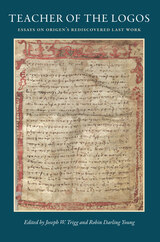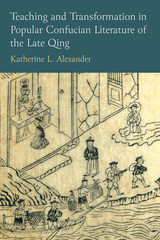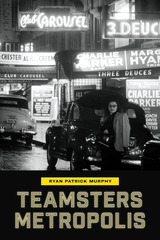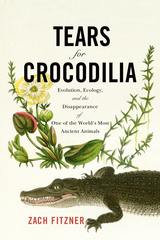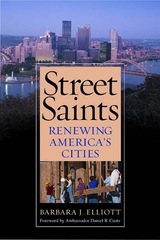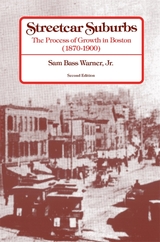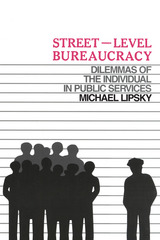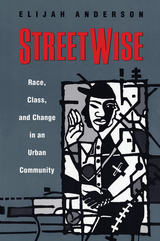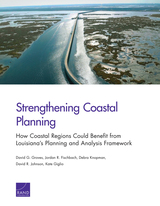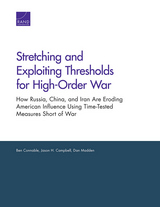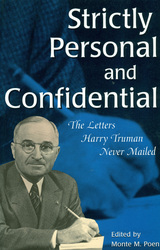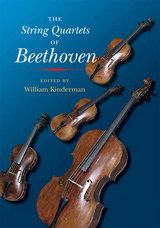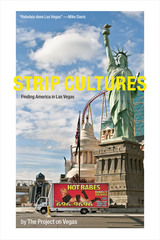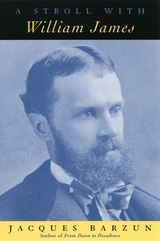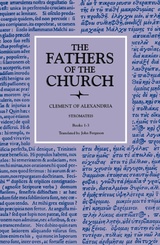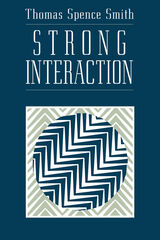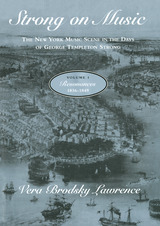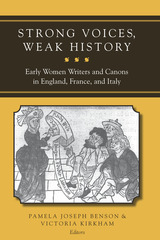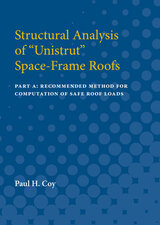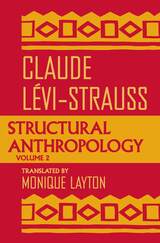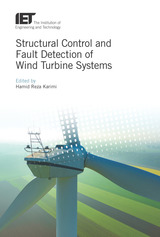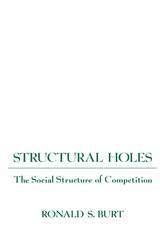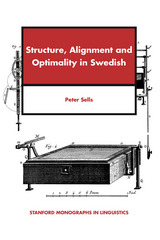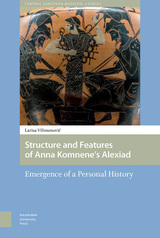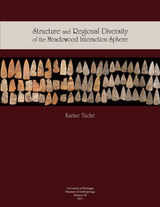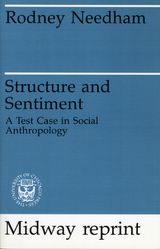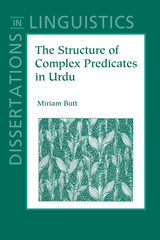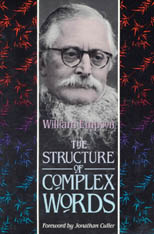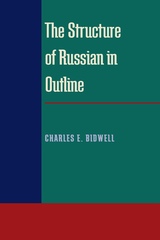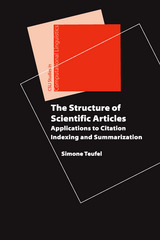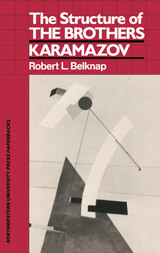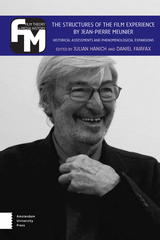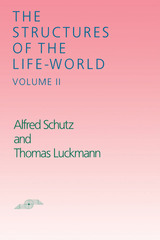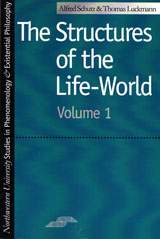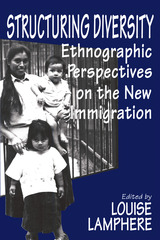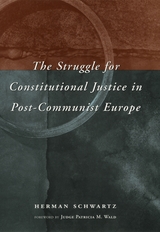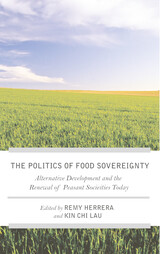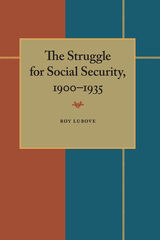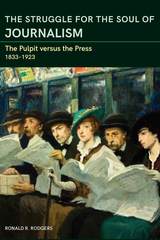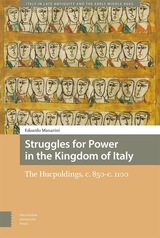Street Saints: Renewing American Cities
Barbara J. Elliott
Templeton Press, 2006 Based on eight years of hands-on experience and more than 300 interviews, Street Saints is both a book of motivational stories about unsung heroes and a sociological study of the "faith factor," documenting faith-based programs that are treating social maladies in America. This book takes readers on a tour of communities and institutions in America where faith-based initiatives are making a difference. It offers inspiration, role models, and guidelines for people who would like to give back to their own communities.
 Street Scenes: Brecht, Benjamin and Berlin
Nicolas Whybrow
Intellect Books, 2004 Always the focal point in modern times for momentous political, social and cultural upheaval, Berlin has continued, since the fall of the Wall in 1989, to be a city in transition. As the new capital of a reunified Germany it has embarked on a journey of rapid reconfiguration, involving issues of memory, nationhood and ownership.
Bertolt Brecht, meanwhile, stands as one of the principal thinkers about art and politics in the 20th century. The "Street Scene" model, which was the foundation for his theory of an epic theatre, relied precisely on establishing a connection between art's functioning and everyday life. His preoccupation with the ceaselessness of change, an impulse implying rupture and movement as the key characteristics informing the development of a democratic cultural identity, correlates resonantly with the notion of an ever-evolving city.
Premised on an understanding of performance as the articulation of movement in space, Street Scenes interrogates what kind of "life" is permitted to "flow" in the "new Berlin." Central to this method is the flaneur figure, a walker of streets who provides detached observations on the revealing "detritus of modern urban existence." Walter Benjamin, himself a native of Berlin as well as friend and seminal critic of Brecht, exercised the practice in exemplary form in his portrait of the city One-Way Street.
Street Scenes offers various points of entry for the reader, including those interested in: theatre, performance, visual art, architecture, theories of everyday life and culture, and the politics of identity. Ultimately, it is an interdisciplinary book, which strives to establish the 'porosity' of areas of theory and practice rather than hard boundaries.
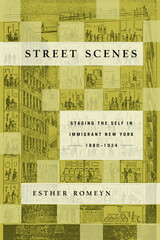 Street Scenes: Staging the Self in Immigrant New York, 1880–1924
Esther Romeyn
University of Minnesota Press, 2008 The turn of the twentieth century in New York City was characterized by radical transformation as the advent of consumer capitalism confronted established social hierarchies, culture, and conceptions of selfhood. The popular stage existed in a symbiotic relationship with the city and uniquely captured the contested terms of immigrant identity of the time.
Street Scenes focuses on the intersection of modern city life and stage performance. From street life and slumming to vaudeville and early cinema, to Yiddish theater and blackface comedy, Esther Romeyn discloses racial comedy, passing, and masquerade as gestures of cultural translation. In these performances she detects an obsession with the idea of the city as theater and the self as actor, which was fueled by the challenges that consumer capitalism presented to notions of an “authentic” self.
It was exactly this idea of “authentic” immigrant selfhood that was at stake in many performances on the popular stage, and Romeyn ultimately demonstrates how these diverse and potent immigrant works influenced the emergence of a modern metropolitan culture.
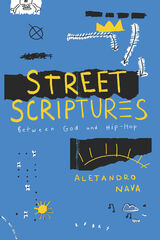 Street Scriptures: Between God and Hip-Hop
Alejandro Nava
University of Chicago Press, 2022 This book explores an important aspect of hip-hop that is rarely considered: its deep entanglement with spiritual life.
The world of hip-hop is saturated with religion, but rarely is that element given serious consideration. In Street Scriptures, Alejandro Nava focuses our attention on this aspect of the music and culture in a fresh way, combining his profound love of hip-hop, his passion for racial and social justice, and his deep theological knowledge. Street Scriptures offers a refreshingly earnest and beautifully written journey through hip-hop’s deep entanglement with the sacred.
Nava reveals a largely unheard religious heartbeat in hip-hop, exploring crosscurrents of the sacred and profane in rap, reggaeton, and Latinx hip-hop today. Ranging from Kendrick Lamar, Chance the Rapper, Lauryn Hill, Cardi B, and Bad Bunny to St. Augustine and William James, Nava examines the ethical-political, mystical-prophetic, and theological qualities in hip-hop, probing the pure sonic and aesthetic signatures of music, while also diving deep into the voices that invoke the spirit of protest. The result is nothing short of a new liberation theology for our time, what Nava calls a “street theology.”
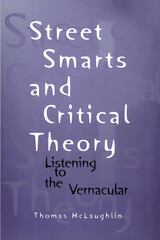 Street Smarts and Critical Theory: Listening to the Vernacular
Thomas McLaughlin
University of Wisconsin Press, 1996 Everybody’s got a theory . . . or do they?
Thomas McLaughlin argues that critical theory—raising serious, sustained questions about cultural practice and ideology—is practiced not only by an academic elite but also by savvy viewers of sitcoms and TV news, by Elvis fans and Trekkies, by labor organizers and school teachers, by the average person in the street.
Like academic theorists, who are trained in a tradition of philosophical and political skepticism that challenges all orthodoxies, the vernacular theorists McLaughlin identifies display a lively and healthy alertness to contradiction and propaganda. They are not passive victims of ideology but active questioners of the belief systems that have power over their lives. Their theoretical work arises from the circumstances they confront on the job, in the family, in popular culture. And their questioning of established institutions, McLaughlin contends, is essential and healthy, for it energizes other theorists who clarify the purpose and strategies of institutions and justify the existence of cultural practices.
Street Smarts and Critical Theory leads us through eye-opening explorations of social activism in the Southern Christian anti-pornography movement, fan critiques in the ‘zine scene, New Age narratives of healing and transformation, the methodical manipulations of the advertising profession, and vernacular theory in the whole-language movement. Emphasizing that theory is itself a pervasive cultural practice, McLaughlin calls on academic institutions to recognize and develop the theoretical strategies that students bring into the classroom.
“This book demystifies the idea of theory, taking it out of the hands of a priestly caste and showing it as the democratic endowment of the people.”—Daniel T. O’Hara, Temple University, author of Radical Parody: American Culture and Critical Agency after Foucault and Lionel Trilling: The Work of Liberation.
“McLaughlin takes seriously the critical and theoretical activity of everyday people and does so in a way that will empower these very populations to take seriously their own activities as theorists. . . . A manifesto that is sure to be heard by the younger generation of thinkers in American cultural studies.”—Henry Jenkins, MIT, author of Textual Poachers: Television Fans and Participatory Culture
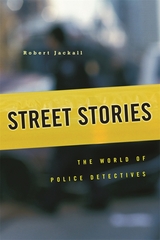 Street Stories: The World of Police Detectives
Robert Jackall
Harvard University Press, 2009 Detectives work the streets--an arena of action, vice, lust, greed, aggression, and violence--to gather shards of information about who did what to whom. They also work the cumbersome machinery of the justice system--semi-military police hierarchies with their endless jockeying for prestige, procedure-driven district attorney offices, and backlogged courts--transforming hard-won street knowledge into public narratives of responsibility for crime. Street Stories, based on years of fieldwork with the New York City Police Department and the District Attorney of New York, examines the moral ambiguities of the detectives' world as they shuttle between the streets and a bureaucratic behemoth.
In piecing together street stories to solve intriguing puzzles of agency and motive, detectives crisscross the checkerboard of urban life. Their interactions in social strata high and low foster cosmopolitan habits of mind and easy conversational skills. And they become incomparable storytellers. This book brims with the truth-is-stranger-than-fiction violence of the underworld and tells about a justice apparatus that splinters knowledge, reduces life-and-death issues to arcane hair-splitting, and makes rationality a bedfellow of absurdity.
Detectives' stories lay bare their occupational consciousness--the cunning and trickery of their investigative craft, their self-images, moral rules-in-use, and judgments about the players in their world--as well as their personal ambitions, sensibilities, resentments, hopes, and fears. When detectives do make cases, they take satisfaction in removing predators from the streets and helping to ensure public safety. But their stories also illuminate dark corners of a troubled social order.
 Street Therapists: Race, Affect, and Neoliberal Personhood in Latino Newark
Ana Y. Ramos-Zayas
University of Chicago Press, 2012 Drawing from almost a decade of ethnographic research in largely Brazilian and Puerto Rican neighborhoods in Newark, New Jersey, Ana Y. Ramos-Zayas, in Street Therapists,examines how affect, emotion, and sentiment serve as waypoints for the navigation of interracial relationships among US-born Latinos, Latin American migrants, blacks, and white ethnics. Tackling a rarely studied dynamic approach to affect, Ramos-Zayas offers a thorough—and sometimes paradoxical—new articulation of race, space, and neoliberalism in US urban communities.
After looking at the historical, political, and economic contexts in which an intensified connection between affect and race has emerged in Newark, New Jersey, Street Therapists engages in detailed examinations of various community sites—including high schools, workplaces, beauty salons, and funeral homes, among others—and secondary sites in Belo Horizonte, Brazil and San Juan to uncover the ways US-born Latinos and Latin American migrants interpret and analyze everyday racial encounters through a language of psychology and emotions. As Ramos-Zayas notes, this emotive approach to race resurrects Latin American and Caribbean ideologies of “racial democracy” in an urban US context—and often leads to new psychological stereotypes and forms of social exclusion. Extensively researched and thoughtfully argued, Street Therapists theorizes the conflictive connection between race, affect, and urban neoliberalism.
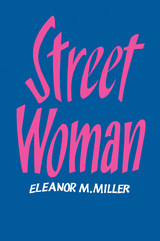 Street Woman
Eleanor Miller
Temple University Press, 1987 Distinguished Scholar Award, American Sociological Association Criminology Section, 1987
"Miller's firsthand report of female offenders documents a picture of contemporary female criminality.... Street Woman is field research at its best. The reader will be angered and disturbed, enlightened and absorbed."
--Darrell J. Steffenmeier
In this rich, well-written study, Eleanor Miller analyzes the social organization of street hustling and the lives of the women involved in it. Miller views hustling as "illegal work": prostitution, fraud, forgery, embezzlement, and larceny. Using information garnered from life histories and interviews with 64 female street hustlers in Milwaukee, she vividly describes a female underclass recruited to the world of the street for a substantial period of their lives.
Street Woman offers a challenging alternative to recent sociological studies that view the "women's movement" as directly linked to the increasing participation of women in property crime. Miller shows that this increase in crime is a response to sustained poverty. Thus, many sociologists are out of touch with the typical female criminal in this country on both a demographic and personal level. "Typical" female hustlers, as their own words poignantly reveal, are young, poor minority women who have limited education and skills and who also have several children of their own. They adopt characteristic interpersonal relationships and familial forms that insure their survival but which leave the youngsters at greater risk of being recruited to street life.
Street Woman is a work of great importance to sociologists and criminologists alike, both in its ramifications for public policy and its explicit implications for further research. Most important, Miller's desire to render a more personal portrait, to enable us to "at least recognize the individual in the picture painted of the group," leaves the reader with haunting portrayals of the women who struggle to survive in the violent, desperate, drug-ridden world of the street.
"This book deserves a large audience for it provides convincing detail on the recruitment of women to this kind of demi monde and spells out for us a far more persuasive social process than that anticipated in more abstract models. Like the best of our ethnographics research it provides both a refinement of existing theory and a descriptive document that can outlast existing theory."
--Gerald D. Suttles, University of Chicago
Streetcar Suburbs: The Process of Growth in Boston, 1870–1900, Second Edition
Sam Bass Warner Jr.
Harvard University Press, 1978 In the last third of the nineteenth century Boston grew from a crowded merchant town, in which nearly everybody walked to work, to the modern divided metropolis. The street railway created this division of the metropolis into an inner city of commerce and slums and an outer city of commuters’ suburbs. Streetcar Suburbs tells who built the new city, and why, and how.
Included here is a new Introduction that considers the present suburb/city dichotomy and suggests what we can learn from it to assure a livable city of the future.
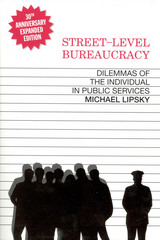 Street-Level Bureaucracy, 30th Anniversary Edition: Dilemmas of the Individual in Public Service
Michael Lipsky
Russell Sage Foundation, 2010 First published in 1980, Street-Level Bureaucracy received critical acclaim for its insightful study of how public service workers, in effect, function as policy decision makers, as they wield their considerable discretion in the day-to-day implementation of public programs. Three decades later, the need to bolster the availability and effectiveness of healthcare, social services, education, and law enforcement is as urgent as ever. In this thirtieth anniversary expanded edition, Michael Lipsky revisits the territory he mapped out in the first edition to reflect on significant policy developments over the last several decades. Despite the difficulties of managing these front-line workers, he shows how street-level bureaucracies can be and regularly are brought into line with public purposes. Street-level bureaucrats—from teachers and police officers to social workers and legal-aid lawyers—interact directly with the public and so represent the frontlines of government policy. In Street-Level Bureaucracy, Lipsky argues that these relatively low-level public service employees labor under huge caseloads, ambiguous agency goals, and inadequate resources. When combined with substantial discretionary authority and the requirement to interpret policy on a case-by-case basis, the difference between government policy in theory and policy in practice can be substantial and troubling. The core dilemma of street-level bureaucrats is that they are supposed to help people or make decisions about them on the basis of individual cases, yet the structure of their jobs makes this impossible. Instead, they are forced to adopt practices such as rationing resources, screening applicants for qualities their organizations favor, "rubberstamping" applications, and routinizing client interactions by imposing the uniformities of mass processing on situations requiring human responsiveness. Occasionally, such strategies work out in favor of the client. But the cumulative effect of street-level decisions made on the basis of routines and simplifications about clients can reroute the intended direction of policy, undermining citizens' expectations of evenhanded treatment. This seminal, award-winning study tells a cautionary tale of how decisions made by overburdened workers translate into ad-hoc policy adaptations that impact peoples' lives and life opportunities. Lipsky maintains, however, that these problems are not insurmountable. Over the years, public managers have developed ways to bring street-level performance more in line with agency goals. This expanded edition of Street-Level Bureaucracy underscores that, despite its challenging nature, street-level work can be made to conform to higher expectations of public service.
 Street-Level Leadership: Discretion and Legitimacy in Front-Line Public Service
Janet Coble Vinzant and Lane Crothers
Georgetown University Press, 1998 Examining public service from the perspective of the worker, this book provides a new framework for understanding the roles and responsibilities of front-line public servants and assessing the appropriateness of their actions. Public employees who work at street level face some of the most intractable, pervasive, and complex problems in contemporary society. Drawing on more than 1500 hours of observation of police officers and social service workers in four states, this book explores the types of situations they confront, the factors they consider, and the hard choices they make. Presenting numerous cases of how these individuals acted in various situations, the authors show how public servants translate the expectations of administrators and others into legitimate street-level action. Vinzant and Crothers propose the concept of leadership as a positive and realistic framework for understanding what these public servants do and how they can successfully meet the daily challenges of their very difficult and complex jobs. They show how changing the theory and language we use to describe street-level work can encourage decisions that are responsive both to the needs of the clients being served and to the broader community's need for accountability. They also examine how street-level leadership can change the way agencies recruit, train, and manage these employees and how society defines their role in governance. This book offers valuable insights for those working in or studying public administration, policy analysis, criminal justice, and social work.
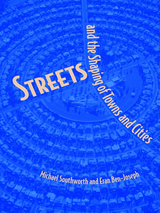 Streets and the Shaping of Towns and Cities
Michael Southworth and Eran Ben-Joseph
Island Press, 2003 The topic of streets and street design is of compelling interest today as public officials, developers, and community activists seek to reshape urban patterns to achieve more sustainable forms of growth and development. Streets and the Shaping of Towns and Cities traces ideas about street design and layout back to the early industrial era in London suburbs and then on through their institutionalization in housing and transportation planning in the United States. It critiques the situation we are in and suggests some ways out that are less rigidly controlled, more flexible, and responsive to local conditions. Originally published in 1997, this edition includes a new introduction that addresses topics of current interest including revised standards from the Institute of Transportation Engineers; changes in city plans and development standards following New Urbanist, Smart Growth, and sustainability principles; traffic calming; and ecologically oriented street design.
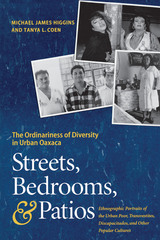 Streets, Bedrooms, and Patios: The Ordinariness of Diversity in Urban Oaxaca
By Michael James Higgins and Tanya L. Coen
University of Texas Press, 2000 Diversity characterizes the people of Oaxaca, Mexico. Within this city of half a million, residents are rising against traditional barriers of race and class, defining new gender roles, and expanding access for the disabled. In this rich ethnography of the city, Michael Higgins and Tanya Coen explore how these activities fit into the ordinary daily lives of the people of Oaxaca. Higgins and Coen focus their attention on groups that are often marginalized—the urban poor, transvestite and female prostitutes, discapacitados (the physically challenged), gays and lesbians, and artists and intellectuals. Blending portraits of and comments by group members with their own ethnographic observations, the authors reveal how such issues as racism, sexism, sexuality, spirituality, and class struggle play out in the people's daily lives and in grassroots political activism. By doing so, they translate the abstract concepts of social action and identity formation into the actual lived experiences of real people.
Streets of Crocodiles: Photography, Media, and Postsocialist Landscapes in Poland
Photographs by Kamil Turowski, Introduction by J. Hoberman, Essays by Katarzyna Marciniak
Intellect Books, 2011 This powerful presentation of photographs of Poland from the late 1980s to the present depicts the hybridized landscape of this pivotal Eastern European nation following its entry into the European Union. A visual record of the country's transition from socialism to capitalism, it focuses on the industrial blue-collar city ofLodz—located in the heart of New Europe and home to nearly one million people. Photographer Kamil Turowski's monotones are captivating—seeming to conceal a looming threat—while Katarzyna Marciniak's accompanying text expands on the photos and the "crocodilian" texture of contemporary Eastern Europe. A walk on the wild side, Streets of Crocodiles captures viscerally the changing landscape of postsocialist Poland.
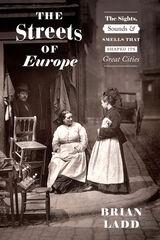 The Streets of Europe: The Sights, Sounds, and Smells That Shaped Its Great Cities
Brian Ladd
University of Chicago Press, 2020 A multi-sensory urban history of Europe’s bustling streets.
Merchants’ shouts, jostling strangers, aromas of fresh fish and flowers, plodding horses, and friendly chatter long filled the narrow, crowded streets of the European city. As they developed over many centuries, these spaces of commerce, communion, and commuting framed daily life. At its heyday in the 1800s, the European street was the place where social worlds connected and collided.
Brian Ladd recounts a rich social and cultural history of the European city street, tracing its transformation from a lively scene of trade and crowds into a thoroughfare for high-speed transportation. Looking closely at four major cities—London, Paris, Berlin, and Vienna—Ladd uncovers both the joys and the struggles of a past world. The story takes us up to the twentieth century, when the life of the street was transformed as wealthier citizens withdrew from the crowds to seek refuge in suburbs and automobiles. As demographics and technologies changed, so did the structure of cities and the design of streets, significantly shifting our relationships to them. In today’s world of high-speed transportation and impersonal marketplaces, Ladd leads us to consider how we might draw on our history to once again build streets that encourage us to linger.
By unearthing the vivid descriptions recorded by amused and outraged contemporaries, Ladd reveals the changing nature of city life, showing why streets matter and how they can contribute to public life.
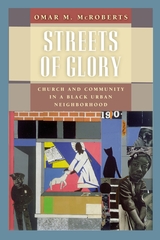 Streets of Glory: Church and Community in a Black Urban Neighborhood
Omar M. McRoberts
University of Chicago Press, 2003 Long considered the lifeblood of urban African American neighborhoods, churches are held up as institutions dedicated to serving their surrounding communities. Omar McRoberts's work in Four Corners, however, reveals a very different picture. One of the toughest neighborhoods in Boston, Four Corners also contains twenty-nine churches, mostly storefront congregations, within its square half-mile radius. In McRoberts's hands, this area teaches a startling lesson about the relationship between congregations and neighborhoods that will be of interest to everyone concerned with the revitalization of the inner city.
McRoberts finds, for example, that most of the churches in Four Corners are attended and run by people who do not live in the neighborhood but who worship there because of the low overhead. These churches, McRoberts argues, are communities in and of themselves, with little or no attachment to the surrounding area. This disconnect makes the churches less inclined to cooperate with neighborhood revitalization campaigns and less likely to respond to the immediate needs of neighborhood residents. Thus, the faith invested in inner-city churches as beacons of local renewal might be misplaced, and the decision to count on them to administer welfare definitely should be revisited.
As the federal government increasingly moves toward delivering social services through faith-based organizations, Streets of Glory must be read for its trenchant revisionist view of how churches actually work in depressed urban areas.
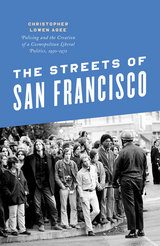 The Streets of San Francisco: Policing and the Creation of a Cosmopolitan Liberal Politics, 1950-1972
Christopher Lowen Agee
University of Chicago Press, 2014 During the Sixties the nation turned its eyes to San Francisco as the city's police force clashed with movements for free speech, civil rights, and sexual liberation. These conflicts on the street forced Americans to reconsider the role of the police officer in a democracy. In The Streets of San Francisco Christopher Lowen Agee explores the surprising and influential ways in which San Francisco liberals answered that question, ultimately turning to the police as partners, and reshaping understandings of crime, policing, and democracy.
The Streets of San Francisco uncovers the seldom reported, street-level interactions between police officers and San Francisco residents and finds that police discretion was the defining feature of mid-century law enforcement. Postwar police officers enjoyed great autonomy when dealing with North Beach beats, African American gang leaders, gay and lesbian bar owners, Haight-Ashbury hippies, artists who created sexually explicit works, Chinese American entrepreneurs, and a wide range of other San Franciscans. Unexpectedly, this police independence grew into a source of both concern and inspiration for the thousands of young professionals streaming into the city's growing financial district. These young professionals ultimately used the issue of police discretion to forge a new cosmopolitan liberal coalition that incorporated both marginalized San Franciscans and rank-and-file police officers. The success of this model in San Francisco resulted in the rise of cosmopolitan liberal coalitions throughout the country, and today, liberal cities across America ground themselves in similar understandings of democracy, emphasizing both broad diversity and strong policing.
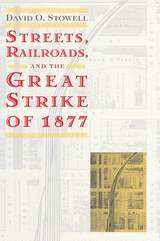 Streets, Railroads, and the Great Strike of 1877
David O. Stowell
University of Chicago Press, 1999 For one week in late July of 1877, America shook with anger and fear as a variety of urban residents, mostly working class, attacked railroad property in dozens of towns and cities. The Great Strike of 1877 was one of the largest and most violent urban uprisings in American history.
Whereas most historians treat the event solely as a massive labor strike that targeted the railroads, David O. Stowell examines America's predicament more broadly to uncover the roots of this rebellion. He studies the urban origins of the Strike in three upstate New York cities—Buffalo, Albany, and Syracuse. He finds that locomotives rumbled through crowded urban spaces, sending panicked horses and their wagons careening through streets. Hundreds of people were killed and injured with appalling regularity. The trains also disrupted street traffic and obstructed certain forms of commerce. For these reasons, Stowell argues, The Great Strike was not simply an uprising fueled by disgruntled workers. Rather, it was a grave reflection of one of the most direct and damaging ways many people experienced the Industrial Revolution.
"Through meticulously crafted case studies . . . the author advances the thesis that the strike had urban roots, that in substantial part it represented a community uprising. . . .A particular strength of the book is Stowell's description of the horrendous accidents, the toll in human life, and the continual disruption of craft, business, and ordinary movement engendered by building railroads into the heart of cities."—Charles N. Glaab, American Historical Review
 Streetwalking: LGBTQ Lives and Protest in the Dominican Republic
Ana-Maurine Lara
Rutgers University Press, 2021 Honorable Mention, Isis Duarte Book Prize (Latin American Studies Association)
Streetwalking: LGBTQ Lives and Protest in the Dominican Republic is an exploration of the ways that lesbian, gay, bisexual, trans and queer persons exercise power in a Catholic Hispanic heteropatriarchal nation-state, namely the Dominican Republic. Lara presents the specific strategies employed by LGBTQ community leaders in the Dominican Republic in their struggle for subjectivity, recognition, and rights. Drawing on ethnographic encounters, film and video, and interviews, LGBTQ community leaders teach readers about streetwalking, confrontación, flipping the script, cuentos, and the use of strategic universalisms in the exercise of power and agency. Rooted in Maria Lugones's theorization of streetwalker strategies and Audre Lorde's theorization of silence and action, this text re-imagines the exercise and locus of power in examples provided by the living, thriving LGBTQ community of the Dominican Republic.
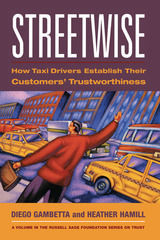 Streetwise: How Taxi Drivers Establish Customer's Trustworthiness
Diego Gambetta
Russell Sage Foundation, 2005 A taxi driver's life is dangerous work. Picking up a bad customer can leave the driver in a vulnerable position, and erring even once can prove fatal. To protect themselves, taxi drivers must quickly and accurately assess the trustworthiness of complete strangers. In Streetwise, Diego Gambetta and Heather Hamill take this predicament as a prototypical example of many trust decisions, where people must act on limited information and judge another person's trustworthiness based on signs that may or may not be honest indicators of that person's character or intent. Gambetta and Hamill analyze the behavior of cabbies in two cities where driving a taxi is especially perilous: New York City, where drivers have been the targets of frequent and violent robberies, and Belfast, Northern Ireland, a divided metropolis where drivers have been swept up in the region's sectarian violence. Based on in-depth ethnographic research, Streetwise lets drivers describe in their own words how they seek to determine the threat posed by each potential passenger. The drivers' decisions about whom to trust are treated in conjunction with the "sign-management" strategies of their prospective passengers—both genuine passengers who try to persuade drivers of their trustworthiness and the villains who mimic them. As the theory that guides this research suggests, drivers look for signs that correlate closely with trustworthiness but are difficult for an impostor to mimic. A smile, a business suit, or a skullcap alone do not reassure drivers, as any criminal could easily wear them. Only if attached to other signs—a middle-aged woman, a business address, or a synagogue—are they persuasive. Drivers are adept at deciphering deceitful signals, but trickery is occasionally undetectable, so they must adopt defensive strategies to minimize their exposure to harm. In Belfast, where drivers are locals and often have histories of paramilitary involvement, "macho" posturing often serves to deter would-be criminals, while New York cabbies, mostly immigrants who view themselves as outsiders, try simply to minimize the damage from attacks by appeasing robbers and carrying only small amounts of cash. For most people, erring in a trust decision leads to a broken heart or a few dollars lost. For cab drivers, such an error could mean losing their lives. The way drivers negotiate these high stakes offers us vivid insight into how to determine another person's trustworthiness. Written with clarity and color, Streetwise invites the reader to ride shotgun with cabbies as they grapple with a question of relevance to us all: which signs of trustworthiness can we really trust? A Volume in the Russell Sage Foundation Series on Trust
Streetwise: Race, Class, and Change in an Urban Community
Elijah Anderson
University of Chicago Press, 1990 In a powerful, revealing portrait of city life, Anderson explores the dilemma of both blacks and whites, the underclass and the middle class, caught up in the new struggle not only for common ground—prime real estate in a racially changing neighborhood—but for shared moral community. Blacks and whites from a variety of backgrounds speak candidly about their lives, their differences, and their battle for viable communities.
"The sharpness of his observations and the simple clarity of his prose recommend his book far beyond an academic audience. Vivid, unflinching, finely observed, Streetwise is a powerful and intensely frightening picture of the inner city."—Tamar Jacoby, New York Times Book Review
"The book is without peer in the urban sociology literature. . . . A first-rate piece of social science, and a very good read."—Glenn C. Loury, Washington Times
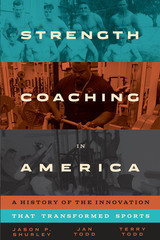 Strength Coaching in America: A History of the Innovation That Transformed Sports
By Jason P. Shurley, Jan Todd, and Terry Todd
University of Texas Press, 2019 Shortlisted for the North American Society for Sports History 2020 Monograph Prize
It’s hard to imagine, but as late as the 1950s, athletes could get kicked off a team if they were caught lifting weights. Coaches had long believed that strength training would slow down a player. Muscle was perceived as a bulky burden; training emphasized speed and strategy, not “brute” strength. Fast forward to today: the highest-paid strength and conditioning coaches can now earn $700,000 a year. Strength Coaching in America delivers the fascinating history behind this revolutionary shift. College football represents a key turning point in this story, and the authors provide vivid details of strength training’s impact on the gridiron, most significantly when University of Nebraska football coach Bob Devaney hired Boyd Epley as a strength coach in 1969. National championships for the Huskers soon followed, leading Epley to launch the game-changing National Strength Coaches Association. Dozens of other influences are explored with equal verve, from the iconic Milo Barbell Company to the wildly popular fitness magazines that challenged physicians’ warnings against strenuous exercise. Charting the rise of a new athletic profession, Strength Coaching in America captures an important transformation in the culture of American sport.
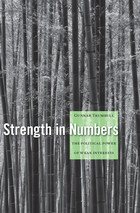 Strength in Numbers: The Political Power of Weak Interests
Gunnar Trumbull
Harvard University Press, 2012 Many consumers feel powerless in the face of big industry’s interests. And the dominant view of economic regulators (influenced by Mancur Olson’s book The Logic of Collective Action, published in 1965) agrees with them. According to this view, diffuse interests like those of consumers are too difficult to organize and too weak to influence public policy, which is determined by the concentrated interests of industrial-strength players. Gunnar Trumbull makes the case that this view represents a misreading of both the historical record and the core logic of interest representation. Weak interests, he reveals, quite often emerge the victors in policy battles.
Based on a cross-national set of empirical case studies focused on the consumer, retail, credit, pharmaceutical, and agricultural sectors, Strength in Numbers develops an alternative model of interest representation. The central challenge in influencing public policy, Trumbull argues, is not organization but legitimation. How do diffuse consumer groups convince legislators that their aims are more legitimate than industry’s? By forging unlikely alliances among the main actors in the process: activists, industry, and regulators. Trumbull explains how these “legitimacy coalitions” form around narratives that tie their agenda to a broader public interest, such as expanded access to goods or protection against harm. Successful legitimizing tactics explain why industry has been less powerful than is commonly thought in shaping agricultural policy in Europe and pharmaceutical policy in the United States. In both instances, weak interests carried the day.
 Strength in Unity
Brad H. Wright
University of Alabama Press, 2026 Examines how poor and working-class communities in Guadalajara organized through faith, education, and culture to claim dignity, justice, and the right to the city. Strength in Unity: Christian Base Communities and the Urban Popular Movement in Guadalajara, 1965–1994 presents the grassroots history of Guadalajara’s urban popular movement, centering the voices and struggles of poor and working-class communities, especially women, who organized for dignity, justice, and the right to the city. Brad H. Wright brings to light the transformative role of Christian base communities and Freirean popular education as incubators of political consciousness and collective action in the face of authoritarian repression and neoliberal coaptation. Drawing from oral histories, personal archives, and the records of the Sagrado Corazón nuns, Wright reconstructs a powerful counternarrative to dominant portrayals of marginalized populations as “apathetic” and “uneducated.” Strength in Unity reveals a vibrant culture of resistance where women led campaigns for basic services, built schools, and demanded access to transportation, using tools such as community newspapers, street theater, and music to mobilize and sustain solidarity. This deeply researched and compellingly told history challenges conventional accounts of urban development and social movements in Latin America. Strength in Unity is essential reading for scholars, students, and activists interested in grassroots organizing, liberation theology, and the enduring power of community-led change.
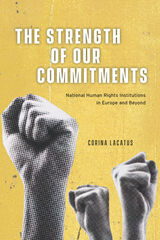 The Strength of Our Commitments: National Human Rights Institutions in Europe and Beyond
Corina Lacatus
University of Chicago Press, 2024 A deep dive into the mechanics of national human rights institutions and the forces that make or break their success. In the years since World War II, the endeavor to promote human rights has gained momentum and become increasingly important within international relations. Yet these efforts often run into serious problems of enforcement. Many countries formed national human rights institutions (NHRIs) with independent mandates to support and monitor government compliance with international human rights law. Be they commissions, ombudsmen, or tribunals, these institutions vary in their power and impact. For this book, Corina Lacatus surveyed NHRIs in Europe and around the world to determine their effectiveness and explain why some succeed while others fail. The Strength of Our Commitments explores the relationship between the domestic and international support an institution receives and its ability to secure resources, credibility, and tangibly improve human rights conditions. Lacatus shows that NHRIs can be models of resilience, even in the face of opposition from political elites. Although their impact on human rights is difficult to measure, The Strength of Our Commitments shows how NHRIs’ strength comes from clearly defined formal powers, strong institutional leadership, and independence from political interference.
 Strength through Diversity: Harlem Prep and the Rise of Multiculturalism
Barry M. Goldenberg
Rutgers University Press, 2025 For nearly seven years, from 1967 to 1974, many hundreds of bright, college-going youth—most of whom had previously been labeled as high school “dropouts”—would proudly celebrate their graduation from Harlem Prep, a small educational experiment that grew to become a nationally renowned, cherished community institution in the iconic Black neighborhood of Harlem. Operating in a repurposed supermarket that used blackboards as classroom dividers, the school’s unique multicultural philosophy inspired all who stepped foot inside. This philosophy, exemplified by the school’s motto of “unity through diversity,” shaped the school’s ethos, fostered student achievement, and, most of all, made Harlem Prep distinct from any other educational institution, past or present. In Strength through Diversity, Barry M. Goldenberg shares the history of this one-of-a-kind multicultural institution from its rise to its apex and decline, revealing the collective stories of hope, struggle, and love from administrators, teachers, community members, and students. Using history as a blueprint, Goldenberg illustrates the untapped potential of multicultural education in the ongoing quest for educational equity. strengththroughdiversity.com
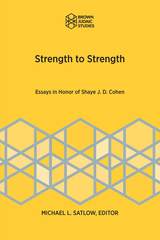 Strength to Strength: Essays in Honor of Shaye J. D. Cohen
Michael L. Satlow
SBL Press, 2018 Essays that engage the scholarship of Shaye J. D. Cohen
The essays in Strength to Strength honor Shaye J. D. Cohen across a range of ancient to modern topics. The essays seek to create an ongoing conversation on issues of identity, cultural interchange, and Jewish literature and history in antiquity, all areas of particular interest for Cohen. Contributors include: Moshe J. Bernstein, Daniel Boyarin, Jonathan Cohen, Yaakov Elman, Ari Finkelstein, Charlotte Elisheva Fonrobert, Steven D. Fraade, Isaiah M. Gafni, Gregg E. Gardner, William K. Gilders, Martin Goodman, Leonard Gordon, Edward L. Greenstein, Erich S. Gruen, Judith Hauptman, Jan Willem van Henten, Catherine Hezser, Tal Ilan, Richard Kalmin, Yishai Kiel, Ross S. Kraemer, Hayim Lapin, Lee I. Levine, Timothy H. Lim, Duncan E. MacRae, Ivan Marcus, Mahnaz Moazami, Rachel Neis, Saul M. Olyan, Jonathan J. Price, Jeffrey L. Rubenstein, Michael L. Satlow, Lawrence H. Schiffman, Daniel R. Schwartz, Joshua Schwartz, Karen Stern, Stanley Stowers, and Burton L. Visotzky.
Features:
- A full bibliography of Cohen’s published works
- An essay on the contributions of Cohen
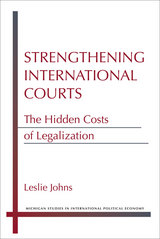 Strengthening International Courts: The Hidden Costs of Legalization
Leslie Johns
University of Michigan Press, 2015 As all manner of commerce becomes increasingly global, states must establish laws to protect property rights, human rights, and national security. In many cases, states delegate authority to resolve disputes regarding these laws to an independent court, whose power depends upon its ability to enforce its rulings. Examining detailed case studies of the International Court of Justice and the transition from the General Agreement on Tariffs and Trade to the World Trade Organization, Leslie Johns finds that a court’s design has nuanced and mixed effects on international cooperation. A strong court is ideal when laws are precise and the court is nested within a political structure like the European Union. Strong courts encourage litigation but make states more likely to comply with agreements when compliance is easy and withdraw from agreements when it is difficult. A weak court is optimal when law is imprecise and states can easily exit agreements with minimal political or economic repercussions. Johns concludes the book with recommendations for promoting cooperation by creating more precise international laws and increasing both delegation and obligation to international courts.
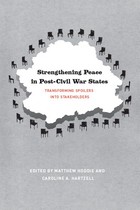 Strengthening Peace in Post-Civil War States: Transforming Spoilers into Stakeholders
Edited by Matthew Hoddie and Caroline A. Hartzell
University of Chicago Press, 2010 Among the more frequent and most devastating of conflicts, civil wars—from Yugoslavia to Congo—frequently reignite and even spill over into the international sphere. Given the inherent fragility of civil war peace agreements, innovative approaches must be taken to ensure the successful resolution of these conflicts. Strengthening Peace in Post–Civil War States provides both analytical frameworks and a series of critical case studies demonstrating the effectiveness of a range of strategies for keeping the peace.
Coeditors Matthew Hoddie and Caroline A. Hartzell here contend that lasting peace relies on aligning the self-interest of individuals and communities with the society-wide goal of ending war; if citizens and groups have a stake in peace, they will seek to maintain and defend it. The rest of the contributors explore two complementary approaches toward achieving this goal: restructuring domestic institutions and soft intervention. Some essays examine the first tactic, which involves reforming governments that failed to prevent war, while others discuss the second, an umbrella term for a number of non-military strategies for outside actors to assist in keeping the peace.
 Strengthening Young Bodies, Building the Nation: A Social History of the Child Health and Welfare in Greece (1890–1940)
Vassiliki Theodorou
Central European University Press, 2019 Stimulated by the development of childhood studies and the social history of medicine, this book lays out the historical circumstances that led to the medicalization of childhood in Greece from the end of the nineteenth century until World War Two. For this span of fifty years, the authors explore how the national question was bound up with concerns raised about the health of children. They also investigate the various connotations of child health and maternity care in the context of liberal and authoritarian governments, as well as the wider social and cultural changes that took place in this period. Drawing on a wide array of primary and secondary sources, the authors look into the role of doctors, social thinkers and civil servants in the shaping of health policy; the impact of the medical paradigm from Western Europe; and the gradual professionalization of health care in Greece. Theodorou and Karakatsani describe an increasing intervention of the state in the medical supervision of childhood, the relationship between the philanthropic organizations and the state, as well as the impact of the national rivalries and wars on efforts to improve child health.
 Strī: Women in Epic Mahābhārata
Kevin McGrath
Harvard University Press This book is a study of heroic femininity as it appears in the epic Mahābhārata, and focuses particularly on the roles of wife, daughter-in-law, and mother, on how these women speak and on the kinship groups and varying marital systems that surround them. It portrays those qualities that cohere about women in the poem, which are particular to them and which distinguish them as women, and describes how women heroes function as crucial speakers in the generation and maintenance of cultural value and worth. This includes men who have been transformed into women and women who have been reincarnated as men. The overall method accomplishes an ethnography of text, describing a special aspect of the bronze age preliterate and premonetary world as it is represented by the actions and metaphors of Mahābhārata. References to contemporary Indian cinema and popular culture support the narrative of the book, bringing modern valence to the arguments.
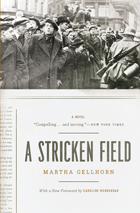 A Stricken Field: A Novel
Martha Gellhorn
University of Chicago Press, 2011 Martha Gellhorn was one of the first—and most widely read—female war correspondents of the twentieth century. She is best known for her fearless reporting in Europe before and during WWII and for her brief marriage to Ernest Hemingway, but she was also an acclaimed novelist. In 1938, before the Munich pact, Gellhorn visited Prague and witnessed its transformation from a proud democracy preparing to battle Hitler to a country occupied by the German army. Born out of this experience, A Stricken Field follows a journalist who returns to Prague after its annexation and finds her efforts to obtain help for the refugees and to convey the shocking state of the country both frustrating and futile. A convincing account of a people under the brutal oppression of the Gestapo, A Stricken Field is Gellhorn’s most powerful work of fiction. “[A] brave, final novel. Its writing is quick with movement and with sympathy; its people alive with death, if one can put it that way. It leaves one with aching heart and questing mind.”—New York Herald Tribune “The translation of [Gellhorn’s] personal testimony into the form of a novel has . . . force and point.”—Times Literary Supplement
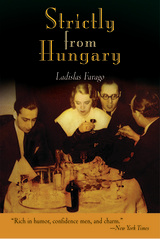 Strictly from Hungary
Ladislas Farago
Westholme Publishing, 2004 “Rich in humor, confidence men, and charm."—New York Times
Known for his best-selling military histories, Ladislas Farago also wrote a witty tribute to his homeland, Strictly from Hungary. Noting that Hungary has produced some of the world's most renowned artists, scientists, and financiers as well as its share of world-class con-artists, charlatans, and rakes, Farago sets out to explain just how one tiny country can be responsible for so much talent, both good and bad. Using stories from his days as a struggling writer in the bustling café scenes of Budapest and New York City, Farago demonstrates the Hungarian knack for remaining irrepressible and optimistic even in the face of catastrophe. Here we meet Zoltan, a fellow Bohemian who presents his astonished benefactor with a play "about nothing," a theme later made famous by another writer of Hungarian descent, Jerry Seinfeld. Farago also introduces us to "Baby Kiss," a vivacious Hungarian beauty queen, and the story of how she ended up in Fort Worth, Texas; Orkeny, a double agent for America at the height of the Cold War who "spiced up" his reports to keep everyone happy, and the author's own experience getting mustered into the supposedly non-existent Royal Hungarian Army. Farago's reminiscence validates what most Hungarians believe: that Hungary is the center of the world and that everyone has some connection to the land of the Magyars. In that spirit, Farago learns that George Washington himself was "strictly from Hungary." This edition is introduced by the author's son, who shows that the same vibrant spirit described by his father remains the hallmark of the Hungarian temperament.
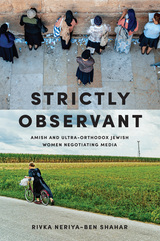 Strictly Observant: Amish and Ultra-Orthodox Jewish Women Negotiating Media
Rivka Neriya-Ben Shahar
Rutgers University Press, 2024 Yonathan Shapiro Best Book Award from the Association for Israel Studies
The Amish and ultra-Orthodox Jewish communities have typically been associated with strict religious observance, a renunciation of worldly things, and an obedience of women to men. Women’s relationship to media in these communities, however, betrays a more nuanced picture of the boundaries at play and women’s roles in negotiating them.
Strictly Observant presents a compelling ethnographic study of the complex dynamic between women in both the Pennsylvanian Old Order Amish and Israeli ultra-Orthodox Jewish communities and contemporary media technologies. These women regularly establish valuable social, cultural, and religious capital through the countless decisions for use and nonuse of media that they make in their daily lives, and in ways that challenge the gender hierarchies of each community. By exhibiting a deep awareness of how media can be managed to increase their social and religious reputations, these women prompt us to reconsider our outmoded understanding of the Amish and ultra-Orthodox Jewish communities, the role that women play in these communities as agents of change, and our own relationship to media today.
Strictly Personal and Confidential: The Letters Harry Truman Never Mailed
Edited by Monte M. Poen
University of Missouri Press, 1999 Harry S. Truman made plain speaking his trademark, and it was a common belief that "Give 'em hell" Harry spared few with his words. However, this fascinating collection of 140 amusing, angry, sarcastic, and controversial letters President Truman wrote but never mailed proves that conception wrong. Addressed to admirers and enemies alike, including Adlai Stevenson, Justice William Douglas, Dwight Eisenhower, Joe McCarthy, and Truman's wife, Bess, these intriguing letters cover such diverse subjects as the atomic bomb, running the country, and human greed.
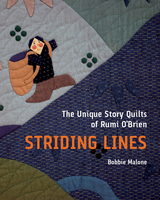 Striding Lines: The Unique Story Quilts of Rumi O'Brien
Bobbie Malone
University of Wisconsin Press, 2019 The gnarled branches of a beautiful old plum tree reach toward the sky. A mushroom hunter searches for morels among rolling hills. A small boat is tossed among the tumultuous waves of an angry sea. Striding Lines, an homage to Wisconsin artist and quilter Rumi O'Brien, presents these striking images of her work and many more, accompanied by descriptions that share the stories of each piece in the artist's own words. Each quilt represents a moment, often autobiographical, crafted with whimsy, revealing an inspired talent.
Bobbie Malone reaches beyond the quilts to tell O'Brien's own story, from her initial foray into the quilting world to her developed dedication to the craft. Contributions from leaders in the art, textile and quilting community, including Melanie Herzog and Marin Hanson, contextualize O'Brien's work in the greater community of quiltmakers and artists. This book celebrates the life and ingenuity of a Japanese-born American immigrant whose oeuvre is equally Japanese and Wisconsinite—and entirely distinctive.
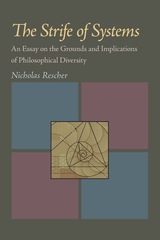 The Strife of Systems: An Essay on the Grounds and Implications of Philosophical Diversity
Nicholas Rescher
University of Pittsburgh Press, 1985
The disagreement of philosophers is notorious. In this book, Rescher develops a theory that accounts for this conflict and shows how the basis for philosophical disagreement roots in divergent 'cognitive values'-values regarding matters such as importance, centrality, and priority. In light of this analysis, Rescher maintains that, despite this inevitable discord, a skeptical or indifferentist reaction to traditional philosophy is not warranted, seeing that genuine value-conflicts are at issue. He argues that philosophy is an important and worthwhile enterprise, notwithstanding its inability to achieve rationally constrained consensus on the issues. Given the nature of the enterprise, consensus is not a realistic goal, and failure to achieve it is not a defect. Accordingly, Rescher argues against the revisionist views proposed by Richard Rorty and Robert Nozick. His discussions are devoted to providing a clear view of why philosophical problems arise and how philosophers address them.
Strike!
Mary Heaton Vorse
University of Illinois Press, 1991 The most famous of the bloody southern textile strikes that took place in the late 1920s occurred at the Loray Mill in Gastonia, North Carolina, where workers endured fifty-five-hour work weeks, the stretchout, and pay so low that everyone in their families over sixteen normally was expected to enter the mill. Strike! is a vivid portrait of the mill workers' living and working conditions, the discomfort of the few southern liberals, the labor spies, the wavering morale of the strikers, the shootings, deaths, and trials, and the vigilante mobs.
The story is told by Mary Heaton Vorse, the leading labor reporter of the period, who had covered major strikes since 1912. This novel was the first of six inspired by the Gastonia strike. Critics hailed it as the best.
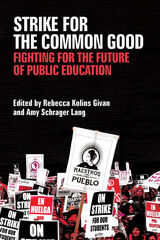 Strike for the Common Good: Fighting for the Future of Public Education
Rebecca Kolins Givan and Amy Schrager Lang, Editors
University of Michigan Press, 2020 In February 2018, 35,000 public school educators and staff walked off the job in West Virginia. More than 100,000 teachers in other states—both right-to-work states, like West Virginia, and those with a unionized workforce—followed them over the next year. From Arizona, Kentucky, and Oklahoma to Colorado and California, teachers announced to state legislators that not only their abysmal wages but the deplorable conditions of their work and the increasingly straitened circumstances of public education were unacceptable. These recent teacher walkouts affirm public education as a crucial public benefit and understand the rampant disinvestment in public education not simply as a local issue affecting teacher paychecks but also as a danger to communities and to democracy. Strike for the Common Good gathers together original essays, written by teachers involved in strikes nationwide, by students and parents who have supported them, by journalists who have covered these strikes in depth, and by outside analysts (academic and otherwise). Together, the essays consider the place of these strikes in the broader landscape of recent labor organizing and battles over public education, and attend to the largely female workforce and, often, largely non-white student population of America’s schools.
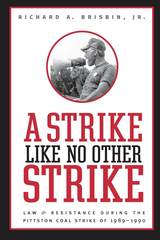 A Strike Like No Other Strike: Law and Resistance During the Pittston Coal Strike of 1989-1990
Richard A. Brisbin, Jr.
West Virginia University Press, 2010 The miners' strike against Pittston Coal in 1989–1990, which spread throughout southwestern Virginia, southern West Virginia, and eastern Kentucky, was one of the most important strikes in the history of American labor, and, as Richard Brisbin observes, "one of the longest and largest incidents of civil disorder and civil disobedience in the United States in the second half of the twentieth century." The company aggressively sought to break the strike, and workers and their families used a variety of tactics—lawful and unlawful—to resist Pittston's efforts as the situation quickly turned ugly. In A Strike like No Other Strike: Law and Resistance during the Pittston Coal Strike of 1989–1990, Richard Brisbin offers a compelling study of the exercise of political power. In considering the legal significance of the strike, Brisbin asks the larger question of whether even extreme transgression or resistance can fracture the "imagined coherence of the law." He shows how each party in the strike invoked the law to justify its actions while attacking those of the other side as unlawful. In the end, both sides lost; although the U.S. Supreme Court ultimately ruled in favor of the union, most of the strikers faced elimination of their jobs and an ongoing struggle for pensions and health benefits.
 Strike!: Twenty Days in 1970 When Minneapolis Teachers Broke the Law
William D. Green
University of Minnesota Press, 2022 The complex and dramatic history of an illegal teachers’ strike that forever altered labor relations and Minnesota politics When viewed from our turbulent times, the Minneapolis of fifty years ago might seem serene, but Minneapolis schoolteachers of the day remember it quite differently. It was, author William D. Green said of their recollections, as if they’d been through war. This book recreates twenty days in April 1970 when a then-illegal strike by Minneapolis’s public school teachers marked a singular moment of cultural upheaval—and forever changed the city’s politics, labor law, educational climate, and the right to collective bargaining. Since the inception of public education in Minnesota, teachers were expected to pursue their vocation out of civic spirit, with low wages, no benefits, and no job security. Strike! describes the history and circumstances leading to the teachers’ extraordinary action, which pitted the progressive and conservative teachers’ unions against each other—and both against the all-powerful school district, a hostile governor and state legislature, and a draconian Minnesota law. Capturing the intense emotions and heated rivalries of the strike, Green profiles the many actors involved, the personal and professional stakes, and the issues of politics, law, and the business of education. Informed by interviews, firsthand accounts, news reports, and written records, Strike! brings to life a pivotal moment not just for Minneapolis’s teachers but for the city itself, whose government, school system, and culture would, in a complex but inexorable way, change course for good.
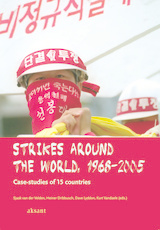 Strikes around the world: Case-studies of 15 countries
Sjaak van der Velden
Amsterdam University Press, 2008 Are strikes going out of fashion or are they an inevitable feature of working life? This is a longstanding debate. The much-proclaimed ‘withering away of the strike’ in the 1950s was quickly overturned by the ‘resurgence of class conflict’ in the late 1960s and 1970s. The period since then has been characterized as one of ‘labor quiescence’. Commentators again predict the strike’s demise, at least in the former heartlands of capitalism.
Patterns of employment are constantly changing and strike activity reflects this. The secular decline of manufacturing in mature industrialized economies is of major importance here (though the global relocation of manufacturing may lead to some ‘relocation’ of strikes). Simultaneously we see the growth of disputes in the service sector (the ‘tertiarization’ of strikes). This is evident particularly in public services, including health care, social care and education, and is accompanied by a ‘feminization’ of strikes, given the prevalence of women working there.
This unique study draws on the experience of fifteen countries around the world – South Africa, Argentina, Canada, Mexico, United States, Korea, Australia, New Zealand, Belgium, Denmark, France, Germany, the Netherlands, Sweden and the United Kingdom. Covering the high and low points of strike activity over the period 1968–2005, the study shows continuing evidence of the durability, adaptability and necessity of the strike.
 Striking a Balance: Making National Economic Policy
Albert Rees
University of Chicago Press, 1984 The language of economic policy is as familiar as the daily newspaper—tax cuts, the prime rate, monetarism, deregulation, the balance of payments—but how well do we understand it? Too often, the reasoning and the difficult choices that lead to economic policies are hidden from nonexperts in a fog of statistics and jargon.
Striking a Balance sets forth in clear, nontechnical language the principal goals of national economic policy, the instruments used to achieve these goals, and the political and economic problems arising from conflicting goals and the choice of inappropriate instruments. It is written not for economics students but for the general public and for students in the related fields of public policy, journalism, and law. Unlike economics textbooks, it is not organized according to theoretical categories such as supply and demand, but around issues such as full employment and inflation. It has no ideological axe to grind and tries to present different views of controversial issues fairly.
Striking a Balance benefits from the wisdom and experience of a mature economist. Albert Rees achieves the rare feat of explicating complex issues without oversimplification or trivialization.
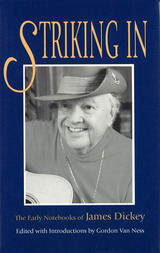 Striking In: The Early Notebooks of James Dickey
Edited & Intro by Gordon Van Ness
University of Missouri Press, 1996
Striking In provides the first detailed look at the artistic beginnings of one of America's most accomplished writers. Chronicling James Dickey's close scrutiny of a wide variety of literary, philosophical, and anthropological works, his extensive experimentation with the possibilities of language, and his projected outlines for poems, stories, and novels, the notebooks serve as a critical tool in understanding Dickey's literary apprenticeship during the fifties.
Although the notebooks identify the influence of writers such as George Barker, Hart Crane, and Dylan Thomas, they primarily present a man endeavoring to chart his own artistic course or destination. The entries depict the process by which Dickey developed the ideas and images that characterize what he himself has labeled his "early motion," revealing the origin of Into the Stone, Drowning with Others, and Helmets, his first three published books of poetry, and suggesting the material and techniques of later volumes.
The introductions by Gordon Van Ness place each notebook in a biographical context and assess its individual significance, and an appendix lists all of Dickey's poems published in the fifties. Extensive footnotes provide further information on many of the specific references within Dickey's entries. Of special importance is the inclusion of ten never-before-published poems as well as fourteen others never collected in Dickey's books.
These notebooks show a young man obsessively committed to improving his creative and critical practice. By providing a direct glimpse into Dickey's mind before he achieved notoriety, Striking In sheds important new light on Dickey's struggle to discover a style and subject matter uniquely his own and will be essential reading for anyone interested in the complexities of Dickey's literary career.
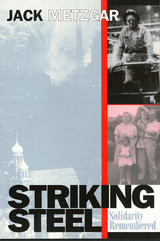 Striking Steel
Jack Metzgar
Temple University Press, 2000 Having come of age during a period of vibrant union-centered activism, Jack Metzgar begins this book wondering how his father, a U.S> Steel shop steward in the 1950s and '60s, and so many contemporary historians could forget what this country owes to the union movement.
Combining personal memoir and historical narrative, Striking Steel argues for reassessment of unionism in American life during the second half of the twentieth century and a recasting of "official memory." As he traces the history of union steelworkers after World War II, Metzgar draws on his father's powerful stories about the publishing work in the mills, stories in which time is divided between "before the union" and since. His father, Johnny Metzgar, fought ardently for workplace rules as a means of giving "the men" some control over their working conditions and protection from venal foremen. He pursued grievances until he eroded management's authority, and he badgered foremen until he established shop-floor practices that would become part of the next negotiated contract. As a passionate advocate of solidarity, he urged coworkers to stick together so that the rules were upheld and everyone could earn a decent wage.
Striking Steel's pivotal event is the four-month nationwide steel strike of 1959, a landmark union victory that has been all but erased from public memory. With remarkable tenacity, union members held out for the shop-floor rules that gave them dignity in the workplace and raised their standard of living. Their victory underscored the value of sticking together and reinforced their sense that they were contributing to a general improvement in American working and living conditions.
The Metzgar family's story vividly illustrates the larger narrative of how unionism lifted the fortunes and prospects of working-class families. It also offers an account of how the broad social changes of the period helped to shift the balance of power in a conflict-ridden, patriarchal household. Even if the optimism of his generation faded in the upheavals of the 1960s, Johnny Metzgar's commitment to his union and the strike itself stands as an honorable example of what a collective action can and did achieve. Jack Metzgar's Striking Steel is a stirring call to remember and renew the struggle.
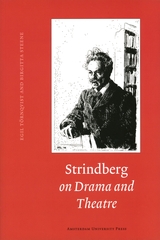 Strindberg on Drama and Theatre
August Strindberg
Amsterdam University Press, 2008
Painter, photographer, alchemist—but ultimately, playwright, and outstanding playwright at that—the figure of August Strindberg (1849–1912) towers over late-nineteenth century drama. Strindberg’s electrifying theatrical work resonated with the public in his own lifetime, and continues to impress audiences around the globe today. A restless innovator of various dramatic forms, he served as a source of inspiration for legendary figures like Eugene O’Neill, Samuel Beckett, and Ingmar Bergman, and proved seminal to the development of modern drama as we know it. Though Strindberg’s preface to Miss Julie and his prefatory note to A Dream Play are well known, Strindberg’s frequent commentary on drama and theatre in general are less familiar, as are most of his plays. Strindberg on Drama and Theatre presents the most important of these comments, chronologically assembled and annotated, many of them published for the first time in English. An essential resource for those interested in one of our most modern playwrights, as well as a thrilling read for the dedicated theatre lover, Strindberg on Drama and Theatre provides a fascinating look at one of our most powerful dramatic voices.
 Strindberg's Letters
August Strindberg
University of Chicago Press, 1992 This is the first major collection in English of August Strindberg's letters, the most vital and wide-ranging body of correspondence in Scandinavian literature. Of ten thousand surviving letters, Michael Robinson has selected and translated more than five hundred of the most important, which trace Strindberg's development and provide a comprehensive view of the life and work of this towering figure in European literary and theatrical Modernism.
Strindberg's plays, novels, and short stories, which influenced film and theatre artists from Artaud and the German Expressionists to Ingmar Bergman and Woody Allen, chart an artistic evolution from Naturalism to the revolt against realism that issued in Expressionist drama. These letters help to explain Strindberg's seminal force and testify to the broad range of his interests, energies, and imaginative instincts. An essential part of their author's oeuvre, the letters provide invaluable insight into Strindberg the artist, the political thinker, and the person, and were regarded by Strindberg himself as an integral component of his autobiographical project.
The letters, some of them published here for the first time, have been meticulously edited and are supported by an extensive introduction and notes.
Strindberg's Letters, Volume 1: 1862-1892
August Strindberg
University of Chicago Press, 1992 This is the first major collection in English of August Strindberg's letters, the most vital and wide-ranging body of correspondence in Scandinavian literature. Of ten thousand surviving letters, Michael Robinson has selected and translated more than five hundred of the most important, which trace Strindberg's development and provide a comprehensive view of the life and work of this towering figure in European literary and theatrical Modernism.
Strindberg's Letters, Volume 2: 1892-1912
August Strindberg
University of Chicago Press, 1992 This is the first major collection in English of August Strindberg's letters, the most vital and wide-ranging body of correspondence in Scandinavian literature. Of ten thousand surviving letters, Michael Robinson has selected and translated more than five hundred of the most important, which trace Strindberg's development and provide a comprehensive view of the life and work of this towering figure in European literary and theatrical Modernism.
The String Quartets of Beethoven
Edited by William Kinderman
University of Illinois Press, 2020 "We do not understand music--it understands us." This aphorism by Theodor W. Adorno expresses the quandary and the fascination many listeners have felt in approaching Beethoven's late quartets. No group of compositions occupies a more central position in chamber music, yet the meaning of these works continues to stimulate debate. William Kinderman's The String Quartets of Beethoven stands as the most detailed and comprehensive exploration of the subject. It collects new work by leading international scholars who draw on a variety of historical sources and analytical approaches to offer fresh insights into the aesthetics of the quartets, probing expressive and structural features that have hitherto received little attention. This volume also includes an appendix with updated information on the chronology and sources of the quartets and a detailed bibliography.
 The String Quartets of Haydn, Mozart, and Beethoven: Studies of the Autograph Manuscripts
Christoph Wolff
Harvard University Press, 1980 This volume represents the proceedings of an international musicological colloquium held at Harvard in March 1979. The broad spectrum of papers and extensive scholarly debate focuses on a quintessential repertoire of musical works from the classical era. The autograph sketches, drafts, and scores of various kinds are shown to be central sources for our understanding of the genesis and history, as well as for the analysis and performance, of the compositions. Contributors are Lewis Lockwood, Laszlo Somfai, Jens Peter Larsen, James Webster, Georg Feder, Ludwig Finscher, Marius Flothuis, Alan Tyson, Christoph Wolff, Richard Kramer, Robert Winter, Sieghard Brandenburg, and Martin Staehelin, scholars working on the frontiers of current research in Haydn, Mozart, and Beethoven studies. An appendix provides chronological tables, a catalog of the extant autograph manuscripts, and an extensive bibliography.
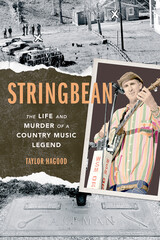 Stringbean: The Life and Murder of a Country Legend
Taylor Hagood
University of Illinois Press, 2023 The artist’s impact on country music and how his death changed the genre A beloved member of the country music community, David “Stringbean” Akeman found nationwide fame as a cast member of Hee Haw. The 1973 murder of Stringbean and his wife forever changed Nashville’s sense of itself. Millions of others mourned not only the slain couple but the passing of the way of life that country music had long represented. Taylor Hagood merges the story of Stringbean’s life with an account of murder and courtroom drama. Mentored by Uncle Dave Macon and Bill Monroe, Stringbean was a bridge to country’s early days. His instrumental savvy and old-time singing style drew upon a deep love for traditional country music that, along with his humor and humanity, won him the reverence of younger artists and made his violent death all the more shocking. Hagood delves into the unexpected questions and uneasy resolutions raised by the atmosphere of retribution surrounding the murder trial and recounts the redemption story that followed decades later.
 Stringfellow Acid Pits: The Toxic and Legal Legacy
Brian Craig
University of Michigan Press, 2020 Stringfellow Acid Pits tells the story of one of the most toxic places in the United States, and of an epic legal battle waged to clean up the site and hold those responsible accountable. In 1955, California officials approached rock quarry owner James Stringfellow about using his land in Riverside County, east of Los Angeles, as a hazardous dump site. Officials claimed it was a natural waste disposal site because of the impermeable rocks that underlay the surface. They were gravely mistaken. Over 33 million gallons of industrial chemicals from more than a dozen of the nation’s most prominent companies poured into the site’s unlined ponds. In the 1960s and 1970s, heavy rains forced surges of chemical-laden water into Pyrite Creek and the nearby town of Glen Avon. Children played in the froth, making fake beards with the chemical foam. The liquid waste contaminated the groundwater, threatening the drinking water for hundreds of thousands of California residents. Penny Newman, a special education teacher and mother, led a grassroots army of so-called “hysterical housewives” who demanded answers and fought to clean up the toxic dump. The ensuing three-decade legal saga involved more than 1,000 lawyers, 4,000 plaintiffs, and nearly 200 defendants, and led to the longest civil trial in California history. The author unveils the environmental and legal history surrounding the Stringfellow Acid Pits through meticulous research based on personal interviews, court records, and EPA and other documents. The contamination at the Stringfellow site will linger for hundreds of years. The legal fight has had an equally indelible influence, shaping environmental law, toxic torts, appellate procedure, takings law, and insurance coverage, into the present day.
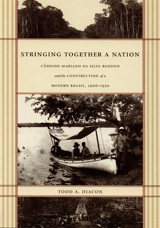 Stringing Together a Nation: Cândido Mariano da Silva Rondon and the Construction of a Modern Brazil, 1906–1930
Todd A. Diacon
Duke University Press, 2004 Focusing on one of the most fascinating and debated figures in the history of modern Brazil, Stringing Together a Nation is the first full-length study of the life and career of Cândido Mariano da Silva Rondon (1865–1958) to be published in English. In the early twentieth century, Rondon, a military engineer, led what became known as the Rondon Commission in a massive undertaking: the building of telegraph lines and roads connecting Brazil’s vast interior with its coast. Todd A. Diacon describes how, in stringing together a nation with telegraph wire, Rondon attempted to create a unified community of “Brazilians” from a population whose loyalties and identities were much more local and regional in scope. He reveals the work of the Rondon Commission as a crucial exemplar of the issues and intricacies involved in the expansion of central state authority in Brazil and in the construction of a particular kind of Brazilian nation. Using an impressive array of archival and documentary sources, Diacon chronicles the Rondon Commission’s arduous construction of telegraph lines across more than eight hundred miles of the Amazon Basin; its exploration, surveying, and mapping of vast areas of northwest Brazil; and its implementation of policies governing relations between the Brazilian state and indigenous groups. He considers the importance of Positivist philosophy to Rondon’s thought, and he highlights the Rondon Commission’s significant public relations work on behalf of nation-building efforts. He reflects on the discussions—both contemporaneous and historiographical—that have made Rondon such a fundamental and controversial figure in Brazilian cultural history.
 The Strings Are Lightning and Hold You In
Chee Brossy
Tupelo Press, 2022 In this stunning collection, Chee Brossy forges a poetics of wonder, dailiness, and transformation. Here, the “sugar cane Coke” and “the leafy houseplant[s]” of the speaker’s daily life, those artifacts of routine, are revealed as glimpses into all that is unknowable, subtle reminders of “today’s mystery.” Indeed, Brossy’s work, with its understated approach and artful evocation, reads as a celebration of all that lies beyond what can be said in language. For Brossy, a meditation on the ineffable, with its innate poeticism and philosophical allure, is not merely an exercise in aesthetics; it is revealing of culture and of the body politic. Here, we witness questions of power, agency, and resistance bound up in what seem at first like simple acts of perception and aesthetic pleasure. “A red-tipped fox trots lazily out. The knives adjust themselves in the dishwasher,” Brossy tells us in language that shines with lyricism and invention. He shows us, in fearful and loving detail, the “starlight vapor in our lungs” and the “terrible dust” within each one of us. “Strength runs through blood like horses,” Brossy reminds us. This is a complex and ultimately transformative debut.
Strip Cultures: Finding America in Las Vegas
The Project on Vegas
Duke University Press, 2015 On the Las Vegas Strip, blockbuster casinos burst out of the desert, billboards promise "hot babes," actual hot babes proffer complimentary drinks, and a million happy slot machines ring day and night. It’s loud and excessive, but, as the Project on Vegas demonstrates, the Strip is not a world apart. Combining written critique with more than one hundred photographs by Karen Klugman, Strip Cultures examines the politics of food and water, art and spectacle, entertainment and branding, body and sensory experience. In confronting the ordinary on America’s most famous four-mile stretch of pavement, the authors reveal how the Strip concentrates and magnifies the basic truths and practices of American culture where consumerism is the stuff of life, digital surveillance annuls the right to privacy, and nature—all but destroyed—is refashioned as an element of decor.
 Strip: Poems
Jessica Abughattas
University of Arkansas Press, 2020 Winner of the 2020 Etel Adnan Poetry Prize, Jessica Abughattas’s Strip is a captivating debut about desire and dispossession and that tireless poetic metaphor—the body. Audacious and clear-eyed, plainspoken and brassy, Abughattas’s poems are songs that break free from confinement as they span the globe from Hollywood to Palestine.
“The mystery that Abughattas composes is always moving toward an impossible freeing of the self from its numerous frames. Yet frame by frame . . . she suspends our disbelief, catalogs those potentialities in an America always ready to shoot, direct, and produce the film of itself. Strip is ‘in love with possibility,’ ‘in praise of here I am, here I’ve been,’ USA style. Strip celebrates the body—its rise and fall, ebb and flow, in a carnival of parties—restlessly, shamelessly, searching for a way out…. Even as Abughattas claims that ‘I can’t believe sometimes I have a body,’ her poems teem with an awareness of the body’s unavoidable centrality in our lives—in how we view our lives, and how others view them; in how they progress, and how they end; in how they become meaningful, and how they are stripped of meaning. And no stripping escapes memory. Whether in terms of dispossession or sexuality, admiration or pity, Abughattas renders her treatment of the body with candor and poignancy. . . . The most startling moments in Abughattas’s poems, however, depend not on shocking or intimate details—but on the ‘I’ pulling away from the self, abandoning the ego, and gazing outward. She tries to see something else, to escape the body’s restraints.”
—Fady Joudah and Hayan Charara, from the Preface
 Striper Wars: An American Fish Story
Dick Russell
Island Press, 2005 When populations of striped bass began plummeting in the early 1980s, author and fisherman Dick Russell was there to lead an Atlantic coast conservation campaign that resulted in one of the most remarkable wildlife comebacks in the history of fisheries. As any avid fisherman will tell you, the striped bass has long been a favorite at the American dinner table; in fact, we've been feasting on the fish from the time of the Pilgrims. By 1980 that feasting had turned to overfishing by commercial fishing interests. Striper Wars is Dick Russell's inspiring account of the people and events responsible for the successful preservation of one of America's favorite fish and of what has happened since. Striper Wars is a tale replete with heroes--and some villains--as the struggle to save the striper migrated down the coast from Massachusetts to Maryland. Russell introduces us to a postman at arms against a burly trap-net fisherman, a renowned state governor caving to special interests, and a fishing-tackle maker fighting alongside marine biologists. And he describes how champions of this singular fish blocked power plants and New York's Westway Project that would otherwise compromise its habitat. Unfortunately, those who cheered the triumphant ending to the campaign, as the coastal states enacted measures that enabled the striped bass to make its comeback, have found the peace transitory--there is now a new enemy emerging on the front. In recent years a chronic bacterial disease has struck more than seventy percent of the striped bass population in the primary spawning waters of the Chesapeake Bay. Malnutrition seems to be a significant factor, brought on by the same overfishing that plagued the bass in the first battle--only this time, the overfishing is devastating menhaden, the silvery little fish upon which the bass feed. Lessons learned during the first conservation battle are being applied here, highlighting a need for a whole new ecosystem-based approach to conserving species. Only with constant vigilance by concerned citizens, Dick Russell reminds us, can environmental victories be sustained. This particular fish story is a personal one for him, and he follows the striper's saga today all the way to California, where the fish was introduced in 1879 and where agribusiness now threatens its future. For his conservation work during the 1980s Russell received a citizen's Chevron Conservation Award.
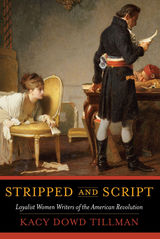 Stripped and Script: Loyalist Women Writers of the American Revolution
Kacy Dowd Tillman
University of Massachusetts Press, 2019 Female loyalists occupied a nearly impossible position during the American Revolution. Unlike their male counterparts, loyalist women were effectively silenced—unable to officially align themselves with either side or avoid being persecuted for their family ties. In this book, Kacy Dowd Tillman argues that women's letters and journals are the key to recovering these voices, as these private writings were used as vehicles for public engagement. Through a literary analysis of extensive correspondence by statesmen's wives, Quakers, merchants, and spies, Stripped and Script offers a new definition of loyalism that accounts for disaffection, pacifism, neutralism, and loyalism-by-association. Taking up the rhetoric of violation and rape, this archive repeatedly references the real threats rebels posed to female bodies, property, friendships, and families. Through writing, these women defended themselves against violation, in part, by writing about their personal experiences while knowing that the documents themselves may be confiscated, used against them, and circulated.
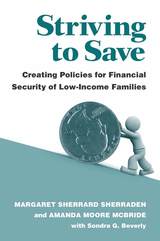 Striving to Save: Creating Policies for Financial Security of Low-Income Families
Margaret Sherrard Sherraden and Amanda Moore McBride
University of Michigan Press, 2010 "Striving to Save will inform and inspire social policy with its breakthrough approach in understanding how low-income families make ends meet while striving to make a better life for themselves and their families. Scholarly work in savings, debt, household finance, and behavior economics will benefit from this pioneering study that provides real-life context for some of the most important issues of our day."
---Tom Shapiro, Brandeis University "The central contribution of the book is to use original qualitative research to provide readers with a nuanced understanding of the financial difficulties facing low-income households, their financial decision-making processes, and their paths to saving and building assets over time. The
book provides an essential corrective to the unidimensional view of poor households as unable and unwilling to save."
---Michael Barr, University of Michigan In Striving to Save, Margaret Sherrard Sherraden and Amanda Moore McBride examine savings in eighty-four working families with low incomes, including fifty-nine families who participated in a groundbreaking program of matched savings and financial education. In-depth interviews with these families, along with savings and survey data, shed light on saving in low-income households. The book concludes with recommended public policy approaches for increasing savings in households that are striving to save. Margaret Sherrard Sherraden is Professor of Social Work at the University of Missouri, St. Louis. Amanda Moore McBride is Assistant Professor of Social Work at Washington University, St. Louis.
 Stroke and the Family: A New Guide
Joel Stein M.D.
Harvard University Press, 2004 A young woman suffers a stroke; she rebuilds her career and personal life, but not before her marriage falls apart. An eighty-year-old man dies unexpectedly of stroke, leaving his grown sons to wonder whether they are genetically predisposed to stroke. A recently retired woman confronts her future with a husband suddenly disabled by stroke. How can she help her husband? Will he ever recover? How will she cope with her own emotional stress?
In Stroke and the Family: A New Guide, Joel Stein shows the many faces of stroke and the people it strikes. To the family just beginning to cope with the aftermath of a stroke, the diagnostic tests, drug regimens, rehabilitation strategies, and varied prognoses can be completely bewildering. Because stroke can affect memory, speech, and movement, the impact on everyday routines and close relationships can be especially intense. Stein has produced a book that allows general readers and nonphysicians working with stroke survivors to make sense of the confusing variety of diagnoses and treatment options, and goes on to explore challenges the recovering stroke patient and the recovering family will face during a long recuperation with an uncertain outcome. Stroke and the Family offers up-to-date information and places the current research findings in context.
A Stroll with William James
Jacques Barzun
University of Chicago Press, 1983 With this book, Jacques Barzun pays what he describes as an "intellectual debt" to William James—psychologist, philosopher, and, for Barzun, guide and mentor. Commenting on James's life, thought, and legacy, Barzun leaves us with a wise and civilized distillation of the great thinker's work.
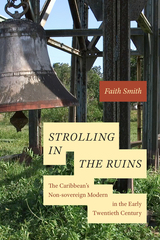 Strolling in the Ruins: The Caribbean's Non-sovereign Modern in the Early Twentieth Century
Faith Smith
Duke University Press, 2023 In Strolling in the Ruins Faith Smith engages with a period in the history of the Anglophone Caribbean often overlooked as nondescript, quiet, and embarrassingly pro-imperial within the larger narrative of Jamaican and Trinidadian nationalism. Between the 1865 Morant Bay Rebellion and World War I, British imperialism was taken for granted among both elites and ordinary people, while nationalist discourses would not begin to shape political imagination in the West Indies for decades. Smith argues that this moment, far from being uneventful, disrupts the inevitability of nationhood in the mid-twentieth century and anticipates the Caribbean’s present-day relationship to global power. Smith assembles and analyzes a diverse set of texts, from Carnival songs, poems, and novels to newspapers, photographs, and gardens, to examine theoretical and literary-historiographic questions concerning time and temporality, empire and diaspora, immigration and indigeneity, gender and the politics of desire, Africa’s place within Caribbeanist discourse, and the idea of the Caribbean itself. Closely examining these cultural expressions of apparent quiescence, Smith locates the quiet violence of colonial rule and the insistence of colonial subjects on making meaningful lives.
Stromateis, Books 1–3
Clement of Alexandria
Catholic University of America Press, 1991 Books One to Three of the Stromateis establish Clement's fundamental theology--a harmony of faith and knowledge that places Greek philosophy at the service of faith, which is, to Clement, more important than knowledge.
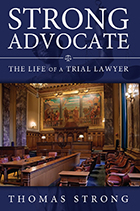 Strong Advocate: The Life of a Trial Lawyer
Thomas Strong
University of Missouri Press, 2012
In Strong Advocate, Thomas Strong, one of the most successful trial lawyers in Missouri’s history, chronicles his adventures as a contemporary personal injury attorney. Though the profession is held in low esteem by the general public, Strong entered the field with the right motives: to help victims who have been injured by defective products or the negligence of others.
As a twelve-year-old in rural southwest Missouri during the Great Depression, Strong bought a cow, then purchased others as he could afford them, and eventually financed his education with the milk he sold. After graduating law school and serving in the Army’s Counter Intelligence Corps, he rejected offers to practice in New York and San Francisco and returned to his hometown of Springfield.
Strong exhibited his lifelong passion to represent the underdog early in his practice, the “trial by ambush” days when neither side was required to disclose witnesses or exhibits. He quickly became known for his audacious approaches to trying cases, including asking a friend to ride on top of a moving car and hiring a local character called “Crazy Max” to recreate an automobile accident. One fraud case ended with Strong owning a bank and his opponent going to prison. When he sued a labor union for the wrongful death of his client’s spouse, he found his own life threatened.
With changes in the law that allowed discovery of information from an opponent’s files as well as the exhibits and witnesses to be used at trial, Strong and fellow personal injury attorneys forced a wide array of manufacturers to produce safer products. When witnesses at a terrible collision claimed both roadways had green lights simultaneously, Strong’s tenacity led to the purchase of the traffic light controllers. After three months of continuous testing at a university, the controller failed, showing four green lights, and Strong learned that fail-safe devices were available but had not been implemented. These fail-safe devices are now standard on traffic lights throughout the country.
In his last venture, Strong represented the state of Missouri in its case against the tobacco industry, culminating in a settlement totaling billions of dollars. He also reflects on the changes—not always for the better—in his oft-maligned profession since he entered the field in the 1950s. Thomas Strong’s story of survival, quick wits, and humor exemplify what made him such a creative and effective attorney. Lawyers and law students can learn much from this giant of the trial bar, but all readers will be entertained and heartened by his victories for the everyman.
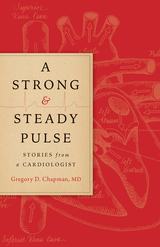 A Strong and Steady Pulse: Stories from a Cardiologist
Gregory D. Chapman, MD
University of Alabama Press, 2021 A seasoned cardiologist shares his experiences, opinions, and recommendations about heart disease and other cardiac problems
A Strong and Steady Pulse: Stories from a Cardiologist provides an insider’s perspective on the field of cardiovascular medicine told through vignettes and insights drawn from Gregory D. Chapman’s three decades as a cardiologist and professor of medicine. In twenty-six bite-sized chapters based on real-life patients and experiences, Chapman provides an overview of contemporary cardiovascular diseases and treatments, illuminating the art and science of medical practice for lay audiences and professionals alike.
With A Strong and Steady Pulse, Chapman provides medical students and general readers with a better understanding of cardiac disease and its contributing factors in modern life, and he also provides insights on the diagnostic process, medical decision making, and patient care. Each chapter presents a patient and their initial appearance, described in clear detail as Chapman gently walks us through his evaluation and the steps he and his associates take to determine the underlying problem. Chapman’s stories are about real people dealing with life and death situations—including the physicians, nurses, medical students, and other team members who try to save lives in emergent, confusing conditions.
The sometimes hard-won solutions to these medical challenges combine new technology and cutting-edge research together with insights drawn from Chapman’s past experiences as an intern and resident in Manhattan during the AIDS epidemic, as a postdoctoral fellow at Duke University in the 1990s, and in practice in Nashville, Tennessee, and Birmingham, Alabama. Conditions addressed include the recognition and management of heart attack, heart failure, arrhythmia, valvular heart disease, cardiac transplantation, broken heart syndrome, hypertension, and the depression some people experience after a heart attack, as well as related topics like statin drugs, the Apple Watch ECG feature, and oral anticoagulants. Finally, the emergence of the COVID-19 virus and its disruption of normal hospital routines as the pandemic unfolded is addressed in an epilogue.
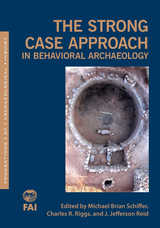 The Strong Case Approach in Behavioral Archaeology
Edited by Michael Brian Schiffer, Charles R. Riggs, and J. Jefferson Reid
University of Utah Press, 2017 Although all archaeologists subscribe in principle to building strong cases in support of their inferences, behavioral archaeology alone has created methodology for developing strong cases in practice. The behavioral version of the strong case approach rests on two main pillars: (1) nomothetic (generalizing) strategies, consisting of research in experimental archaeology, ethnoarchaeology, and long-term processes of behavioral change to produce principles necessary for inference; and (2) the formation processes of supporting evidence when constructing inferences.
The chapters employ a wide range of data classes, demonstrating the versatility and productivity of the approach for fashioning rigorous inferences in history, historical archaeology, ethnoarchaeology, and prehistory. By illustrating the strong case approach with convincing case studies from behavioral archaeology, the editors aim to alert the archaeological community about how the process of archaeological inference can be improved.
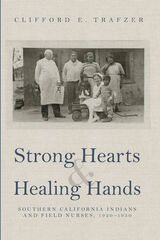 Strong Hearts and Healing Hands: Southern California Indians and Field Nurses, 1920–1950
Clifford E. Trafzer
University of Arizona Press, 2021 In 1924, the United States began a bold program in public health. The Indian Service of the United States hired its first nurses to work among Indians living on reservations. This corps of white women were dedicated to improving Indian health. In 1928, the first field nurses arrived in the Mission Indian Agency of Southern California. These nurses visited homes and schools, providing public health and sanitation information regarding disease causation and prevention.
Over time, field nurses and Native people formed a positive working relationship that resulted in the decline of mortality from infectious diseases. Many Native Americans accepted and used Western medicine to fight pathogens, while also continuing Indigenous medicine ways. Nurses helped control tuberculosis, measles, influenza, pneumonia, and a host of gastrointestinal sicknesses. In partnership with the community, nurses quarantined people with contagious diseases, tested for infections, and tracked patients and contacts. Indians turned to nurses and learned about disease prevention. With strong hearts, Indians eagerly participated in the tuberculosis campaign of 1939–40 to x-ray tribal members living on twenty-nine reservations. Through their cooperative efforts, Indians and health-care providers decreased deaths, cases, and misery among the tribes of Southern California.
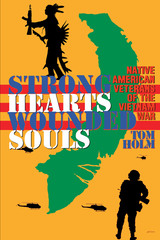 Strong Hearts, Wounded Souls: Native American Veterans of the Vietnam War
By Tom Holm
University of Texas Press, 1996 At least 43,000 Native Americans fought in the Vietnam War, yet both the American public and the United States government have been slow to acknowledge their presence and sacrifices in that conflict. In this first-of-its-kind study, Tom Holm draws on extensive interviews with Native American veterans to tell the story of their experiences in Vietnam and their readjustment to civilian life. Holm describes how Native American motives for going to war, experiences of combat, and readjustment to civilian ways differ from those of other ethnic groups. He explores Native American traditions of warfare and the role of the warrior to explain why many young Indian men chose to fight in Vietnam. He shows how Native Americans drew on tribal customs and religion to sustain them during combat. And he describes the rituals and ceremonies practiced by families and tribes to help heal veterans of the trauma of war and return them to the "white path of peace." This information, largely unknown outside the Native American community, adds important new perspectives to our national memory of the Vietnam war and its aftermath.
 Strong Inside: Perry Wallace and the Collision of Race and Sports in the South
Andrew Maraniss
Vanderbilt University Press, 2024 New York Times Best Seller
2015 RFK Book Awards Special Recognition
2015 Lillian Smith Book Award
2015 AAUP Books Committee "Outstanding" Title
When Strong Inside was first published ten years ago, no one could have predicted the impact the book would have on Vanderbilt University, Nashville, and communities across the nation. What began as a biography of Perry Wallace—the first African American basketball player in the Southeastern Conference (SEC)—became a catalyst for meaningful change and reconciliation between Wallace and the city that had rejected him. In this tenth-anniversary edition, scholars of race and sports Louis Moore and Derrick E. White provide a new foreword that places the story in the context of the study of sports and society, and author Andrew Maraniss adds a concluding chapter filling readers in on how events unfolded between Strong Inside’s publication in 2014 and Perry Wallace’s death in 2017 and exploring Wallace’s continuing legacy.
Wallace entered kindergarten the year that Brown v. Board of Education upended “separate but equal.” As a twelve-year-old, he sneaked downtown to watch the sit-ins at Nashville’s lunch counters. A week after Martin Luther King Jr.’s “I Have a Dream” speech, Wallace entered high school, and later saw the passage of the Civil Rights and Voting Rights acts. On March 19, 1966, his Pearl High School basketball team won Tennessee’s first integrated state tournament—the same day Adolph Rupp’s all-white Kentucky Wildcats lost to the all-Black Texas Western Miners in an iconic NCAA title game.
The world seemed to be opening up at just the right time, and when Vanderbilt recruited him, Wallace courageously accepted the assignment to desegregate the SEC. His experiences on campus and in the hostile gymnasiums of the Deep South turned out to be nothing like he ever imagined.
 Strong Inside: Perry Wallace and the Collision of Race and Sports in the South
Andrew Maraniss
Vanderbilt University Press, 2014 New York Times Best Seller
2015 RFK Book Awards Special Recognition
2015 Lillian Smith Book Award
2015 AAUP Books Committee "Outstanding" Title
Based on more than eighty interviews, this fast-paced, richly detailed biography of Perry Wallace, the first African American basketball player in the SEC, digs deep beneath the surface to reveal a more complicated and profound story of sports pioneering than we've come to expect from the genre. Perry Wallace's unusually insightful and honest introspection reveals his inner thoughts throughout his journey.
Wallace entered kindergarten the year that Brown v. Board of Education upended "separate but equal." As a 12-year-old, he sneaked downtown to watch the sit-ins at Nashville's lunch counters. A week after Martin Luther King Jr.'s "I Have a Dream" speech, Wallace entered high school, and later saw the passage of the Civil Rights and Voting Rights acts. On March 16, 1966, his Pearl High School basketball team won Tennessee's first integrated state tournament--the same day Adolph Rupp's all-white Kentucky Wildcats lost to the all-black Texas Western Miners in an iconic NCAA title game.
The world seemed to be opening up at just the right time, and when Vanderbilt recruited him, Wallace courageously accepted the assignment to desegregate the SEC. His experiences on campus and in the hostile gymnasiums of the Deep South turned out to be nothing like he ever imagined.
On campus, he encountered the leading civil rights figures of the day, including Stokely Carmichael, Martin Luther King Jr., Fannie Lou Hamer, and Robert Kennedy--and he led Vanderbilt's small group of black students to a meeting with the university chancellor to push for better treatment.
On the basketball court, he experienced an Ole Miss boycott and the rabid hate of the Mississippi State fans in Starkville. Following his freshman year, the NCAA instituted "the Lew Alcindor rule," which deprived Wallace of his signature move, the slam dunk.
Despite this attempt to limit the influence of a rising tide of black stars, the final basket of Wallace's college career was a cathartic and defiant dunk, and the story Wallace told to the Vanderbilt Human Relations Committee and later The Tennessean was not the simple story of a triumphant trailblazer that many people wanted to hear. Yes, he had gone from hearing racial epithets when he appeared in his dormitory to being voted as the university's most popular student, but, at the risk of being labeled "ungrateful," he spoke truth to power in describing the daily slights and abuses he had overcome and what Martin Luther King had called "the agonizing loneliness of a pioneer."
Strong Interaction
Thomas Spence Smith
University of Chicago Press, 1992 This book brings the body and its passions back into a new theory of social interaction and social order. Building on innovative conceptions of order, change, and organization, Thomas Spence Smith dramatically expands the definition of human interactions that hold societies together. Here he examines the "strong interactions," such as love relationships, attachments, and addictive behaviors, that are inherently unstable—but are integral parts of any social order.
Blending physiology and psychology with historical examples of social change and a sophisticated new model of social systems, this book contributes to our understanding how societies are possible.
Strong on Music: The New York Music Scene in the Days of George Templeton Strong, Volume 1: Resonances, 1836-1849
Vera Brodsky Lawrence
University of Chicago Press, 1995 In Strong on Music Vera Brodsky Lawrence uses the diaries of lawyer and music lover George Templeton Strong as a jumping-off point from which to explore every aspect of New York City's musical life in the mid-nineteenth century.
Formerly a concert pianist, Vera Brodsky Lawrence spent the last third of her life as a historian of American music (she died in 1996). She was editor of The Piano Works of Louis Moreau Gottschalk and The Complete Works of Scott Joplin.
On Volume 1: "A marvelous book. There is nothing like it in the literature of American music."—Harold C. Schonberg, New York Times Book Review
On Volume 2: "A monumental achievement."—Victor Fell Yellin, Opera Quarterly
 Strong on Music: The New York Music Scene in the Days of George Templeton Strong, Volume 2: Reverberations, 1850-1856
Vera Brodsky Lawrence
University of Chicago Press, 1995 In this second volume of Strong on Music, Vera Brodsky Lawrence carries into the 1850s her landmark account of the nineteenth-century New York music scene. Using music entries from George Templeton Strong's famous journals—most published here for the first time—as a point of departure, Lawrence provides a vivid portrait of a vibrant musical culture.
Each chapter presents one year in the musical life of New York City, with Lawrence's extensive commentary enriched both by excerpts from Strong's diaries and a lavish selection of little-known music criticism and comment from the period. The reviews, written by an often truculent, sometimes venal tribe of music journalists, cover the entire world of music—from opera to barrel organ, salon to saloon.
In this New York, operas performed by renowned artists are parodied by blackface minstrels; performances of the Philharmonic Society are drowned by the raucous chatter of flirtatious adolescents, who turn concerts into a noisy singles' hangout; and irate critics trash the first performances of Verdi operas, calling the plots indecent and the scores noisy and unmelodic. In this volatile atmosphere, a native musical culture is born; its whose first faltering efforts are dubiously received, and the first American composers begin to emerge.
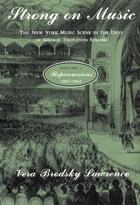 Strong on Music: The New York Music Scene in the Days of George Templeton Strong, Volume 3: Repercussions, 1857-1862
Vera Brodsky Lawrence
University of Chicago Press, 1999 In Strong on Music Vera Brodsky Lawrence uses the diaries of lawyer and music lover George Templeton Strong as a jumping-off point from which to explore every aspect of New York City's musical life in the mid-nineteenth century. This third and final volume ranges across opera, orchestral and chamber music, blackface minstrels, military bands, church choirs, and even concert saloons.
Among the many striking scenes vividly portrayed in Repercussions are the rapturous reception of Verdi's Ballo in maschera in 1861; the impact of the Civil War on New York's music scene, from theaters closing as their musicians enlisted to the performance of "The Star-Spangled Banner" at every possible occasion; and open-air concerts in the developing Central Park. Throughout, Lawrence mines a treasure trove of primary source materials including daily newspapers, memoirs, city directories, and architectural drawings.
Indispensable for scholars, Repercussions will also fascinate music fans with its witty writing and detailed descriptions of the cultural life of America's first metropolis.
Formerly a concert pianist, Vera Brodsky Lawrence spent the last third of her life as a historian of American music (she died in 1996). She was editor of The Piano Works of Louis Moreau Gottschalk and The Complete Works of Scott Joplin.
On Volume 1: "A marvelous book. There is nothing like it in the literature of American music."—Harold C. Schonberg, New York Times Book Review
On Volume 2: "A monumental achievement."—Victor Fell Yellin, Opera Quarterly
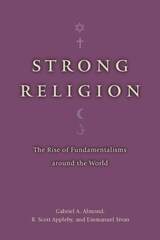 Strong Religion: The Rise of Fundamentalisms around the World
Gabriel A. Almond, R. Scott Appleby, and Emmanuel Sivan
University of Chicago Press, 2003 After the September 11 terrorist attacks against the United States, religious fundamentalism has dominated public debate as never before. Policymakers, educators, and the general public all want to know: Why do fundamentalist movements turn violent? Are fundamentalisms a global threat to human rights, security, and democratic forms of government? What is the future of fundamentalism?
To answer questions like these, Strong Religion draws on the results of the Fundamentalism Project, a decade-long interdisciplinary study of antimodernist, antisecular militant religious movements on five continents and within seven world religious traditions. The authors of this study analyze the various social structures, cultural contexts, and political environments in which fundamentalist movements have emerged around the world, from the Islamic Hamas and Hizbullah to the Catholic and Protestant paramilitaries of Northern Ireland, and from the Moral Majority and Christian Coalition of the United States to the Sikh radicals and Hindu nationalists of India. Offering a vividly detailed portrait of the cultures that nourish such movements, Strong Religion opens a much-needed window onto different modes of fundamentalism and identifies the kind of historical events that can trigger them.
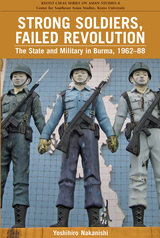 Strong Soldiers, Failed Revolution: The State and Military in Burma, 1962-88
Yoshihiro Nakanishi
National University of Singapore Press, 2013 General Ne Win’s state reformation in the name of the “Burmese Way to Socialism” contributed to the expansion of the political role of the Myanmar Armed Forces, the tatmadaw, but the underlying dynamics of this change remain poorly understood. Drawing on propaganda publications, profiles of the country’s political elites, and original documents in Burma’s military archives, Yoshihiro Nakanishi offers a fresh look at the involvement of the tatmadaw in Burma’s ideological discourse and civil-military relations.
The tatmadaw’s anti-communist propaganda during the 1950s was a key element in state ideology under the Ne Win regime, and the direct participation of tatmadaw officers in the Burma Socialist Programme Party and government ministries at the national and local level transformed the political party system and civilian bureaucracy. Personal relationships — between Ne Win and the tatmadaw officer corps, and within the military — were central to the growing influence of the military, and to the outcome of the political crisis and subsequent military coup d’état in 1988.
Nakanishi’s discussion of these processes reveals many heretofore-unknown facts about this “dark age” in the country’s political history, and highlights its institutional legacy for the post-1988 military regime and the reformist government that succeeded it. His thought-provoking conclusions are significant for Southeast Asia specialists and for students of politics generally, and his insights will be useful for anyone seeking to engage with Myanmar as it comes to terms with an outside world it once kept at arm’s length.
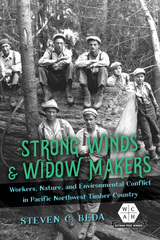 Strong Winds and Widow Makers: Workers, Nature, and Environmental Conflict in Pacific Northwest Timber Country
Steven C. Beda
University of Illinois Press, 2023 Winner of the 2022 Philip Taft Labor History Book Prize
Often cast as villains in the Northwest's environmental battles, timber workers in fact have a connection to the forest that goes far beyond jobs and economic issues. Steven C. Beda explores the complex true story of how and why timber-working communities have concerned themselves with the health and future of the woods surrounding them. Life experiences like hunting, fishing, foraging, and hiking imbued timber country with meanings and values that nurtured a deep sense of place in workers, their families, and their communities. This sense of place in turn shaped ideas about protection that sometimes clashed with the views of environmentalists--or the desires of employers. Beda's sympathetic, in-depth look at the human beings whose lives are embedded in the woods helps us understand that timber communities fought not just to protect their livelihood, but because they saw the forest as a vital part of themselves.
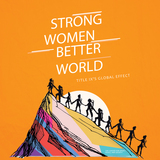 Strong Women. Better World: Title IX's Global Effect
Sarah Hillyer
University of Tennessee Press, 2022 Every story has a hero, every hero has a superpower, and when used with intentionality, sport is an incredible superpower in the fight for gender equality. Strong Women, Better World celebrates the global superheroes who use the potent mix of sport and education to kick down social, cultural, or political barriers and build stronger, more equitable communities. The book highlights nine members and alumnae of the Global Sports Mentoring Program (GSMP) Sisterhood, an award-winning sports diplomacy and mentorship exchange program implemented by the University of Tennessee’s Center for Sport, Peace, and Society (CSPS) in partnership with the U.S. Department of State and espnW. The stories of these nine superheroes are captivating examples of Title IX’s global ripple effect and illustrate how helping empower women and girls worldwide to achieve their own Title IX moments provides multidimensional wins for us all.
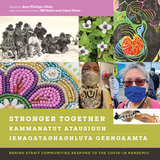 Stronger Together / Kammanatut Atausigun / Iknaqataghaghluta Qerngaamta: Bering Strait Communities Respond to the COVID-19 Pandemic
Amy Phillips-Chan
University of Alaska Press, 2024 A collection of first-person narratives offering a vivid, nuanced look at the lived and shared experiences of Bering Strait communities in the COVID-19 era, Stronger Together is a unique collaboration between the Carrie M. McLain Memorial Museum in Nome, Alaska, and over forty community members, artists, and poets from across the Bering Strait region.
The featured artists narrativize works inspired by the pandemic, from walrus ivory masks and sealskin face coverings to scenes of subsistence activities and informal family portraits. Full-color illustrations enliven the text with vibrant images of local community members, activities, and artwork from those who call this northern expanse of rolling tundra and icy seas home.
Stronger Together features hopeful and redemptive behind-the-scenes perspectives of how remote Alaskan communities endured the COVID-19 pandemic and appeals to anyone looking for hopeful and redemptive stories of this time, as well as museum, public arts, and culture program administrators; student and scholars of Indigenous and Alaska Native languages and culture; the Alaska anthropology community; artists and art enthusiasts; and those with a general interest in Alaska.
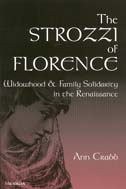 The Strozzi of Florence: Widowhood and Family Solidarity in the Renaissance
Ann Crabb
University of Michigan Press, 2000 In 1434, the new Medici government exiled Matteo Strozzi as an enemy of the regime. Soon afterwards, Matteo and three of his eight children died of the plague. His young widow, Alesandra, struggled to make arrangements for her five remaining children, preparing her sons for merchant careers and finding husbands for her daughters. Her three sons left Florence in the 1440s to enter relatives' merchant banking firms. Their absence, prolonged by a sentence of exile imposed on them in 1458, gave rise to the family correspondence that informs this rich study.
The Strozzi correspondence tells the story of the decline and recovery of one Florentine patrician family. Eventually, the Strozzi brothers earned the greatest fortune of their era, and, after the repeal of their exile, Filippo, the eldest, most successful, and longest lived, spent the last years of his life in Florence as one of its foremost citizens. Set in the context of other documentary evidence and of modern historical and anthropological studies, Crabb's study illuminates the role of women, kinship, solidarity, honor, and profit. These letters provide nuanced insights into values and practices that more impersonal sources cannot rival.
As well as appealing to those interested in the Renaissance, Florence, and Italy, this book will attract those wanting to read about topics in social history that cross time periods: women, family and kinship, business, and honor. It confronts issues of Renaissance Florentine historiography by presenting a more positive view of the role of women than does current orthodoxy, by providing evidence of the impact of extended kinship ties, a controversial issue, and by illuminating further the value placed on honor and profit.
Ann Crabb teaches medieval history at James Madison University.
 Struck Out: Why Employment Tribunals Fail Workers and What Can be Done
David Renton
Pluto Press, 2012 Every year, over a hundred thousand workers bring claims to an Employment Tribunal. The settling of disputes between employers and unions has been exchanged by many for individual litigation.
In Struck Out, barrister David Renton gives a practical and critical guide to the system. In doing so he punctures a number of media myths about the Tribunals. Far from bringing flimsy cases, two-thirds of claimants succeed at the hearing. And rather than paying lottery-size jackpots, average awards are just a few thousand pounds – scant consolation for a loss of employment and often serious psychological suffering. The book includes a critique of the present government’s proposals to reform the Tribunal system.
Employment Tribunals are often seen by workers as the last line of defence against unfairness in the workplace. Struck Out shows why we can't rely on the current system to deliver fairness and why big changes are needed.
 The Structural Allegory: Reconstructive Encounters with the New French Thought
John Fekete, EditorIntroduction by John Fekete
University of Minnesota Press, 1984 The Structural Allegory was first published in 1984. Minnesota Archive Editions uses digital technology to make long-unavailable books once again accessible, and are published unaltered from the original University of Minnesota Press editions. The radical questions raised by Saussure, Barthes, Foucault, Levi-Strauss, and others have had an enormous impact on Anglo-American literary and cultural studies over the past twenty years. John Fekete argues that we can see this strategic development of French thought in terms of what he calls "the structural allegory." Structuralism proper has given way to the currently dominant model of post-structuralism, yet we remain uncertain of the practical orientations favored by thinkers associated with both phases of the movement. With the aim of uncovering the legacy of the structural tradition, the essays in this volume survey key French thinkers, including some not well known in the Anglo-American context — Baudrillard and Castoriadis. The essays are reconstructive, not deconstructive, in character, scholarly in method, and ecumenical in spirit. While the structural allegory emerges from this critical analysis as an inescapable intellectual paradigm (analogous to the transformations in quantum physics and modern biology), the authors argue that it merits admiration and reservation in equal measure.
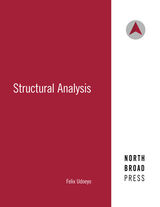 Structural Analysis
Felix F. Udoeyo
Temple University Press, 2020 Structural Analysis by Felix Udeyo is intended to teach students the methods and techniques for the analysis of structures. A sound knowledge of structures is a prerequisite for their proper design and ensures the structural integrity of civil engineering infrastructural systems. This textbook is comprised of three parts. The first part consists of an overview of structural analysis and introduces several structural loadings that may be considered during the analysis and subsequent design of structures. The second part covers classic methods of the analysis of determinate structures. The final section discusses classic methods for the analysis of indeterminate structures as well as methods for the analysis and construction of influence lines for indeterminate structures. This textbook is designed for upper-level undergraduates studying civil engineering, construction engineering and management, and architecture. It is also useful for construction professionals seeking licensure in their field of practice.
An enhanced edition of this textbook is available on the Press’s Manifold platform: https://temple.manifoldapp.org/projects/structural-analysis
Structural Analysis of Unistrut Space-Frame Roofs: Part A: Recommended Method for Computation of Safe Roof Loads
Paul H. Coy
University of Michigan Press, 1959 Part A: Recommended Method for Computation of Safe Roof Loads, of the Structural Analysis of Unistrut Space-Frame Roofs describes the analysis in detail. It contains numerous examples showing how the method can be applied in determining safe loads for Unistrut space-frame roofs where the roof supports vary either in type or in their plan arrangement. Once the proposed method has been fully understood, Part A needs to be consulted only from time to time. Being primarily a textbook, it has been prepared and printed as a separate volume.
Structural Anthropology, Volume 2
Claude Lévi-Strauss
University of Chicago Press, 1983 The eighteen essays collected in this volume have been selected and ordered to give what Lévi-Strauss terms "a bird's-eye view of the problems of modern ethnology." As representative examples, these essays introduce readers to the methods of structural anthropology while affording a glimpse into the mind of one of the foremost anthropologists of our time.
"Structural Anthropology, Volume II is a diverse collection. [It is] a useful 'sampler' that gives a reader the full range of Lévi-Strauss's interests."—Daniel Bell, New York Times Book Review
 Structural Change in the American Economy
Anne P. Carter
Harvard University Press, 1970 Studies on the economics of technological change have only recently become prevalent; nevertheless, the literature is already proliferating at a rate that makes assimilation difficult for the individual scholar. Anne Carter's volume brings to the vast material on production analysis, growth, and economic development the perspective and insights gained through the examination of intermediate inputs and the explanation of structural change in input-output coefficients.
“The present study,” writes the author, “is rooted in the premise that an explicit analysis of changing intermediate input requirements adds more to insight than it does to confusion—particularly in the understanding of technological change... Many practical problems of business and government require an understanding of how, and at what rate, use of plastics or truck transportation or producers' services is changing. Indeed, it is difficult to conceive of studying some central aspects of technical change—such as invention or diffusion of new techniques—without introducing specific intermediate inputs... These are an essential part of the picture. They turn up as variables in questions and answers about our economic system that cannot be discussed at a highly aggregate level. Most important, they are indispensable in bridging the gap between engineering and technical information, on the one hand, and economic description, on the other.”
This work assembles comparable input-output tables for 1939, 1947, and 1958 along with auxiliary information on labor, capital, and final demand for 1939, 1947, 1958, and 1961—data that have not in the past been readily accessible to most students and business analysts. Graphic forms of presentation liberally supplement the basic tables. The study shows how technological change has affected industrial specialization, as well as direct primary inputs, and how these components of change are interrelated. The overall proportion of intermediate to final production saw little change, but systematic shifts appeared in the relative contributions of individual industries. Most structural change resulted from the assimilation of new techniques rather than from classical substitution and, in general, direct laborsaving was large relative to changes in capitol and intermediate requirements.
Carter's study is the first to pursue the question of structural stability and structural change for the United States in detailed, comprehensive, quantitative terms, tying concrete developments in technology to the broader economic picture.
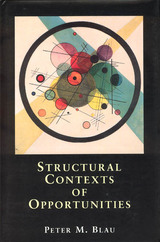 Structural Contexts of Opportunities
Peter M. Blau
University of Chicago Press, 1994 The distinguished sociologist Peter Blau has opened up a variety of fields with brilliant contributions, ranging from research on social networks of small groups and quantitative studies of formal organizations to more synoptic investigations of populations and the large scale structures which hold them together. In this capstone to a prolific career, he has brought together these concerns to form a wide ranging theory of population structures and their influence on social life—from opportunities in job choice and social mobility, to organizational participation, and intergroup relations.
Blau begins by outlining the influences of population structures on intergroup relations and then examining the implications these influences have on occupational opportunities. He looks at the many groups within which an individual is likely to socialize—family, ethnic group, socioeconomic class—and the distance away from these groups an individual is likely to move. Blau demonstrates how such factors affect social mobility, which, in turn, influences membership and structures several types of organizations.
Blau then moves on to interpersonal relationships and analyzes the social exchanges in them that reveal the ultimate effects of ethnic, socioeconomic, and other aspects of population structures. He defines two types of power: influence in direct interpersonal exchange, and large-scale domination (economic or political) of groups without personal contact.
Structural Control and Fault Detection of Wind Turbine Systems
Hamid Reza Karimi
The Institution of Engineering and Technology, 2019 With the rapid growth of wind energy worldwide, challenges in the operation and control of wind turbine systems are becoming increasingly important. These affect all parts of the system, and require an integrated approach to optimize safety, cost, integrity and survivability of the system, while retaining the desired performance quality.
Structural Control and Fault Detection of Wind Turbine Systems
Hamid Reza Karimi
The Institution of Engineering and Technology, 2025 With the rapid growth of wind energy worldwide, and the increasing size of wind turbine systems, addressing challenges in their operation and control is becoming increasingly important. These challenges affect all components of wind turbine systems, and require an integrated approach to optimize safety, cost, structural integrity and system survivability, while maintaining the desired performance quality.
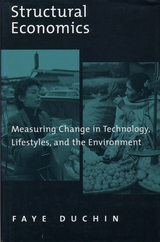 Structural Economics: Measuring Change in Technology, Lifestyles, and the Environment
Faye Duchin
Island Press, 1998 In all societies, the main causes of environmental degradation are resource extraction and the generation of wastes by households and industries. Realistic strategies for mitigating these impacts require an understanding of both the technologies by which resources are transformed into products, and the lifestyle choices that shape household use of such products. Structural Economics provides a framework for developing and evaluating such strategies. It represents an important new approach to describing household lifestyles and technological choices, the relationships between them, and their impact on resource use and waste. In this volume, economist Faye Duchin provides for the first time an authoritative and comprehensive introduction to the field, including its social as well as its technological dimensions. The presentation is accessible to non-specialists while also including a substantial amount of new research. Duchin's primary achievement is to integrate a qualitatively rich understanding of technologies and lifestyles into a flexible, quantitative framework grounded in established principles of input-output economics and social accounting. She uses tools and insights from areas as diverse as demography and market research to conceptualize and describe different categories of households and their lifestyles. She also draws on the expertise of engineers and physical scientists to examine the potential for technological change. The framework Duchin develops permits the rigorous and detailed analysis of specific scenarios for alternative technologies and changes in lifestyle. The author uses the case of Indonesia for illustration and to refine new concepts by testing their relevance against factual information. The new field of structural economics represents an important step forward in the effort to apply the power of science to solving the problems of modern societies. This book should prove invaluable to students and scholars of economics, sociology, or anthropology, as well as environmental scientists, policymakers at all levels, and anyone concerned with a practical interpretation of the elusive concept of sustainable development.
Structural Holes: The Social Structure of Competition
Ronald Burt
Harvard University Press, 1995 Ronald Burt describes the social structural theory of competition that has developed through the last two decades. The contrast between perfect competition and monopoly is replaced with a network model of competition. The basic element in this account is the structural hole: a gap between two individuals with complementary resources or information. When the two are connected through a third individual as entrepreneur, the gap is filled, creating important advantages for the entrepreneur. Competitive advantage is a matter of access to structural holes in relation to market transactions.
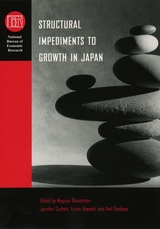 Structural Impediments to Growth in Japan
Edited by Magnus Blomström, Jennifer Corbett, Fumio Hayashi, and Anil Kashyap
University of Chicago Press, 2003 As Japan's decade-long economic stagnation continues, there has been much analysis of the immediate macroeconomic problems that confront the Japanese economy. This book looks past the short-run challenges to the future of Japan and highlights the intermediate and longer-term issues that country faces.
In this, the first book-length academic treatment of this important issue, a team of notable contributors present nine papers, offering a comprehensive assessment of those economic difficulties and addressing a range of specific issues, from financial restructuring and the impact of the aging Japanese population to corporate behavior, public lending, employment practices, and innovative capacity. In each paper, contributors clearly identify and outline problems and concerns, carefully pose provocative questions, and in many instances present concrete suggestions for improvement.
The resulting volume is a timely and important examination of critical issues for Japan's stalling economy, packed with both telling data and expert analysis and offering valuable perspectives on Japan's current obstacles.
Structural Injustice and the Law
Edited by Virginia Mantouvalou and Jonathan Wolff
University College London, 2024 A proposal to incorporate the concept of structural injustice in the standard toolbox of the legal reformer.
Structural Injustice and the Law presents theoretical approaches and case studies demonstrating how the concept of structural injustice can aid legal analysis, and how legal reform can reduce, or even eliminate, some forms of structural injustice. The interdisciplinary topics discussed here in the book include domination, equality, human rights law, legal status, labor law, criminal justice, domestic homicide reviews, homelessness, regulatory public bodies, and the films of Ken Loach. Drawn together, these subjects build an invaluable resource for legal theorists exploring how to use the concept of structural injustice and political philosophers looking for nuanced accounts of the law’s role both in creating and mitigating structural injustice.
 Structural Intimacies: Sexual Stories in the Black AIDS Epidemic
Mackenzie, Sonja
Rutgers University Press, 2013 One of the most relevant social problems in contemporary American life is the continuing HIV epidemic in the Black population. With vivid ethnographic detail, this book brings together scholarship on the structural dimensions of the AIDS epidemic and the social construction of sexuality to assert that shifting forms of sexual stories—structural intimacies—are emerging, produced by the meeting of intimate lives and social structural patterns. These stories render such inequalities as racism, poverty, gender power disparities, sexual stigma, and discrimination as central not just to the dramatic, disproportionate spread of HIV in Black communities in the United States, but to the formation of Black sexualities.
Sonja Mackenzie elegantly argues that structural vulnerability is felt—quite literally—in the blood, in the possibilities and constraints on sexual lives, and in the rhetorics of their telling. The circulation of structural intimacies in daily life and in the political domain reflects possibilities for seeking what Mackenzie calls intimate justice at the nexus of cultural, economic, political, and moral spheres. Structural Intimacies presents a compelling case: in an era of deepening medicalization of HIV/AIDS, public health must move beyond individual-level interventions to community-level health equity frames and policy changes
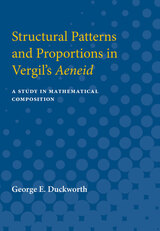 Structural Patterns and Proportions in Vergil's Aeneid: A Study in Mathematical Composition
George E. Duckworth
University of Michigan Press, 1962 m/M = M/(M + m) = 1/2 (v5 - 1) = .618 = the key to the most exciting discovery in the history of Vergilian criticism.As a result of intensive research and study in the poetry of Vergil, George Duckworth has made a remarkable find: Vergil, as well as other poets of his century, deliberately used the Golden Mean ratio to give mathematical symmetry to the structure of his poetry.The author gives a full and critical account of the scholarship, which up to now has been devoted to the construction of the Aeneid. In turn, he traces the Golden Mean ratio—famous in mathematics, art, and architecture—everywhere in the main divisions and subdivisions, in the short speeches, and in the long narrative units of the Aeneid.Duckworth proves with his data that consecutive units of the epic are proportionate to one another in the ratio .618. With the longer and shorter passages denoted as M (major) and m (minor), the exact ratio is: m/M = M/(M + m) = 1/2 (v5 - 1) = .618, being achieved most frequently by the Fibonacci series in which each number is the sum of the two preceding numbers.This extraordinary book provides a new awareness of the marvelous structure of Vergil's poetry. It is an essential text for resolving the disputed passages in Vergil. George Duckworth has pioneered a structural analysis that will not only make obsolete much Vergilian criticism but will, in addition, serve as a basis for future research.
 Structural Slumps: The Modern Equilibrium Theory of Unemployment, Interest, and Assets
Edmund S. Phelps
Harvard University Press, 1994 Dissatisfied with the explanations of the business cycle provided by the Keynesian, monetarist, New Keynesian, and real business cycle schools, Edmund Phelps has developed from various existing strands—some modern and some classical—a radically different theory to account for the long periods of unemployment that have dogged the economies of the United States and Western Europe since the early 1970s. Phelps sees secular shifts and long swings of the unemployment rate as structural in nature. That is, they are typically the result of movements in the natural rate of unemployment (to which the equilibrium path is always tending) rather than of long-persisting deviations around a natural rate itself impervious to changing structure. What has been lacking is a “structuralist” theory of how the natural rate is disturbed by real demand and supply shocks, foreign and domestic, and the adjustments they set in motion.
To study the determination of the natural rate path, Phelps constructs three stylized general equilibrium models, each one built around a distinct kind of asset in which firms invest and which is important for the hiring decision. An element of these models is the modern economics of the labor market whereby firms, in seeking to dampen their employees’ propensities to quit and shirk, drive wages above market-clearing levels-the phenomenon of the “incentive wage”—and so generate involuntary unemployment in labor-market equilibrium. Another element is the capital market, where interest rates are disturbed by demand and supply shocks such as shifts in profitability, thrift, productivity, and the rate of technical progress and population increase. A general-equilibrium analysis shows how various real shocks, operating through interest rates upon the demand for employees and through the propensity to quit and shirk upon the incentive wage, act upon the natural rate (and thus equilibrium path).
In an econometric and historical section, the new theory of economic activity is submitted to certain empirical tests against global postwar data. In the final section the author draws from the theory some suggestions for government policy measures that would best serve to combat structural slumps.
Structure, Alignment and Optimality in Swedish
Peter Sells
CSLI, 2001 Very little research has been performed on the grammatical structure of sentences in Swedish. Structure, Alignment and Optimality in Swedish is one of the first books to explore the Swedish sentence structure, presenting an account of the order of the words and phrases within the sentence. The book uses the theoretical framework of Lexical-Functional Grammar (LFG), which provides syntactic analysis in terms of subject, object, topic, and focus, as well as part-of-speech analysis in terms of noun phrase and verb phrase. The book also uses Optimality Theory, a theory of constraint interpretation that allows constraints to conflict by allowing the satisfaction of certain constraints or requirements to lead to a grammatical structure even if less important constraints are violated.
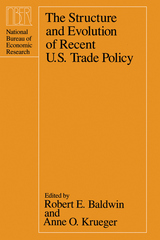 The Structure and Evolution of Recent U.S. Trade Policy
Edited by Robert E. Baldwin and Anne O. Krueger
University of Chicago Press, 1985 The trade policies addressed in this book have far-reaching effects on the world's increasingly interdependent economies, but until now little research has been devoted to them. This volume represents the first systematic effort to analyze specific U.S. trade policies, particularly nontariff measures. It provides a better understanding of how trade policies operate, how effective they are, and what their costs and benefits are to trading nations.
The contributors chart the history of U.S. trade policy since World War II, analyze industry-specific trade barriers, and discuss the effects of tariff preferences and export-promoting policies such as export credits and domestic international sales corporations (DISCs). The final section of essays examines the worldwide impact of import policies, pointing out subtleties in industry-specific policies and providing insight into the levels of protection in developing countries. The contributors blend state-of-the-art economics with language that is accessible to the business community, economists, and policymakers. Commentaries accompany each paper.
Structure and Features of Anna Komnene’s Alexiad: Emergence of a Personal History
Larisa Vilimonovic
Amsterdam University Press, 2019 The Alexiad, written in the twelfth century by a Byzantine princess, Anna Komnene, tells the story of the Byzantine Empire during the reign of her father, offering accounts of its political and military history, including its involvement with the First Crusade. Structure and Features of Anna Komnene’s Alexiad: Emergence of a Personal History introduces new methods of research for studying the Alexiad, aiming primarily at analysing Anna Komnene’s literary expression. The book’s approach focuses mainly on the author, the subject, the structure and the inner stylistic features, as well as the genre itself. The result is a substantially new outlook on the main Byzantine historiographical work of the twelfth century.
The Structure and Interpretation of Quantum Mechanics
R.I.G. Hughes
Harvard University Press, 1989 R. I. G. Hughes offers the first detailed and accessible analysis of the Hilbert-space models used in quantum theory and explains why they are so successful. He goes on to show how the very suitability of Hilbert spaces for modeling the quantum world gives rise to deep problems of interpretation, and makes suggestions about how they can be overcome.
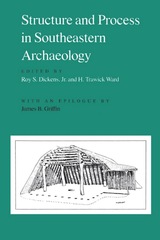 Structure and Process in Southeastern Archaeology
Edited by Roy Dickens Jr and H. Trawick Ward
University of Alabama Press, 1985 A Dan Josselyn Memorial Publication Within the general structure-and-process theme of this compendium, the authors have focused on either intrasite problems (those dealing with the formation and structure of a site, type of site, or type of feature) or intersite problems (those dealing with behavioral organization and process as developed from comparative site data). These papers, from a broad range of specialists, present a comprehensive study of southeastern archaeology. Structure and Process in Southeastern Archaeology is a foundational work that reshapes how scholars understand the cultural and social dynamics of prehistoric communities in the Southeastern United States. Roy S. Dickens, Jr. and H. Trawick Ward bring together decades of fieldwork, theoretical insight, and regional expertise to explore how ancient societies organized themselves, interacted, and evolved over time. Rather than focusing solely on artifacts or isolated site reports, this volume emphasizes the broader patterns—both structural and processual—that define the archaeological record of the Southeast. Through a careful synthesis of settlement data, material culture, and environmental context, the authors reveal how social organization, political structures, and cultural practices were deeply embedded in the landscape. Their approach integrates processual archaeology with a nuanced understanding of regional variation, offering readers a dynamic view of how prehistoric communities adapted to changing conditions and interacted across space and time. This book is particularly valuable for archaeologists, anthropologists, and historians seeking to move beyond descriptive accounts toward more interpretive frameworks. It provides a model for analyzing archaeological data in ways that illuminate the lived experiences of ancient peoples, making it a vital resource for both academic research and classroom instruction. The authors’ clear writing and thoughtful analysis make complex ideas accessible without sacrificing scholarly rigor. Whether you're studying Mississippian chiefdoms, Woodland period settlements, or the broader cultural landscapes of the American South, Structure and Process in Southeastern Archaeology offers essential tools for understanding the past. It stands as a testament to the importance of theory-driven, context-rich archaeological interpretation.
Structure and Regional Diversity in the Meadowood Interaction Sphere
Karine Taché
University of Michigan Press, 2011 This monograph offers the first major synthesis of the Meadowood phenomenon, one of the earliest and largest interaction spheres in northeastern North America. This volume breathes new life into our understanding of the Early Woodland phenomenon (3000–2400 BP).
The Structure and Sentiment
Rodney Needham
University of Chicago Press, 1984 "Structure and Sentiment is an important book. Reading it may make an anthropologist more keenly aware of certain issues that are crucial in social anthropology, and this awareness may make one's field work as well as one's reading of published ethnographies more perceptive."—F. G. Lounsbury, American Anthropologist
"A theoretical and methodological essay of first importance. As such, the book should be of interest to all social scientists interested in the development of specific and general theory in social anthropology."—Southwestern Social Science Quarterly
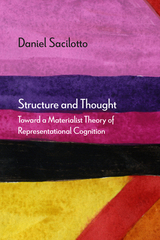 Structure and Thought: Toward a Materialist Theory of Representational Cognition
Daniel Sacilotto; Foreword by Ray Brassier
Northwestern University Press, 2024 Offers a new understanding of representational cognition that synthesizes postwar philosophical approaches to the question of objective knowledge
This study develops a novel account of representational cognition, explaining how cognitive systems progressively come to map the structure of their worlds. Daniel Sacilotto offers a constructive response to the critique of representation formulated throughout the post‑Kantian philosophical tradition. Rather than a skepticism or idealism whereby thinking can grasp appearances but never the real, representation, Sacilotto shows, is a constitutive dimension of cognitive systems’ creative capacity to know and intervene in the world of which they are part.
Structure and Thought: Toward a Materialist Theory of Representational Cognition integrates various lines in contemporary philosophy, including those often seen as incommensurable or in irresolvable tension with one another. Sacilotto thus advances a productive synthesis of a materialist ambition to provide a creative and historical understanding of cognition with a structural realist account of representation. He shows how the different forms of sensory, discursive, and theoretical mediation that characterize human cognition are conducive to a realist epistemological framework that explains how the possibility of knowledge about a mind‑independent reality is conceivable.
The Structure of Complex Predicates in Urdu
Miriam Butt
CSLI, 1995 Complex predicates in a number of diverse languages present an interesting problem for formal linguistics as their overall semantics cannot be placed into a simple one-to-one correspondence with the syntactic or morphological pieces which form the complex predicate. A central issue in the investigation of complex predicates thus is the interaction between syntax and semantics.
This book takes a detailed look at two differing complex predicates in the South Asian language Urdu. The Urdu permissive in particular brings into focus the problem of the syntax-semantics mismatch. An examination of the syntactic properties of this complex predicate shows that it is formed by the combination of two semantic heads, but that this combination is not mirrored in the syntax in terms of any kind of syntactic or lexical incorporation.
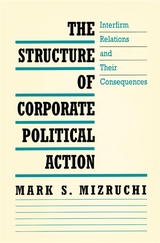 The Structure of Corporate Political Action: Interfirm Relations and Their Consequences
Mark S. Mizruchi
Harvard University Press, 1992 Are large American corporations politically unified or divided? This question, which has important implications for the viability of American democracy, has frustrated social scientists and political commentators for decades. Despite years of increasingly sophisticated research, resolution of the issue remains as elusive as ever.
In this important book, Mark S. Mizruchi presents and tests an original model of corporate political behavior. He argues that because the business community is characterized by both unity and conflict, the key issue is not whether business is unified but the conditions under which unity or conflict occurs.
Adopting a structural model of social action, Mizruchi examines the effects of factors such as geographic proximity, common industry membership, stock ownership, interlocking directorates, and interfirm market relations on the extent to which firms behave similarly. The model is tested with data on the campaign contributions of corporate political action committees and corporate testimony before Congress. Mizruchi finds that both organizational and social network factors contribute to similar behavior and that similar behavior increases a group's likelihood of political success.
This study demonstrates that rather than making their political decisions in a vacuum, firms are influenced by the social structures within which they are embedded. The results establish for the first time that the nature of relations between firms has real political consequences.
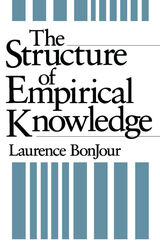 The Structure of Empirical Knowledge
Laurence BonJour
Harvard University Press, 1988 How must our knowledge be systematically organized in order to justify our beliefs? There are two options—the solid securing of the ancient foundationalist pyramid or the risky adventure of the new coherentist raft. For the foundationalist like Descartes each piece of knowledge can be stacked to build a pyramid. Not so, argues Laurence BonJour. What looks like a pyramid is in fact a dead end, a blind alley. Better by far to choose the raft.
Here BonJour sets out the most extensive antifoundationalist argument yet developed. The first part of the book offers a systematic exposition of foundationalist views and formulates a general argument to show that no variety of foundationalism provides an acceptable account of empirical justification. In the second part he explores a coherence theory of empirical knowledge and argues that a defensible theory must incorporate an adequate conception of observation. The book concludes with an account of the correspondence theory of empirical truth and an argument that systems of empirical belief which satisfy the coherentist standard of justification are also likely to be true.
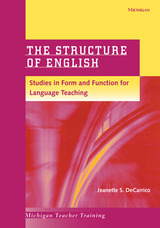 The Structure of English: Studies in Form and Function for Language Teaching
Jeanette S. DeCarrico
University of Michigan Press, 2000 Covering the spectrum of grammatical structures, The Structure of English teaches why grammatical structures are important and how to use them through literary illustrations and clear explanations of grammar's effective use and communicative function. It is directed at future English teachers, as well as the new ESL/EFL teacher.
With an emphasis on discourse function throughout, students are never expected to rely on lists of unrelated, constructed example sentences. Rather, when major points of grammar are presented, the structures are illustrated with rich, "real world" contexts excerpted from literature (mostly American), including novels, short stories, poems, essays, and drama. Exercises in the companion workbook are likewise based on naturally occurring stretches of discourse.
Though informed by modern linguistic theory, explanations are framed in more traditional terminology and are designed to help build students' confidence in using English grammar by deepening their understanding of its forms and functions..
For advanced ESL students and graduate TESOL and certificate programs.
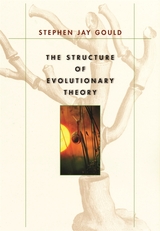 The Structure of Evolutionary Theory
Stephen Jay Gould
Harvard University Press, 2002 The world's most revered and eloquent interpreter of evolutionary ideas offers here a work of explanatory force unprecedented in our time--a landmark publication, both for its historical sweep and for its scientific vision.
With characteristic attention to detail, Stephen Jay Gould first describes the content and discusses the history and origins of the three core commitments of classical Darwinism: that natural selection works on organisms, not genes or species; that it is almost exclusively the mechanism of adaptive evolutionary change; and that these changes are incremental, not drastic. Next, he examines the three critiques that currently challenge this classic Darwinian edifice: that selection operates on multiple levels, from the gene to the group; that evolution proceeds by a variety of mechanisms, not just natural selection; and that causes operating at broader scales, including catastrophes, have figured prominently in the course of evolution.
Then, in a stunning tour de force that will likely stimulate discussion and debate for decades, Gould proposes his own system for integrating these classical commitments and contemporary critiques into a new structure of evolutionary thought.
In 2001 the Library of Congress named Stephen Jay Gould one of America's eighty-three Living Legends--people who embody the "quintessentially American ideal of individual creativity, conviction, dedication, and exuberance." Each of these qualities finds full expression in this peerless work, the likes of which the scientific world has not seen--and may not see again--for well over a century.
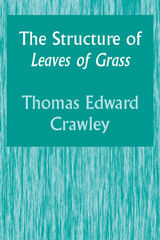 The Structure of Leaves of Grass
By Thomas Edward Crawley
University of Texas Press, 1970 Modern critics and contemporary readers familiar with the field of Whitman criticism may find surprising an analysis of the structure of Leaves of Grass that concerns itself with Whitman as the poet-prophet and the identification of Whitman (or of his persona in the poem) with Christ. Early twentieth-century criticism has tended to exalt the early Whitman at the expense of the later one and to regard as poetically inferior the image of the national and democratically prophetic Whitman as expressed in the later editions. Thomas Edward Crawley, in full knowledge of the contemporary currents of Whitman criticism, chooses to revert to this older view, through which he sheds new light on Whitman’s artistic achievement. The basic premise of this study is that Walt Whitman’s Leaves of Grass is a unified work, lyrical, yet epic in quality, design, and spirit. Crawley’s purpose is to demonstrate the basis of this unity: its origin and operation and the nature of its realization. He demonstrates that an aesthetically maturing Whitman, in this work, was finally able to harmoniously bring together his individual and social subject matter. Crawley defines the unifying spirit of Leaves of Grass in terms of Whitman’s concept of the poet-prophet and the poet-reader relationship. This concept is conveyed primarily through the development of the Christ- symbol, the dominant image in the poem. Through a careful analysis of Whitman’s handling of the simultaneous development of the poet-prophet and the nation, his masterful fusion of the personal element and the national element, an understanding of the complex structure of Leaves of Grass emerges. Crawley presents an analysis of Whitman’s final and carefully arrived at grouping of the lyrics in the 1881 edition according to a definite, distinguishable pattern—a pattern revealed in Whitman’s use of allusions, in his transitional poems and passages, and, most important, in his thematic handling of imagery. The cumulative effect of these devices is emphasized. The organic development of Leaves of Grass, made possible by Whitman’s faith in and careful adherence to his concept of the organic theory of art, is substantiated. Crawley concludes his analysis with a detailed examination of the growth of Leaves of Grass as reflected in the various editions leading up to the 1881 volume, the last to be revised and published by Whitman.
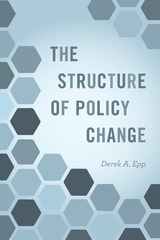 The Structure of Policy Change
Derek A. Epp
University of Chicago Press, 2018 When the Soviet Union launched Sputnik, the Red Scare seized the American public. While President Eisenhower cautioned restraint, his hand was forced, and NASA’s budget had increased five thousand percent over its pre-Sputnik levels by the time President Kennedy proposed landing a man on the moon. Spending on the space race is in no way unique; Almost every policy area has its own Sputnik-type story, where waves of popular support for an idea (or disillusionment with a previous one) created new political priorities, resulting in dramatic changes to the budget or compelling agencies to respond quickly with little knowledge or preparation. Is this instability an inherent feature of the policy process, or is it possible for an agency to deal with problems in a way that insulates it from swings in public opinion and thus imposes some stability on the decision making process?
Derek A. Epp argues that some agencies can indeed do that and that instability is at least partially a function of poor institutional design. While it is inherently more challenging to maintain stability around complex problems like immigration or climate change, the deliberative process itself can affect the degree of stability around an issue. Epp looks at whether agencies follow a deliberative model for decision making, in which policies are developed by means of debate among a small group of policymakers, or a collective model, in which the opinions of many people are aggregated, as with the stock market. He argues that, in many instances, the collective model produces more informed and stable policy outcomes that can be adapted more readily to new information and changing public priorities.
The Structure of Russian in Outline
Charles Bidwell
University of Pittsburgh Press, 1970 A brief, structurally oriented reference grammar of Russian for use by advanced students, Slavicists, and linguists, Bidwell's guide can also be used as a text for courses on the linguistic structure and grammar of the Russian language.
Bidwell offers an original phonemic analysis and, breaking with traditional grammars, treats the language as primarily and basically a spoken phenomenon with the grammatical description based solidly on the spoken forms. Divided into three sections, focusing on the phonemics, morphology, and syntax, The Structure of Russian in Outline aims to give a coherent and concise account of the sounds, forms, and constructions of the Russian language, treating the whole as an integrated system structured on hierarchical levels.
The Structure of Scientific Articles: Applications to Citation Indexing and Summarization
Simone Teufel
CSLI, 2010 Finding a particular scientific document amidst a sea of thousands of other documents can often seem like an insurmountable task. The Structure of Scientific Articles shows how linguistic theory can provide a solution by analyzing rhetorical structures to make information retrieval easier and faster.
Through the use of an improved citation indexing system, this indispensable volume applies empirical discourse studies to pressing issues of document management, including attribution, the author’s stance towards other work, and problem-solving processes.
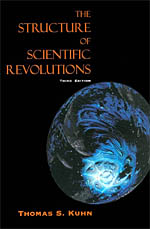 The Structure of Scientific Revolutions
Thomas S. Kuhn
University of Chicago Press, 1996 "A landmark in intellectual history which has attracted attention far beyond its own immediate field. . . . It is written with a combination of depth and clarity that make it an almost unbroken series of aphorisms. . . . Kuhn does not permit truth to be a criterion of scientific theories, he would presumably not claim his own theory to be true. But if causing a revolution is the hallmark of a superior paradigm, [this book] has been a resounding success." —Nicholas Wade, Science
"Perhaps the best explanation of [the] process of discovery." —William Erwin Thompson, New York Times Book Review
"Occasionally there emerges a book which has an influence far beyond its originally intended audience. . . . Thomas Kuhn's The Structure of Scientific Revolutions . . . has clearly emerged as just such a work." —Ron Johnston, Times Higher Education Supplement
"Among the most influential academic books in this century." —Choice
One of "The Hundred Most Influential Books Since the Second World War," Times Literary Supplement
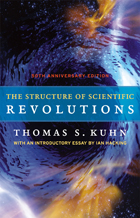 The Structure of Scientific Revolutions: 50th Anniversary Edition
Thomas S. Kuhn
University of Chicago Press, 2012 A good book may have the power to change the way we see the world, but a great book actually becomes part of our daily consciousness, pervading our thinking to the point that we take it for granted, and we forget how provocative and challenging its ideas once were—and still are. The Structure of Scientific Revolutions is that kind of book. When it was first published in 1962, it was a landmark event in the history and philosophy of science. Fifty years later, it still has many lessons to teach.
With The Structure of Scientific Revolutions, Kuhn challenged long-standing linear notions of scientific progress, arguing that transformative ideas don’t arise from the day-to-day, gradual process of experimentation and data accumulation but that the revolutions in science, those breakthrough moments that disrupt accepted thinking and offer unanticipated ideas, occur outside of “normal science,” as he called it. Though Kuhn was writing when physics ruled the sciences, his ideas on how scientific revolutions bring order to the anomalies that amass over time in research experiments are still instructive in our biotech age.
This new edition of Kuhn’s essential work in the history of science includes an insightful introduction by Ian Hacking, which clarifies terms popularized by Kuhn, including paradigm and incommensurability, and applies Kuhn’s ideas to the science of today. Usefully keyed to the separate sections of the book, Hacking’s introduction provides important background information as well as a contemporary context. Newly designed, with an expanded index, this edition will be eagerly welcomed by the next generation of readers seeking to understand the history of our perspectives on science.
The Structure of Soviet Wages: A Study in Socialist Economics
Abram Bergson
Harvard University Press Economists and others concerned with the theory of wages or with the functioning of Soviet economy will find this investigation of the inequality of wages in the Soviet Union an illuminating study. Based on data used by Soviet administrators in making their decisions, it establishes for the first time in a scientifically acceptable manner the principles according to which differences in earnings in the U.S.S.R. are determined. It is also the first study to present comparable data on the inequality prevailing under capitalism.
Structure of the Brothers Karamazov
Robert Belknap
Northwestern University Press, 1989 Long unavailable, The Structure of "The Brothers Karamazov" is a classic in American Slavic studies. Robert L. Belknap's study clarifies the complex architectonics of Dostoevsky's most carefully constructed and painstakingly written book by employing structuralist critical methods. This first paperback edition includes a new preface by the author, reflecting on the theory of the book and on recent developments in Dostoevsky criticism and relevant critical theory.
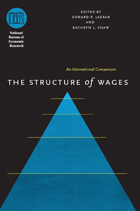 The Structure of Wages: An International Comparison
Edited by Edward P. Lazear and Kathryn L. Shaw
University of Chicago Press, 2009 The distribution of income, the rate of pay raises, and the mobility of employees is crucial to understanding labor economics. Although research abounds on the distribution of wages across individuals in the economy, wage differentials within firms remain a mystery to economists. The first effort to examine linked employer-employee data across countries, The Structure of Wages:An International Comparison analyzes labor trends and their institutional background in the United States and eight European countries.
A distinguished team of contributors reveal how a rising wage variance rewards star employees at a higher rate than ever before, how talent becomes concentrated in a few firms over time, and how outside market conditions affect wages in the twenty-first century. From a comparative perspective that examines wage and income differences within and between countries such as Denmark, Italy, and the Netherlands, this volume will be required reading for economists and those working in industrial organization.
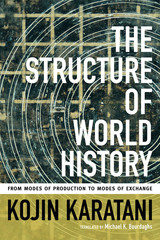 The Structure of World History: From Modes of Production to Modes of Exchange
Kojin Karatani
Duke University Press, 2014 In this major, paradigm-shifting work, Kojin Karatani systematically re-reads Marx's version of world history, shifting the focus of critique from modes of production to modes of exchange. Karatani seeks to understand both Capital-Nation-State, the interlocking system that is the dominant form of modern global society, and the possibilities for superseding it. In The Structure of World History, he traces different modes of exchange, including the pooling of resources that characterizes nomadic tribes, the gift exchange systems developed after the adoption of fixed-settlement agriculture, the exchange of obedience for protection that arises with the emergence of the state, the commodity exchanges that characterize capitalism, and, finally, a future mode of exchange based on the return of gift exchange, albeit modified for the contemporary moment. He argues that this final stage—marking the overcoming of capital, nation, and state—is best understood in light of Kant's writings on eternal peace. The Structure of World History is in many ways the capstone of Karatani's brilliant career, yet it also signals new directions in his thought.
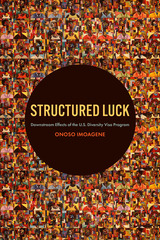 Structured Luck: Downstream Effects of the U.S. Diversity Visa Program
Onoso Imoagene
Russell Sage Foundation, 2024 The Diversity Immigrant Visa Program is a lottery that awards winners from underrepresented countries the chance to apply for legal permanent residence in the United States. Most lottery winners think of themselves as lucky, viewing the win as an opportunity to pursue better lives for themselves and their families. In Structured Luck, sociologist Onoso Imoagene uses immigrants’ stories to show that while the visa program benefits many recipients, the program’s design can also lead to exploitation in their countries of origin and reduced potential once they are in the United States.
Combining ethnographic observation in Africa and interviews with immigrants, their family members, and friends from Ghana and Nigeria, Imoagene demonstrates that the visa program is a process of “structured luck,” from how people hear about the lottery, who registers for it, and who participates in it to the application requirements for the visa. In Ghana and Nigeria, people often learn about the lottery through friends, colleagues, or relatives who persuade them to enter for the perceived benefits of receiving a visa: opportunities for upward mobility, permanent legal status, and the ability to bring along family members. Though anyone can enter the lottery, not everyone who wins obtains a visa. The visa application process requires proof of a high school diploma or artisan skills, a medical exam, a criminal background check, an interview with U.S. consular officers, and payment of fees. Such requirements have led to the growth of visa entrepreneurs, who often charge exorbitant fees to steer immigrants through the process. Visa recipients who were on track to obtain university degrees at home often leave in the middle of their studies for the United States but struggle to continue their education due to high U.S. tuition costs. And though their legal status allows them to escape the demoralizing situations that face the undocumented, these immigrants lack the social support that the government sometimes provides for refugees and other migrants. Ultimately, Imoagene notes, the real winner of the visa lottery is not the immigrants themselves but the United States, which benefits from their relatively higher levels of education. Consequently, she argues, the U.S. must do more to minimize the visa program’s negative consequences.
Structured Luck illuminates the trauma, resilience, and determination of immigrants who come to the United States through the Diversity Visa Program and calls for the United States to develop policies that will better integrate them into society.
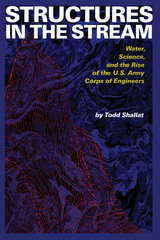 Structures in the Stream: Water, Science, and the Rise of the U.S. Army Corps of Engineers
By Todd Shallat
University of Texas Press, 1994 As the Mississippi and other midwestern rivers inundated town after town during the summer of 1993, concerned and angry citizens questioned whether the very technologies and structures intended to "tame" the rivers did not, in fact, increase the severity of the floods. Much of the controversy swirled around the apparent culpability of the U.S. Army Corps of Engineers, the builder of many of the flood control systems that failed. In this book, Todd Shallat examines the turbulent first century of the dam and canal building Corps and follows the agency's rise from European antecedents through the boom years of river development after the American Civil War. Combining extensive research with a lively style, Shallat tells the story of monumental construction and engineering fiascoes, public service and public corruption, and the rise of science and the army expert as agents of the state. More than an institutional history, Structures in the Stream offers significant insights into American society, which has alternately supported the public works projects that are a legacy of our French heritage and opposed them based on the democratic, individualist tradition inherited from Britain. It will be important reading for a wide audience in environmental, military, and scientific history, policy studies, and American cultural history.
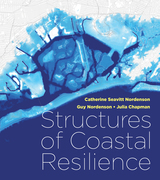 Structures of Coastal Resilience
Catherine Seavitt Nordenson, Guy Nordenson, and Julia Chapman
Island Press, 2018 Structures of Coastal Resilience presents new strategies for creative and collaborative approaches to coastal planning for climate change. In the face of sea level rise and an increased risk of flooding from storm surge, we must become less dependent on traditional approaches to flood control that have relied on levees, sea walls, and other forms of hard infrastructure. But what are alternative approaches for designers and planners facing the significant challenge of strengthening their communities to adapt to uncertain climate futures?
Authors Catherine Seavitt Nordenson, Guy Nordenson, and Julia Chapman have been at the forefront of research on new approaches to effective coastal resilience planning for over a decade. In Structures of Coastal Resilience, they reimagine how coastal planning might better serve communities grappling with a future of uncertain environmental change. They encourage more creative design techniques at the beginning of the planning process, and offer examples of innovative work incorporating flexible natural systems into traditional infrastructure. They also draw lessons for coastal planning from approaches more commonly applied to fire and seismic engineering. This is essential, they argue, because storms, sea level rise, and other conditions of coastal change will incorporate higher degrees of uncertainty—which have traditionally been part of planning for wildfires and earthquakes, but not floods or storms.
This book is for anyone grappling with the immense questions of how to prepare communities to flourish despite unprecedented climate impacts. It offers insights into new approaches to design, engineering, and planning, envisioning adaptive and resilient futures for coastal areas.
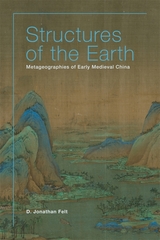 Structures of the Earth: Metageographies of Early Medieval China
D. Jonathan Felt
Harvard University Press, 2021 The traditional Chinese notion of itself as the “middle kingdom”—literally the cultural and political center of the world—remains vital to its own self-perceptions and became foundational to Western understandings of China. This worldview was primarily constructed during the earliest imperial unification of China during the Qin and Han dynasties (221 BCE–220 CE). But the fragmentation of empire and subsequent “Age of Disunion” (220–589 CE) that followed undermined imperial orthodoxies of unity, centrality, and universality. In response, geographical writing proliferated, exploring greater spatial complexities and alternative worldviews.
This book is the first study of the emergent genre of geographical writing and the metageographies that structured its spatial thought during that period. Early medieval geographies highlighted spatial units and structures that the Qin–Han empire had intentionally sought to obscure—including those of regional, natural, and foreign spaces. Instead, these postimperial metageographies reveal a polycentric China in a polycentric world. Sui–Tang (581–906 CE) officials reasserted the imperial model as spatial orthodoxy. But since that time these alternative frameworks have persisted in geographical thought, continuing to illuminate spatial complexities that have been incompatible with the imperial and nationalist ideal of a monolithic China at the center of the world.
The Structures of the Film Experience by Jean-Pierre Meunier: Historical Assessments and Phenomenological Expansions
Julian Hanich
Amsterdam University Press, 2019 For the first time this volume makes Jean-Pierre Meunier’s insightful thoughts on the film experience available for an English-speaking readership. Introduced and commented by specialists in film studies and philosophy, Meunier’s intricate phenomenological descriptions of the spectator’s engagement with fiction films, documentaries and home movies can reach the wide audience they have deserved ever since their publication in French in 1969.
The Structures of the Life World
Alfred Schutz and Thomas Luckmann
Northwestern University Press, 1989 The Structures of the Life-World is the final focus of twenty-seven years of Alfred Schutz's labor, encompassing the fruits of his work between 1932 and his death in 1959. This book represents Schutz's seminal attempt to achieve a comprehensive grasp of the nature of social reality. Here he integrates his theory of relevance with his analysis of social structures. Thomas Luckmann, a former student of Schutz's, completed the manuscript for publication after Schutz's untimely death.
The Structures of the Life World
Alfred Schutz and Thomas Luckmann
Northwestern University Press, 1973 The Structures of the Life-World is the final focus of twenty-seven years of Alfred Schutz's labor, encompassing the fruits of his work between 1932 and his death in 1959. This book represents Schutz's seminal attempt to achieve a comprehensive grasp of the nature of social reality. Here he integrates his theory of relevance with his analysis of social structures. Thomas Luckmann, a former student of Schutz's, completed the manuscript for publication after Schutz's untimely death.
 The Structures of Virtue and Vice
Daniel J. Daly
Georgetown University Press, 2023 Winner of the 2022 Catholic Media Association Award in Theology A new ethics for understanding the social forces that shape moral character.
It is easy to be vicious and difficult to be virtuous in today’s world, especially given that many of the social structures that connect and sustain us enable exploitation and disincentivize justice. There are others, though, that encourage virtue.
In his book Daniel J. Daly uses the lens of virtue and vice to reimagine from the ground up a Catholic ethics that can better scrutinize the social forces that both affect our moral character and contribute to human well-being or human suffering. Daly’s approach uses both traditional and contemporary sources, drawing on the works of Thomas Aquinas as well as incorporating theories such as critical realist social theory, to illustrate the nature and function of social structures and the factors that transform them. Daly’s ethics focus on the relationship between structure and agency and the different structures that enable and constrain an individual’s pursuit of the virtuous life. His approach defines with unique clarity the virtuous structures that facilitate a love of God, self, neighbor, and creation, and the vicious structures that cultivate hatred, intemperance, and indifference to suffering. In doing so, Daly creates a Catholic ethical framework for responding virtuously to the problems caused by global social systems, from poverty to climate change.
Structuring Diversity: Ethnographic Perspectives on the New Immigration
Edited by Louise Lamphere
University of Chicago Press, 1992 Through ethnographic research, sociologists and anthropologists explore the interaction of America's newcomers with established residents in six cities. Their analysis highlights the importance of class and power as immigrants interact in the workplace, at home, at school, and in community organizations.
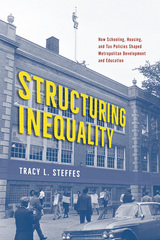 Structuring Inequality: How Schooling, Housing, and Tax Policies Shaped Metropolitan Development and Education
Tracy L. Steffes
University of Chicago Press, 2024 How inequality was forged, fought over, and forgotten through public policy in metropolitan Chicago.
As in many American metropolitan areas, inequality in Chicagoland is visible in its neighborhoods. These inequalities are not inevitable, however. They have been constructed and deepened by public policies around housing, schooling, taxation, and local governance, including hidden state government policies.
In Structuring Inequality, historian Tracy L. Steffes shows how metropolitan inequality in Chicagoland was structured, contested, and naturalized over time even as reformers tried to change it through school desegregation, affordable housing, and property tax reform. While these efforts had modest successes in the city and the suburbs, reformers faced significant resistance and counter-mobilization from affluent suburbanites, real estate developers, and other defenders of the status quo who defended inequality and reshaped the policy conversation about it. Grounded in comprehensive archival research and policy analysis, Structuring Inequality examines the history of Chicagoland’s established systems of inequality and provides perspective on the inequality we live with today.
 Structuring Inequality: How Schooling, Housing, and Tax Policies Shaped Metropolitan Development and Education
Tracy L. Steffes
University of Chicago Press, 2024 This is an auto-narrated audiobook version of this book.
How inequality was forged, fought over, and forgotten through public policy in metropolitan Chicago.
As in many American metropolitan areas, inequality in Chicagoland is visible in its neighborhoods. These inequalities are not inevitable, however. They have been constructed and deepened by public policies around housing, schooling, taxation, and local governance, including hidden state government policies.
In Structuring Inequality, historian Tracy L. Steffes shows how metropolitan inequality in Chicagoland was structured, contested, and naturalized over time even as reformers tried to change it through school desegregation, affordable housing, and property tax reform. While these efforts had modest successes in the city and the suburbs, reformers faced significant resistance and counter-mobilization from affluent suburbanites, real estate developers, and other defenders of the status quo who defended inequality and reshaped the policy conversation about it. Grounded in comprehensive archival research and policy analysis, Structuring Inequality examines the history of Chicagoland’s established systems of inequality and provides perspective on the inequality we live with today.
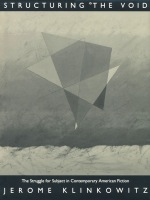 Structuring the Void: The Struggle for Subject in Contemporary American Fiction
Jerome Klinkowitz
Duke University Press, 1992 If, as the literary theorists of postmodernism contend, “content” does not exist, then how can fiction continue to be written? Jerome Klinkowitz, himself a veteran practitioner and theorist of fiction, addresses this question in Structuring the Void, an account of what today’s novelists and short story writers do when they produce a fictive work. Klinkowitz’s focus is on the way in which writers have turned this lack of content itself into subject matter, and, by thus “structuring the void,” have created a new form of fiction.
Among the writers Klinkowitz discusses are Richard Brautigan, Kurt Vonnegut, Max Apple, Saul Bellow, Erica Jong, Susan Quist, Gerald Rosen, Rob Swigart, and Grace Paley. He shows how, in the absence of subject matter, these writers persist in the act of structuring—by organizing autobiography as a narrative device, ritualizing national history and popular culture, or formalizing a comic response to a new imaginative state, the state of California. Klinkowitz also considers subjects such as gender and war, which, though they cannot be represented, nevertheless exercise contraints on a writer’s intention to structure.
What emerges from Klinkowitz’s analysis is a clear sense of what today’s fiction—and fiction writing—is about. As such, Structuring the Void will prove invaluable to anyone with an interest in contemporary literature.
 The Struggle against Dogmatism: Wittgenstein and the Concept of Philosophy
Oskari Kuusela
Harvard University Press, 2008 Searching for rigor and a clear grasp of the essential features of their objects of investigation, philosophers are often driven to exaggerations and harmful simplifications. According to Ludwig Wittgenstein’s provocative suggestion, this has to do with confusions relating to the status of philosophical statements. The Struggle against Dogmatism elucidates his view that there are no theses, doctrines, or theories in philosophy. Even when this claim is taken seriously, explanations of what it means are problematic—typically involving a relapse to theses. This book makes Wittgenstein’s philosophical approach comprehensible by presenting it as a response to specific problems relating to the practice of philosophy, in particular the problem of dogmatism.
Although the focus of this book is on Wittgenstein’s later work, Oskari Kuusela also discusses Wittgenstein’s early philosophy as expressed in the Tractatus, as well as the relation between his early and later work. In the light of this account of Wittgenstein’s critique of his early thought, Kuusela is able to render concrete what Wittgenstein means by philosophizing without theses or theories. In his later philosophy, Kuusela argues, Wittgenstein establishes a non-metaphysical (though not anti-metaphysical) approach to philosophy without philosophical hierarchies. This method leads to an increase in the flexibility of philosophical thought without a loss in rigor.
Struggle and Utopia at the End Times of Philosophy
François Laruelle
University of Minnesota Press, 2012 Very few thinkers have traveled the heretical path that François Laruelle walks between philosophy and non-philosophy. For Laruelle, the future of philosophy is problematic, but a mutation of its functions is possible. Up until now, philosophy has merely been a utopia concerned with the past and only provided the services of its conservation. We must introduce a rigorous and nonimaginary practice of a utopia in action, a philo-fiction—a close relative to science fiction. From here we can see the double meaning of the watchword, a tabula rasa of the future. This new destination is imposed by a specifically human messianism, an eschatology within the limits of the Man-in-person as antihumanist ultimatum addressed to the History of Philosophy. This book elucidates some of the fundamental problems of non-philosophy and takes on its detractors.
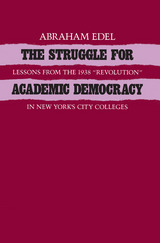 Struggle For Academic Democr
Abraham Edel
Temple University Press, 1990 On June 20,1938, the trustees of the City Colleges of New York changed the by-laws on the governance of the colleges. The transformation of New York City's colleges from autocratic to democratic rule virtually overnight was a revolutionary event in American higher education within the context of the 1930s. Abraham Edel writes of this revolution as an active participant and as an eminent philosopher who has experienced more than a half century of educational reform. The book focuses on the meaning and import of democratic organization in the governance of universities, but, at the same time, the author's personal reflections make it an intellectual memoir that charts the evolution of an idea.
Labor unionism, the Great Depression, and the rise of fascism shaped the political, social, economic, and intellectual climate of the 1930s. Edel relates this milieu to the authoritarian system of governance in the City Colleges. He describes the growth of a college teachers union, a sit-down strike by students, and the controversy, agitation, and organizing that hurled the teaching staff into political action. He identifies the pioneering significance of this revolution--this experiment in democracy at a time when dictatorship was viewed as more efficient--and examines the lessons learned by sudden rather than piecemeal reform, by human responses to institutional change, and by the relation of ideas to social movements.
After tracing the history of this transformation, Edel works toward a philosophy of democratic governance by evaluating the variety of claims for participation in terms of the ultimate mission of the university. Admitting a preference for democratic forms, Edel examines current issues in academic governance and the often acrimonious debate over participation by various groups.
The Struggle for an Enlightened Republic: Buenos Aires and Rivadavia
Klaus Gallo
University of London Press, 2006 From 1820 to 1827, the United Provinces of the River Plate - what is now Argentina - were largely dominated by the political influence of Bernardino Rivadavia. This book analyzes the evolution of politics, ideas, and culture in Buenos Aires during those years. The main focus of this work is the effects of Rivadavia's enlightened reforms on Buenos Aires society during the years 1821-24, his period as minister of government of the city. The book also reveals the causes of his eventual political downfall in 1827, after he became the first elected president of the reunified Argentine Republic.
 The Struggle for Auto Safety
Jerry L. Mashaw and David L. Harfst
Harvard University Press, 1990 Combining superb investigative reporting with incisive analysis, Jerry Mashaw and David Harfst provide a compelling account of the attempt to regulate auto safety in America. Their penetrating look inside the National Highway Traffic Safety Administration (NHTSA) spans two decades and reveals the complexities of regulating risk in a free society.
Hoping to stem the tide of rising automobile deaths and injuries, Congress passed the National Traffic and Motor Vehicle Safety Act in 1966. From that point on, automakers would build cars under the watchful eyes of the federal regulators at NHTSA. Curiously, however, the agency abandoned its safety mission of setting, monitoring, and enforcing performance standards in favor of the largely symbolic act of recalling defective autos.
Mashaw and Harfst argue that the regulatory shift from rules to recalls was neither a response to a new vision of the public interest nor a result of pressure by the auto industry or other interest groups. Instead, the culprit was the legal environment surrounding NHTSA and other regulatory agencies such as the EPA, OSHA, and the Consumer Product Safety Commission. The authors show how NHTSA's decisions as well as its organization, processes, and personnel were reoriented in order to comply with the demands of a legal culture that proved surprisingly resistant to regulatory pressures.
This broad-gauged view of NHTSA has much to say about political idealism and personal ambition, scientific commitment and professional competition, long-range vision and political opportunism. A fascinating illustration of America's ambivalence over whether government is a source of--or solution to--social ills, The Struggle for Auto Safety offers important lessons about the design and management of effective health and safety regulatory agencies today.
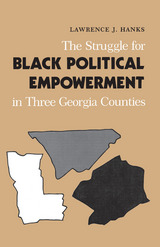 The Struggle for Black Political Empowerment in Three Georgia Counties: Three Georgia Counties
Lawrence J. Hanks
University of Tennessee Press, 1990 Although the Voting Rights Act of 1965 removed the last legal barriers to voting in the South, the anticipated increase in black political power has not been realized. In his analysis of black political participation in three predominantly black Georgia counties between 1960 and 1982, Lawrence J. Hanks seeks to explain why black political empowerment has not increased as expected but also why it has met with such widely varying degrees of success.
Why did blacks in come counties achieve empowerment while others sis not? Arguing that models that focus on individual voting patterns or on political barriers to empowerment fail to account for the varying rates of black participation, hanks draws instead on the literature of collective action. He finds that only in those counties where there was a successful black political organization, backed by strong leaders and sufficient resources, did blacks achieve political empowerment. Once established, such an organization gained popular support through programs of economic development and was able to overcome barriers like ignorance, poverty, and fear and thus promote effective political mobilization.
Approaching his subject historically, Hanks tells the real story of real people working for political change at the local level. He concludes that the franchise alone does not insure political effectiveness, and that blacks need to work toward greater organizational, economic, and political sophistication in order to reap the benefits of the vote.
The Struggle for Constitutional Justice in Post-Communist Europe
Herman Schwartz
University of Chicago Press, 2000 In the former Eastern Bloc countries, one of the most difficult and important aspects of the transition to democracy has been the establishment of constitutional justice and the rule of law. Herman Schwartz's wide-ranging book, backed with rich historical detail and a massive array of research, is the first to chronicle and analyze the rise and troubles of constitutional courts in this changing region.
"Those who are interested in understanding the behavior of constitutional courts in transitional regimes cannot afford to ignore this important book. . . . [It] is fecund with hypotheses of interest to political scientists, and we are indebted to Professor Schwartz for his comprehensive analysis."—James L. Gibson, Law and Politics Book Review
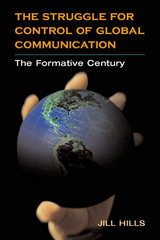 The Struggle for Control of Global Communication: The Formative Century
Jill Hills
University of Illinois Press, 2002 Tracing the development of communication markets and the regulation of international communications from the 1840s through World War I, Jill Hills examines the political, technological, and economic forces at work during the formative century of global communication. Hills analyzes power relations within the arena of global communications from the inception of the telegraph through the successive technologies of submarine telegraph cables, ship-to-shore wireless, broadcast radio, shortwave wireless, the telephone, and movies with sound. As she shows, global communication began to overtake transportation as an economic, political, and social force after the inception of the telegraph, which shifted communications from national to international. From that point on, information was a commodity and ownership of the communications infrastructure became valuable as the means of distributing information. The struggle for control of that infrastructure occurred in part because British control of communications hindered the growing economic power of the United States. Hills outlines the technological advancements and regulations that allowed the United States to challenge British hegemony and enter the global communications market. She demonstrates that control of global communication was part of a complex web of relations between and within the government and corporations of Britain and the United States. Detailing the interplay between American federal regulation and economic power, Hills shows how these forces shaped communications technologies and illuminates the contemporary systems of power in global communications.
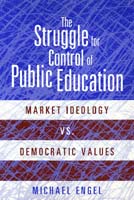 Struggle For Control Of Public Education
Michael Engel
Temple University Press, 2000 "One hundred years ago, children were kept out of school to be used as a cheap factory workforce; today, they are kept in school to become a cheap workforce in the factories of the future."
Seduced by the language of the market economy, those making decisions about education today argue that market strategies promote democratic educational reform, when really they promote market reform of education. Michael Engel argues against this tendency, siding with democratic values -- which encourage openness, creativity, social awareness, and idealism, whereas market values uphold individual achievement, competition, economic growth, and national security.
Behind the facade of progressive rhetoric, advocates of these corporate models have succeeded in imposing their definition of school reform through federal and state policy makers. As a result, communities lose control of their schools, teachers lose control of their work, and students lose control of their schools, teachers lose control of their work, and students lose control of their futures. Engel attacks the increasing dominance of market ideology in educational policy and extends his critique beyond such trends in school reform as vouchers, charter schools, and "contracting out" to include issues such as decentralization, computer technology, and standards.
The debate over privatization amounts to ideological warfare between democratic and market values. The question is not so much about "school choice" as it is about the values Americans want at the root of their society. Unprecedented in its value-based challenge to the threat of market ideology to educational policy, The Struggle for Control of Public Education is a sophisticated call for a return to community-controlled schools and democratic values. This argument offers theoretical and practical models crafted in the contemporary feminist and social reconstructionist tradition. Readers interested in the study of educational policies, philosophy, and policy will find this book engaging.
The Struggle for Food Sovereignty: Alternative Development and the Renewal of Peasant Societies Today
Edited by Remy Herrera and Kin Chi Lau
Pluto Press, 2015 Food sovereignty—or the right of a people to operate and control their own food and agricultural systems—has all but disappeared throughout much of the world, usurped by multinational corporations engaging in industrialized farming and global trade. The Struggle for Food Sovereignty examines the prospects and struggles of family farms, peasants, and others in the fight for control over local sustenance and rights of access to land and food. The authors examine the issues in both the global north and south, finding a common vision even amid apparently radically differing political and economic conditions.
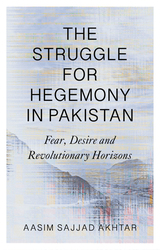 The Struggle for Hegemony in Pakistan: Fear, Desire and Revolutionary Horizons
Aasim Sajjad-Akhtar
Pluto Press, 2022 'A major analysis of our world's political crisis' - Joel Wainwright
The collapse of neoliberal hegemony in the western world following the financial crash of 2007-8 and subsequent rise of right-wing authoritarian personalities has been described as a crisis of 'the political' in western societies. But the crisis must be seen as global, rather than focusing on the west alone.
Pakistan is experiencing rapid financialization and rapacious capture of natural resources, overseen by the country's military establishment and state bureaucracy. Under their watch, trading and manufacturing interests, property developers and a plethora of mafias have monopolized the provision of basic needs like housing, water and food, whilst also feeding conspicuous consumption by a captive middle-class.
Aasim Sajjad-Akhtar explores neoliberal Pakistan, looking at digital technology in enhancing mass surveillance, commodification and atomization, as well as resistance to the state and capital. Presenting a new interpretation of our global political-economic moment, he argues for an emancipatory political horizon embodied by the 'classless' subject.
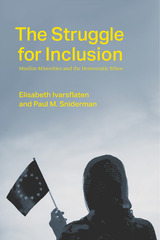 The Struggle for Inclusion: Muslim Minorities and the Democratic Ethos
Elisabeth Ivarsflaten and Paul M. Sniderman
University of Chicago Press, 2022 The politics of inclusion is about more than hate, exclusion, and discrimination. It is a window into the moral character of contemporary liberal democracies. The Struggle for Inclusion introduces a new method to the study of public opinion: to probe, step by step, how far non-Muslim majorities are willing to be inclusive, where they draw the line, and why they draw it there and not elsewhere. Those committed to liberal democratic values and their concerns are the focus, not those advocating exclusion and intolerance.
Notwithstanding the turbulence and violence of the last decade over issues of immigration and of Muslims in the West, the results of this study demonstrate that the largest number of citizens in contemporary liberal democracies are more open to inclusion of Muslims than has been recognized. Not less important, the book reveals limits on inclusion that follow from the friction between liberal democratic values. This pioneering work thus brings to light both pathways to progress and polarization traps.
 The Struggle for Liberation: A History of the Rwandan Civil War, 1990-1994
John Burton Kegel
Ohio University Press, 2025 The story of the Rwandan Genocide has been told many times by scholars and journalists. Over the course of a hundred days in the spring and summer of 1994, about eight hundred thousand Tutsi and moderate Hutu were murdered by their extremist Hutu compatriots. Those hundred days were the final phase of a four-year civil war, also known as the Struggle for Liberation, which formed the immediate context of the genocide. Though scholars have researched preparations for the genocide and the international community’s role in it, none has placed the Struggle for Liberation at the heart of the narrative. However, the preparation of the genocide, the rise and fall of the moderate opposition, the degradation of the Forces armées rwandaises (FAR) from a respected fighting force to a genocidal militia, the role of the international community, the Arusha negotiations, and the execution of the genocide all took place in the context of that war. John Burton Kegel contends that the Struggle for Liberation forms the bedrock of any genuine understanding of Rwanda between 1990 and 1994, and indeed beyond. The Struggle for Liberation, which eventually led to the genocide, was fought between the FAR and the civilians and soldiers of the Rwandan Patriotic Front (RPF) and its armed wing, the Rwandan Patriotic Army (RPA). The civil war started on October 1, 1990, when the RPF entered Rwanda from Uganda, where Rwandan refugees had lived throughout the Great Lakes region since roughly 1959. This book traces the history of those refugees—and Rwanda’s deeper Hutu-Tutsi divide—from the precolonial period up to 1990. It also provides a wholly new take on how the disciplined RPF, which rules Rwanda to this day, was born and organized.
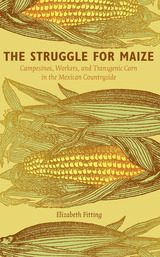 The Struggle for Maize: Campesinos, Workers, and Transgenic Corn in the Mexican Countryside
Elizabeth Fitting
Duke University Press, 2011 When scientists discovered transgenes in local Mexican corn varieties in 2001, their findings intensified a debate about not only the import of genetically modified (GM) maize into Mexico but also the fate of the peasantry under neoliberal globalization. While the controversy initially focused on the extent to which gene flow from transgenic to local varieties threatens maize biodiversity, anti-GM activists emphasized the cultural significance of the crop in Mexico and demanded that campesinos and consumers have a voice in the creation of GM maize and rural policies. In The Struggle for Maize, Elizabeth Fitting explores the competing claims of the GM corn debate in relation to the livelihood struggles of small-scale maize producers, migrants, and maquiladora workers from the southern Tehuacán Valley. She argues that the region’s biodiversity is affected by state policies that seek to transform campesinos into entrepreneurs and rural residents into transnational migrant laborers. While corn production and a campesino identity remain important to an older generation, younger residents have little knowledge of or interest in maize agriculture; they seek out wage labor in maquiladoras and the United States. Fitting’s ethnography illustrates how agricultural producers and their families respond creatively to economic hardship and Mexico’s “neoliberal corn regime,” which promotes market liberalization, agricultural “efficiency,” and the reduction of state services over domestic maize production and food sovereignty.
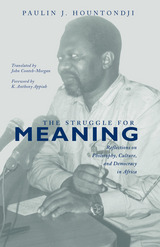 The Struggle For Meaning: Reflections on Philosophy, Culture, and Democracy in Africa
Paulin J. Hountondji
Ohio University Press, 2002 The Struggle for Meaning is a landmark publication by one of African philosophy’s leading figures, Paulin J. Hountondji, best known for his critique of ethnophilosophy in the late 1960s and early 1970s. In this volume, he responds with autobiographical and philosophical reflection to the dialogue and controversy he has provoked. He discusses the ideas, rooted in the work of such thinkers as Husserl and Hountondji’s former teachers Derrida, Althusser, and Ricoeur, that helped shape his critique. Applying his philosophical ideas to the critical issues of democracy, culture, and development in Africa today, he addresses three crucial topics: the nexus between scientific extraversion and economic dependence; the nature of endogenous traditions of thought and their relationship with modern science; and the implications—for political pluralism and democracy—of the emergence of “philosophies of subject” in Africa. While the book’s immediate concern is with Africa, the densely theoretical nature of its analyses, and its bearing on current postmodern theories of the “other,” will make this timely and elegant translation of great interest to many disciplines, especially ethnic, gender, and multicultural studies.
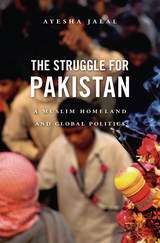 The Struggle for Pakistan: A Muslim Homeland and Global Politics
Ayesha Jalal
Harvard University Press, 2014 Established as a homeland for India’s Muslims in 1947, Pakistan has had a tumultuous history. Beset by assassinations, coups, ethnic strife, and the breakaway of Bangladesh in 1971, the country has found itself too often contending with religious extremism and military authoritarianism. Now, in a probing biography of her native land amid the throes of global change, Ayesha Jalal provides an insider’s assessment of how this nuclear-armed Muslim nation evolved as it did and explains why its dilemmas weigh so heavily on prospects for peace in the region.
“[An] important book…Ayesha Jalal has been one of the first and most reliable [Pakistani] political historians [on Pakistan]…The Struggle for Pakistan [is] her most accessible work to date…She is especially telling when she points to the lack of serious academic or political debate in Pakistan about the role of the military.”
—Ahmed Rashid, New York Review of Books
“[Jalal] shows that Pakistan never went off the rails; it was, moreover, never a democracy in any meaningful sense. For its entire history, a military caste and its supporters in the ruling class have formed an ‘establishment’ that defined their narrow interests as the nation’s.”
—Isaac Chotiner, Wall Street Journal
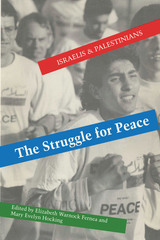 The Struggle for Peace: Israelis and Palestinians
Edited by Elizabeth Warnock Fernea and Mary Evelyn Hocking
University of Texas Press, 1992 The determination of ordinary people to end regional and global conflicts is powerful despite the forces opposing them. The Struggle for Peace explores how average citizens on both sides of the Israeli-Palestinian conflict worked for peace in the late twentieth century. Essays by noted scholars are juxtaposed with profiles of individual Israelis and Palestinians involved in peace activism. What emerges is a unique perspective on the prospects for peace in this troubled area.
Coordinated with a documentary film of the same name, the book is designed as a tool for the study of conflict resolution generally and the Israeli-Palestinian conflict in particular. The twelve original essays deal with the issues from different disciplinary perspectives: political science (Yehoshafat Harkabi, A. R. Norton, Muhammad Muslih, and Robert Vitalis); history (Avraham Zilkha and Joel Beinin); anthropology (Robert Rubinstein); sociology (Salim Tamari); film (Steven Talley); law (Edward Sherman); and international peacekeeping (Christian Harleman). The human side of the struggle is presented through brief biographies and portraits of twenty-five ordinary Israelis and Palestinians involved in peace activities in Israel and the West Bank.
The Struggle for Social Security, 1900–1935
Roy Lubove
University of Pittsburgh Press, 1986 For the first one-third of the twentieth century, proposals for workmen's compensation, unemployment or health insurance, and widow's or old age pensions met steep resistance on the grounds that such programs would diminish the dignity of the individual. In this book, Roy Lubove examines the clash between the traditional American ethic of individualism and voluntarism and the push for an active government role in social welfare assistance, and the battles within the social security movement itself. He concludes his study with the actual legislative enactments of 1935 when, after the experience of the Great Depression, social insurance came into its own.
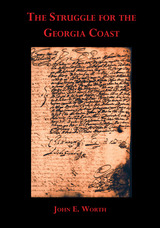 The Struggle for the Georgia Coast
John E. Worth
University of Alabama Press, 2007 In 1733, General James Edward Oglethorpe officially established the colony of Georgia, and within three years had fortified the coast southward toward St. Augustine. Although this region, originally known as the provinces of Guale and Mocama, had previously been under Spanish control for more than a century, territorial fighting had emptied the region of Spanish missionaries, soldiers, and their Indian allies. Spanish officials maintained that the long history of Spanish authority over the territory guaranteed Spain the right to defy and repel the English intruders. By 1739, with diplomatic negotiations failing and the potential for war imminent, King Philip V requested that Don Manuel de Montiano, Governor of Spanish Florida, provide him with every document from both governmental and ecclesiastical sources that would demonstrate prior Spanish presence and control over the region. Original documents and translations were delivered within the year and safely filed for future use--then forgotten. With the outbreak of open war six months earlier, the diplomatic utility of the documents had passed.
For over 250 years, the documents languished safely in the Archive of the Indies in Seville until recognized, recovered, translated, and published by John Worth. Within this volume, Worth brings to light the history of the documents, provides complete translations and full explanations of their contents and a narrative exposition of the Spanish presence along the Atlantic coast never before fully understood. David Hurst Thomas provides an introduction that places Worth's translations and his historical overview into the context of ongoing archaeological excavations on the Georgia coast. With the publication of this volume, one of the least known chapters of Georgia history is finally examined in detail.
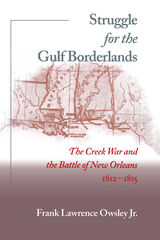 Struggle for the Gulf Borderlands: The Creek War and the Battle of New Orleans, 1812-1815
Frank L. Owsley Jr.
University of Alabama Press, 2000 Examination of the Creek War which integrates that struggle into the larger conflict that broke out in 1812 between Great Britain and the United States
Using American, British, and Spanish documents, many previously unknown, Frank Owsley’s study establishes the Creek War and the struggle to control the Gulf borderlands as integral parts of the War of 1812. The war between the United States and a large part of the Creek nation is usually studied as local or regional history. These documentary sources, however, show the larger picture. They show Spain to have been a major influence in the Creek War and indicate the extent to which the British were aiding the Indians and using them to redirect American troops. On the other hand, Andrew Jackson, in charge of the American forces on the Gulf Coast, emerged from the conflict as a first-rate military commander. His victories on the Gulf gave the West a leader and aided in shifting political power from the eastern seaboard to the South and West.
Owsley concludes that the victories in the Gulf region were of sufficient magnitude to justify the claim that the War of 1812 was not a draw but a decisive American victory and that had there been a general of Jackson's caliber on the northern frontier, the United States might have had a clear-cut victory there.
As a result of the war, the United States held its claim on Louisiana, annexed the Mobile district, forced Spain out of Florida, and broke the power of the southern Indians, thus opening vast lands for settlement from the new nation on the eastern seaboard.
The Struggle for the Soul of Journalism: The Pulpit versus the Press, 1833-1923
Ronald R. Rodgers
University of Missouri Press, 2018 In this study, Ronald R. Rodgers examines several narratives involving religion’s historical influence on the news ethic of journalism: its decades-long opposition to the Sunday newspaper as a vehicle of modernity that challenged the tradition of the Sabbath; the parallel attempt to create an advertising-driven Christian daily newspaper; and the ways in which religion—especially the powerful Social Gospel movement—pressured the press to become a moral agent. The digital disruption of the news media today has provoked a similar search for a news ethic that reflects a new era—for instance, in the debate about jettisoning the substrate of contemporary mainstream journalism, objectivity. But, Rodgers argues, before we begin to transform journalism’s present news ethic, we need to understand its foundation and formation in the past.
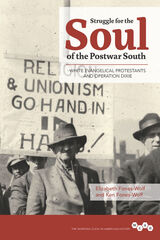 Struggle for the Soul of the Postwar South: White Evangelical Protestants and Operation Dixie
Elizabeth Fones-Wolf and Ken Fones-Wolf
University of Illinois Press, 2015 In 1946, the Congress of Industrial Organizations (CIO) undertook Operation Dixie, an initiative to recruit industrial workers in the American South. Elizabeth and Ken Fones-Wolf plumb rarely used archival sources and rich oral histories to explore the CIO's fraught encounter with the evangelical Protestantism and religious culture of southern whites.
The authors' nuanced look at working class religion reveals how laborers across the surprisingly wide evangelical spectrum interpreted their lives through their faith. Factors like conscience, community need, and lived experience led individual preachers to become union activists and mill villagers to defy the foreman and minister alike to listen to organizers. As the authors show, however, all sides enlisted belief in the battle. In the end, the inability of northern organizers to overcome the suspicion with which many evangelicals viewed modernity played a key role in Operation Dixie's failure, with repercussions for labor and liberalism that are still being felt today.
Identifying the role of the sacred in the struggle for southern economic justice, and placing class as a central aspect in southern religion, Struggle for the Soul of the Postwar South provides new understandings of how whites in the region wrestled with the options available to them during a crucial period of change and possibility.
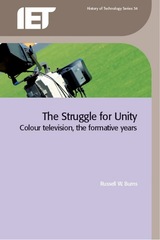 The Struggle for Unity: Colour television, the formative years
Russell W. Burns
The Institution of Engineering and Technology, 2008 The Struggle for Unity: Colour television, the formative years traces the evolution of colour television from 1928, when rudimentary colour television was demonstrated for the first time, to c.1966, when the NTSC system and its variants, the PAL and SECAM systems, became widely available for the entertainment, education and enlightenment of society. Among the many topics discussed in the book, mention is made of the following: compatibility and non-compatibility; mechanical and all-electronic systems; field, line and dot sequential scanning; bandwidth constraints and band-sharing techniques; the CBS-RCA conflict; the relative merits of the different systems; the attempt to achieve unity of purpose in Europe; standards; and the development of colour cameras and display tubes. The book, which is based predominantly on written primary source material, does not simply provide a chronicle of dates and descriptions of events, devices and systems. Rather, it discusses the essential factors of colour television history from a general, technical and political viewpoint. Great care has been taken to ensure that an unbiased, accurate and balanced history has been written. Numerous references are given at the end of each chapter and the book is profusely illustrated.
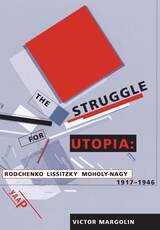 The Struggle for Utopia: Rodchenko, Lissitzky, Moholy-Nagy, 1917-1946
Victor Margolin
University of Chicago Press, 1997 Following World War I, a new artistic-social avant-garde emerged with the ambition to engage the artist in the building of social life. Through close readings of the works of Alexander Rodchenko, El Lissitzky, and László Moholy-Nagy whose careers covered a broad range of artistic practices and political situations, Victor Margolin examines the way these three artists negotiated the changing relations between their social ideals and the political realities they confronted. Focusing on the difficult relationship between art and social change, Margolin brings important new insights to the understanding of the avant-garde's role in a period of great political complexity.
"An ambitious effort. This book puts the masters of European Modernism into perfect focus as inventors, propagators, and practitioners of a visual language that continues to hold sway over contemporary graphic style."—Steven Heller
"Worth the wait. . . . Margolin usefully presents what he calls the 'failed hope' of this movement in this valuable effort."—Publishers Weekly
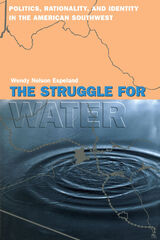 The Struggle for Water: Politics, Rationality, and Identity in the American Southwest
Wendy Nelson Espeland
University of Chicago Press, 1998 Nearly fifty years ago, the Bureau of Reclamation proposed building a dam at the confluence of two rivers in Central Arizona. While the dam would bring valuable water to this arid plain, it would also destroy a wildlife habitat, flood archaeological sites, and force the Yavapai Indians off their ancestral home. The Struggle for Water is not only the fascinating story of this controversial and ultimately thwarted public works project but also a study of rationality as a cultural, organizational, and political construct.
In the 1970s, the three groups most intimately involved in the Orme Dam—younger Bureau of Reclamation employees committed to "rational choice" decision making, older Bureau engineers committed to the dam, and the Yavapai community—all found themselves and their values transformed by their struggles. Wendy Nelson Espeland lays bare the relations between interests and identities that emerged during the conflict, creating a contemporary tale of power and colonization, bureaucracies and democratic practice, that asks the crucial question of what it means to be "rational."
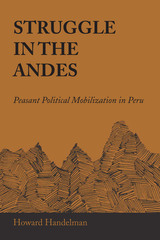 Struggle in the Andes: Peasant Political Mobilization in Peru
By Howard Handelman
University of Texas Press, 1975 A massive land-seizure movement first erupted in Peru in 1958 and spread across the Andean highlands in 1963–1964. Several hundred peasant communities in the Peruvian Andes occupied neighboring haciendas in an attempt to retake lands they felt had been stolen from them over the years. Hacienda peasants also participated in this movement, forming peasant sindicatos (unions) to improve their labor conditions. The land-seizure movement brought with it an upsurge in community political mobilization. Throughout the highlands, village leaders banded together in regional federations, often allying themselves with progressive or radical urban groups. Radical activists from labor unions and university student groups joined with indigenous peasant leaders, breaking down the highland peasantry’s traditional isolation from the political system. Struggle in the Andes is an analysis of the causes and consequences of extensive social and political mobilization among Peru’s peasant population in the 1960s. In addition to describing the growth of the peasant land movement, Howard Handelman investigates the social and economic conditions that contributed to rural unrest. Using data that he collected in forty-one diverse highland communities, Handelman examines the correlates of peasant political activity, concluding that land seizures in the traditional southern sierra had different origins and political implications than did unrest in the more socioeconomically modernized central highlands. The data suggest a model of peasant mobilization that calls into question prevailing scholarly hypotheses on the relationships between modernization, peasant political mobilization, and radicalization. Handelman discusses the land-reform program and the accompanying rural mobilization that was being implemented by Peru’s reformist military regime. Using his model of peasant mobilization, he speculates on the possible effects of the government’s contemporary programs on future peasant political behavior.
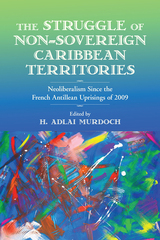 The Struggle of Non-Sovereign Caribbean Territories: Neoliberalism since the French Antillean Uprisings of 2009
H. Adlai Murdoch
Rutgers University Press, 2021 The Struggle of Non-Sovereign Caribbean Territories is an essay collection made up of two sections; in the first, a group of anglophone and francophone scholars examines the roots, effects and implications of the major social upheaval that shook Guadeloupe, Martinique, French Guiana, and Réunion in February and March of 2009. They clearly demonstrate the critical role played by community activism, art and media to combat politico-economic policies that generate (un)employment, labor exploitation, and unattended health risks, all made secondary to the supremacy of profit. In the second section, additional scholars provide in-depth analyses of the ways in which an insistence on capital accumulation and centralization instantiated broad hierarchies of market-driven profit, capital accumulation, and economic exploitation upon a range of populations and territories in the wider non-sovereign and nominally sovereign Caribbean from Haiti to the Dutch Antilles to Puerto Rico, reinforcing the racialized patterns of socioeconomic exclusion and privatization long imposed by France on its former colonial territories.
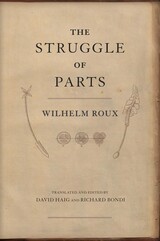 The Struggle of Parts
Wilhelm Roux
Harvard University Press, 2024 A landmark work of nineteenth-century developmental and evolutionary biology that takes the Darwinian struggle for existence into the organism itself.
Though he is remembered primarily as a pioneer of experimental embryology, Wilhelm Roux was also a groundbreaking evolutionary theorist. Years before his research on chicken and frog embryos cemented his legacy as an experimentalist, Roux endorsed the radical idea that a “struggle for existence” within organisms—between organs, tissues, cells, and even subcellular components—drives individual development.
Convinced that external competition between individuals is inadequate to explain the exquisite functionality of bodily parts, Roux aimed to uncover the mechanistic principles underlying self-organization. The Struggle of Parts was his attempt to provide such a theory. Combining elements of Darwinian selection and Lamarckian inheritance of acquired characteristics, the work advanced a materialist explanation of how “purposiveness” within the organism arises as the body’s components compete for space and nourishment. The result, according to Charles Darwin, was “the most important book on evolution which has appeared for some time.”
Translated into English for the first time by evolutionary biologist David Haig and Richard Bondi, The Struggle of Parts represents an important forgotten chapter in the history of developmental and evolutionary theory.
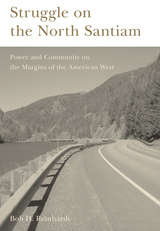 Struggle on the North Santiam: Power and Community on the Margins of the American West
Bob H Reinhardt
Oregon State University Press, 2020 A sixty-mile forested corridor dotted with small towns, stretching from the Willamette Valley to the Cascade mountains, Oregon’s North Santiam Canyon is like many other marginalized places in the American West. Its residents have long sought to exercise limited power in the face of real and exaggerated external forces: global economic systems, cultural power emanating from larger cities, and political forces in the form of state and federal government agencies. Struggle on the North Santiam examines how these Oregonians have responded to, interacted with, and sometimes gotten the better of such external forces.
In this deeply researched account, historian Bob H. Reinhardt connects the North Santiam Canyon’s history to that of the Pacific Northwest and the United States more broadly. Readers will learn about specific events that illuminate themes in the region’s history: railroad development as seen through the failed dreams of the Oregon Pacific Railroad, federal land scams in the Oregon land fraud trials of the early twentieth century, the causes and consequences of mid-century river development projects like Detroit Dam, the post-war booms and busts of the timber industry, the spotted owl/ancient forest debate in the 1980s and 1990s, and the promises and perils of Oregon’s recreational tourism economy.
From nineteenth-century interactions between Native and non-Native peoples to the changing fortunes of the timber industry and questions about economic and environmental sustainability in the twenty-first century, the book offers important insights into power dynamics in small communities and marginal places. Struggle on the North Santiam will be of interest to scholars of the American West and thoughtful readers interested in Oregon and Pacific Northwest history.
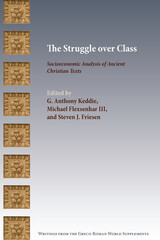 The Struggle over Class: Socioeconomic Analysis of Ancient Christian Texts
G. Anthony Keddie
SBL Press, 2021 An interdisciplinary discussion engaging classics, archaeology, religious studies, and the social sciences
The Struggle over Class brings together scholars from the fields of New Testament and early Christianity to examine Christian texts in light of the category of class. Historically rigorous and theoretically sophisticated, this collection presents a range of approaches to, and applications of, class in the study of the epistles, the gospels, Acts, apocalyptic texts, and patristic literature. Contributors Alicia J. Batten, Alan H. Cadwallader, Cavan W. Concannon, Zeba Crook, James Crossley, Lorenzo DiTommaso, Philip F. Esler, Michael Flexsenhar III, Steven J. Friesen, Caroline Johnson Hodge, G. Anthony Keddie, Jaclyn Maxwell, Christina Petterson, Jennifer Quigley, Elisabeth Schüssler Fiorenza, Daniëlle Slootjes, and Emma Wasserman challenge both scholars and students to articulate their own positions in the ongoing scholarly struggle over class as an analytical category.
 Struggle over Identity: The Official and the Alternative "Belarusianness"
Nelly Bekus
Central European University Press, 2010 Rejecting the cliché about “weak identity and underdeveloped nationalism,” Bekus argues for the co-existence of two parallel concepts of Belarusianness—the official and the alternative one—which mirrors the current state of the Belarusian people more accurately and allows for a different interpretation of the interconnection between the democratization and nationalization of Belarusian society. The book describes how the ethno-symbolic nation of the Belarusian nationalists, based on the cultural capital of the Golden Age of the Belarusian past (17th century) competes with the “nation” institutionalized and reified by the numerous civic rituals and social practices under the auspices of the actual Belarusian state. Comparing the two concepts not only provides understanding of the logic that dominates Belarusian society’s self-description models, but also enables us to evaluate the chances of alternative Belarusianness to win this unequal struggle over identity.
 Struggle Over Utah's San Rafael Swell: Wilderness, National Conservation Areas, and National Monuments
Jeffrey O. Durrant
University of Arizona Press, 2007 The vast public lands of the American West are being transformed today, not geologically but conceptually. A century ago, visitors to western public lands were likely to be ranchers or miners. Today, the lands are popular destinations for campers, hikers, rock climbers, river runners, artists, and off-road-vehicle enthusiasts. These new visitors have proved to be a challenge for managers of public lands, in particular the federal Bureau of Land Management. Perhaps no area has been more affected by changing users and shifting policies than the San Rafael Swell, a million-acre expanse in southeastern Utah. In this insightful and useful book, Jeffrey Durrant follows the trail of decisions and events that have had—and continue to have—a transformative impact on this ancient land.
In detailing political and environmental squabbles over the San Rafael Swell, Durrant illuminates issues that confront land managers, bureaucrats, and elected officials throughout the country. He describes struggles between county commissioners and environmental activists, conflicts over water rights, proposals that repeatedly fail to gain government approval, and political posturings. Caught in the crossfire, and often overwhelmed, the Bureau of Land Management has seen its long-time mission—once centered on grazing and mining rights—transmogrify into a new and, to some, unsettling responsibility for recreation and preservation.
The sandstone crags and twisting valleys of the San Rafael Swell present a formidable landscape, but as this book clearly shows, the political landscape may be even more daunting, strewn with bureaucratic boulders and embedded with fixed positions on the functions and values of public land.
Struggles for Justice: Social Responsibility and the Liberal State
Alan Dawley
Harvard University Press, 1991 In this new interpretation of the making of modern America, prize-winning historian Alan Dawley traces the group struggles involved in the nation’s rise to power. Probing the dynamics of social change, he explores tensions between industrial workers and corporate capitalists, Victorian moralists and New Women, native Protestants and Catholic immigrants. Thoughtful analysis and sparkling narrative combine to make this book a major challenge to earlier interpretations of the period.
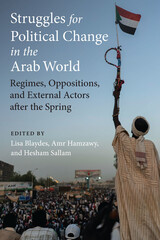 Struggles for Political Change in the Arab World: Regimes, Oppositions, and External Actors after the Spring
Edited by Lisa Blaydes, Amr Hamzawy, and Hesham Sallam
University of Michigan Press, 2022 The advent of the Arab Spring in late 2010 was a hopeful moment for partisans of progressive change throughout the Arab world. Authoritarian leaders who had long stood in the way of meaningful political reform in the countries of the region were either ousted or faced the possibility of political if not physical demise. The downfall of long-standing dictators as they faced off with strong-willed protesters was a clear sign that democratic change was within reach. Throughout the last ten years, however, the Arab world has witnessed authoritarian regimes regaining resilience, pro-democracy movements losing momentum, and struggles between the first and the latter involving regional and international powers.
This volume explains how relevant political players in Arab countries among regimes, opposition movements, and external actors have adapted ten years after the onset of the Arab Spring. It includes contributions on Egypt, Morocco, Kuwait, Saudi Arabia, Syria, Algeria, Sudan, Lebanon, Iraq, Jordan, Yemen, and Tunisia. It also features studies on the respective roles of the United States, China, Iran, and Turkey vis-à-vis questions of political change and stability in the Arab region, and includes a study analyzing the role of Saudi Arabia and its allies in subverting revolutionary movements in other countries.
Struggles for Power in the Kingdom of Italy: The Hucpoldings, c. 850-c.1100
Edoardo Manarini
Amsterdam University Press, 2022 This book presents a detailed study of the Hucpoldings, an elite group in Carolingian and post-Carolingian Italy. Though the Hucpoldings have not received extensive treatment in previous anglophone scholarship, they had a key influence in much of what was happening in this period. Manarini’s groundbreaking study highlights the dramatic geopolitical changes surrounding this kinship group in the kingdom of Italy across three crucial centuries. The research reconstructs political events associated with every identifiable member of the kinship, as well as inquiring into their patrimony and their networks of relationships and patronage. Finally, it examines the distinctive characteristics of the group to gain a clearer picture of the nature of their power, their memory strategies and the shared perceptions and self-awareness of group members.
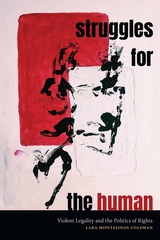 Struggles for the Human: Violent Legality and the Politics of Rights
Lara Montesinos Coleman
Duke University Press, 2024 In Struggles for the Human, Lara Montesinos Coleman blends ethnography, political philosophy, and critical theory to reorient debates on human rights through attention to understandings of legality, ethics, and humanity in anticapitalist and decolonial struggle. Drawing on her extensive involvement with grassroots social movements in Colombia, Coleman observes that mainstream expressions of human rights have become counterparts to capitalist violence, even as this discourse disavows capitalism’s deadly implications. She rejects claims that human rights are inherently tied to capitalism, liberalism, or colonialism, instead showing how human rights can be used to combat these forces. Coleman demonstrates that social justice struggles that are rooted in marginalized communities’ lived experiences can reframe human rights in order to challenge oppressive power structures and offer a blueprint for constructing alternative political economies. By examining the practice of redefining human rights away from abstract universals and contextualizing them within concrete struggles for justice, Coleman reveals the transformative potential of human rights and invites readers to question and reshape dominant legal and ethical narratives.
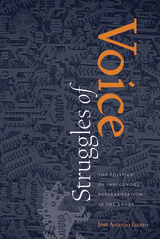 Struggles of Voice: The Politics of Indigenous Representation in the Andes
Jose Antonio Lucero
University of Pittsburgh Press, 2008 Over the last two decades, indigenous populations in Latin America have achieved a remarkable level of visibility and political effectiveness, particularly in Ecuador and Bolivia. In Struggles of Voice, José Antonio Lucero examines these two outstanding examples in order to understand their different patterns of indigenous mobilization and to reformulate the theoretical model by which we link political representation to social change.
Building on extensive fieldwork, Lucero considers Ecuador's united indigenous movement and compares it to the more fragmented situation in Bolivia. He analyzes the mechanisms at work in political and social structures to explain the different outcomes in each case. Lucero assesses the intricacies of the many indigenous organizations and the influence of various NGOs to uncover how the conflicts within social movements, the shifting nature of indigenous identities, and the politics of transnationalism all contribute to the success or failure of political mobilization.
Blending philosophical inquiry with empirical analysis, Struggles of Voice is an informed and incisive comparative history of indigenous movements in these two Andean countries. It helps to redefine our understanding of the complex intersections of social movements and political representation.
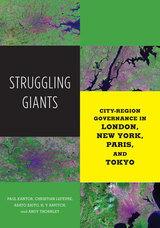 Struggling Giants: City-Region Governance in London, New York, Paris, and Tokyo
Paul Kantor
University of Minnesota Press, 2012 Throughout the past thirty years a small number of city-regions have achieved unprecedented global status in the world economy while undergoing radical changes. Struggling Giants examines the transformation of four of the most significant metropolises: London, New York, Paris, and Tokyo. This volume analyzes the thorniest issues these sprawling city-regions have faced, including ameliorating social problems through public policies, the effect of globalization on local governance, and the relationships between local, regional, and national institutions. Three critical themes frame Struggling Giants. The first is the continuing struggle for governability in the midst of regional governmental fragmentation. The second theme is how the city-regions fight to manage powerful political biases. Policy-making is often selective, the authors find, and governments are more responsive to economic exigencies than to social or environmental needs. Finally, these city-regions are shown to be strong economic leaders in part because they are able to change—although the authors reveal that pragmatism and piecemeal policy solutions can still prevail.
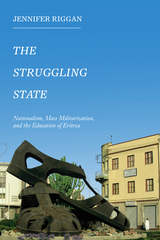 The Struggling State: Nationalism, Mass Militarization, and the Education of Eritrea
Jennifer Riggan
Temple University Press, 2016 A 2003 law in Eritrea—a notoriously closed-off, heavily militarized, and authoritarian country—mandated an additional year of school for all children and stipulated that the classes be held at Sawa, the nation’s military training center. As a result, educational institutions were directly implicated in the making of soldiers, putting Eritrean teachers in the untenable position of having to navigate between their devotion to educating the nation and their discontent with their role in the government program of mass militarization.
In her provocative ethnography, The Struggling State, Jennifer Riggan examines the contradictions of state power as simultaneously oppressive to and enacted by teachers. Riggan, who conducted participant observation with teachers in and out of schools, explores the tenuous hyphen between nation and state under lived conditions of everyday authoritarianism.
The Struggling State shows how the hopes of Eritrean teachers and students for the future of their nation have turned to a hopelessness in which they cannot imagine a future at all.
 Struggling Upward: Worldly Success and the Japanese Novel
Timothy J. Van Compernolle
Harvard University Press Struggling Upward reconsiders the rise and maturation of the modern novel in Japan by connecting the genre to new discourses on ambition and social mobility. Collectively called risshin shusse, these discourses accompanied the spread of industrial capitalism and the emergence of a new nation-state in the archipelago. Drawing primarily on historicist strategies of literary criticism, the book situates the Meiji novel in relation to a range of texts from different culturally demarcated zones: the visual arts, scandal journalism, self-help books, and materials on immigration to the colonies, among others. Timothy J. Van Compernolle connects these Japanese materials to topics of broad theoretical interest within literary and cultural studies, including imperialism, gender, modernity, novel studies, print media, and the public sphere. As the first monograph to link the novel to risshin shusse, Struggling Upward argues that social mobility is the privileged lens through which Meiji novelists explored abstract concepts of national belonging, social hierarchy, and the new space of an industrializing nation.
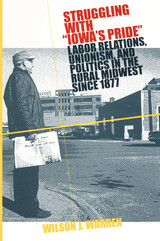 Struggling With Iowas Pride: Labor Relations, Unionism, and Politics in the Rural Midwest since 1877
Warren, Wilson J.
University of Iowa Press, 2000 Recognized between 1880 and 1910 by its trademark label "Iowa's Pride," John Morrell and Company is best known for contributing one of the most important local unions to the progressive United Packinghouse Workers of America. During the 1930s and 1940s, its members pursued a militant brand of unionism. By the early 1950s, the local's militancy became a source of contention among the membership. By explaining the effect of Morrell-Ottumwa's union leaders on local and state Democratic politics, especially in the development of the Congress of Industrial Organizations' Iowa State Industrial Union Council and the AFL-CIO's Iowa Federation of Labor, Wilson Warren makes an important contribution to the literature on labor's involvement in the Democratic party's ascendancy across much of the industrial North following World War II. This history of Ottumwa's meatpacking workers provides insights into the development of several forms of labor relations, including the evangelical Christian paternalism, welfare capitalism, and unionism that were distinctive to one blue-collar community but that also reflected workers' experiences in many other rural midwestern industrial communities. By carefully analyzing all relevant labor and industrial sources and by revealing the deeply held aspirations and concerns expressed by both workers and managers, Warren constructs a window through which Iowa's industrial and labor history over the past 120 years can be viewed.
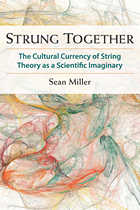 Strung Together: The Cultural Currency of String Theory as a Scientific Imaginary
Sean Miller
University of Michigan Press, 2013 In Strung Together: The Cultural Currency of String Theory as a Scientific Imaginary, Sean Miller examines the cultural currency of string theory, both as part of scientific discourse and beyond it. He demonstrates that the imaginative component of string theory is both integral and indispensable to it as a scientific discourse. While mathematical arguments provide precise prompts for physical intervention in the world, the imaginary that supplements mathematical argument within string theory technical discourse allows theorists to imagine themselves interacting with the cosmos as an abstract space in such a way that strings and branes as phenomena become substantiated and legitimized. And it is precisely this sort of imaginary—which Miller calls a scientific imaginary—duly substantiated and acculturated, that survives the move from string theory technical discourse to popularizations and ultimately to popular and literary discourses. In effect, a string theory imaginary legitimizes the science itself and helps to facilitate a virtual domestication of a cosmos that was heretofore remote, alien, and incomprehensible.
 Struve: Liberal on the Left, 1870-1905
Richard Pipes
Harvard University Press, 1970 More than anyone else in his time, Struve was the master of history, journalism, economics, international relations, and practical politics. A scholar and activist, he helped found the Marxist movement in Russia, initiated Marxist Revisionism there, and launched Lenin's career, and he was the theoretician and a cofounder of the Constitutional Democratic Party.
In writing about Struve, Richard Pipes turns biography into history. He lays bare the split soul of the Russian intellectuals--their irresponsibility, unwillingness to compromise, intolerance. Struve, the liberal turned conservative, preached to his countrymen physical and spiritual freedom based on law. He was a Westerner in his championing of social reform, legality, private property, and a vigorous state and foreign policy. This long and rich tradition of liberal-conservatism is recounted against the background of a "monstrous growth of political claims on the individual that caused intellectual and moral independence increasingly to be punished with ostracism, confinement, exile, and death."
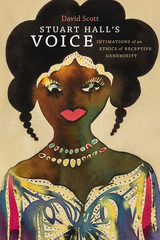 Stuart Hall's Voice: Intimations of an Ethics of Receptive Generosity
David Scott
Duke University Press, 2017 Stuart Hall’s Voice explores the ethos of style that characterized Stuart Hall’s intellectual vocation. David Scott frames the book—which he wrote as a series of letters to Hall in the wake of his death—as an evocation of friendship understood as the moral and intellectual medium in which his dialogical hermeneutic relationship with Hall’s work unfolded. In this respect, the book asks: what do we owe intellectually to the work of those whom we know well, admire, and honor? Reflecting one of the lessons of Hall’s style, the book responds: what we owe should be conceived less in terms of criticism than in terms of listening.
Hall’s intellectual life was animated by voice in literal and extended senses: not only was his voice distinctive in the materiality of its sound, but his thinking and writing were fundamentally shaped by a dialogical and reciprocal practice of speaking and listening. Voice, Scott suggests, is the central axis of the ethos of Hall’s style.
Against the backdrop of the consideration of the voice’s aspects, Scott specifically engages Hall’s relationship to the concepts of "contingency" and "identity," concepts that were dimensions less of a method as such than of an attuned and responsive attitude to the world. This attitude, moreover, constituted an ethical orientation of Hall’s that should be thought of as a special kind of generosity, namely a "receptive generosity," a generosity oriented as much around giving as receiving, as much around listening as speaking.
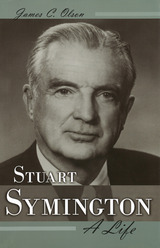 Stuart Symington: A Life
James C. Olson
University of Missouri Press, 2003
Stuart Symington is the first full-length biography of one of Missouri’s most influential and effective twentieth-century political leaders. It tells the story of a remarkable man whose adult life was spent at or near the center of power in America, a man who was talented and ambitious, yet maintained a realistic touch that enabled him to connect with ordinary people.
Symington was the first secretary of the air force and a four-term senator from Missouri. Prior to his long governmental career, he was a successful businessman in New York and St. Louis, developing a national reputation as a genius who could convert failing businesses to profitability. His most notable success was with Emerson Electric Company of St. Louis, which during World War II he turned into a large manufacturer of movable gun turrets for bombers.
Known as “Harry Truman’s Trouble Shooter,” Symington was unanimously confirmed by the Senate for six major presidential appointments—a record. As assistant secretary of war for air, he represented the War Department in negotiations leading to the National Security Act of 1947, which unified the armed services into a single national military establishment under the secretary of defense. During his tenure as secretary of the air force, he steered that organization through a series of crises, including racial integration, as it developed into an independent entity within the Defense Department. Among his other administrative positions, he served as surplus property administrator, breaking up the aluminum monopoly; director of the National Security Resources Board, where he helped develop mobilization strategy for the Korean War; and director of the Reconstruction Finance Corporation, where he reformed a badly managed operation.
Highlights of his long Senate career include his confrontation with Joseph McCarthy during the Army-McCarthy hearings in 1954; his conflict with President Eisenhower over the defense budget; his long, agonizing struggle over Vietnam as he changed from a leading hawk to a leading dove; and his role in uncovering information leading to congressional articles of impeachment against President Nixon. He was a serious candidate for the Democratic nomination for president in 1960, and for a time appeared to be Kennedy’s choice for vice president.
Well written and exhaustively researched, Stuart Symington: A Life provides a comprehensive portrait of Symington and his exceptional career, shedding new light on presidential administrations from Truman to Nixon, the Department of Defense, the Korean War, and Vietnam. The book also contributes to an understanding of the U. S. Senate, the political history of Missouri, and the relationship between business and government during and immediately after World War II.
Stubborn Gal: The True Story of an Undefeated Sled Dog Racer
Dan O'Neill
University of Alaska Press, 2015 Stubborn Gal is the true story of a 60-mile sled dog race and a young woman determined—if not precisely qualified—to run it. Sarah has never competed in a race before and never run a big team of dogs. But when a race official strongly discourages her from entering, she boldly signs up. To answer the naysayers, she must learn how to control a dog team twice as powerful as any she has ever run. And she has three days to do it. Two practice runs end disastrously. On the third day, Sarah enters the race, and the results surprise everyone.
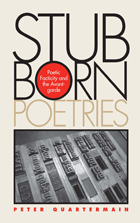 Stubborn Poetries: Poetic Facticity and the Avant-Garde
Peter Quartermain
University of Alabama Press, 2013 Stubborn Poetries is a study of poets whose work, because of its difficulty, apparent obduracy, or simple resistance to conventional explication, remains more-or-less firmly outside the canon. The focus of the essays in Stubborn Poetries by Peter Quartermain is on nonmainstream poets--often unknown, unstudied, and neglected writers whose work bucks preconceived notions of what constitutes the avant-garde. “Canonical Strategies and the Question of Authority: T.S. Eliot and William Carlos Williams” opens the collection and sounds a central theme: Quartermain argues that Williams, especially in his early work, soughtnoncanonical status, in contrast to Eliot, who rapidly identified his work with a literary and critical establishment. As is well known, Eliot attracted early critical and academic attention; Williams did not. Williams’s insistence that the personal and individual constituted his sole authority is echoed again and again in the work of the writers examined in the subsequent essays. In considering the question “What makes the poems the way they are?”most of the essays offer close readings (etymological, social, linguistic, and even political) of linguistically innovative twentieth-century poets. Linguistic innovation, as Marjorie Perloff and many other critics have shown, shows no reverence for national boundaries; two of the poets discussed are British (Basil Bunting and Richard Caddel) and two Canadian (Robin Blaser and Steve McCaffery). The last four essays in the book consider more general topics: the shape and nature of the book, the nature of poetic fact, the performance of the poem (is it possible to read a poem aloud well?), and--closing the book--an excursus (via the Greek myth of Io and the typography of Geofroy Tory) on the alphabet.
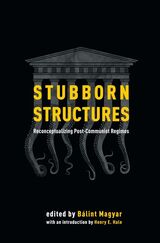 Stubborn Structures: Reconceptualizing Post-Communist Regimes
Henry E. Hale
Central European University Press, 2019 The editor of this book has brought together contributions designed to capture the essence of post-communist politics in East-Central Europe and Eurasia. Rather than on the surface structures of nominal democracies, the nineteen essays focus on the informal, often intentionally hidden, disguised and illicit understandings and arrangements that penetrate formal institutions. These phenomena often escape even the best-trained outside observers, familiar with the concepts of established democracies. Contributors to this book share the view that understanding post-communist politics is best served by a framework that builds from the ground up, proceeding from a fundamental social context. The book aims at facilitating a lexical convergence; in the absence of a robust vocabulary for describing and discussing these often highly complex informal phenomena, the authors wish to advance a new terminology of post-communist regimes. Instead of a finite dictionary, a kind of conceptual cornucopia is offered. The resulting variety reflects a larger harmony of purpose that can significantly expand the understanding the “real politics” of post-communist regimes. Countries analyzed from a variety of aspects, comparatively or as single case studies, include Azerbaijan, Belarus, Georgia, Hungary, Kyrgyzstan, Moldova, Poland, Romania, Russia, and Ukraine.
|
|
